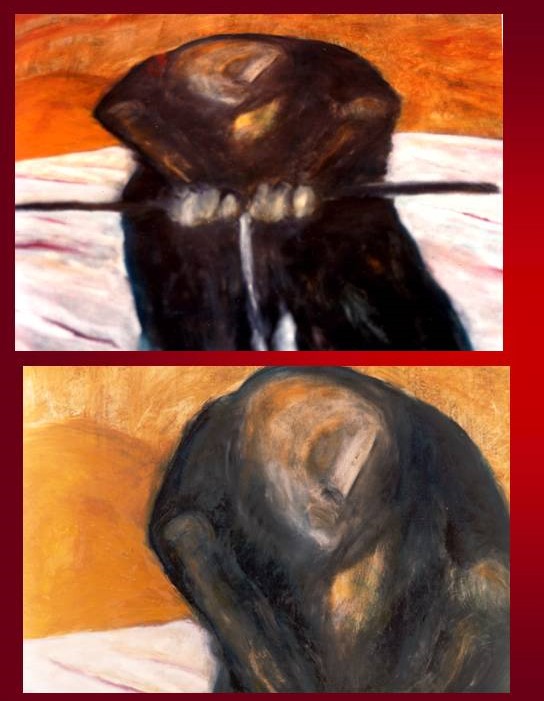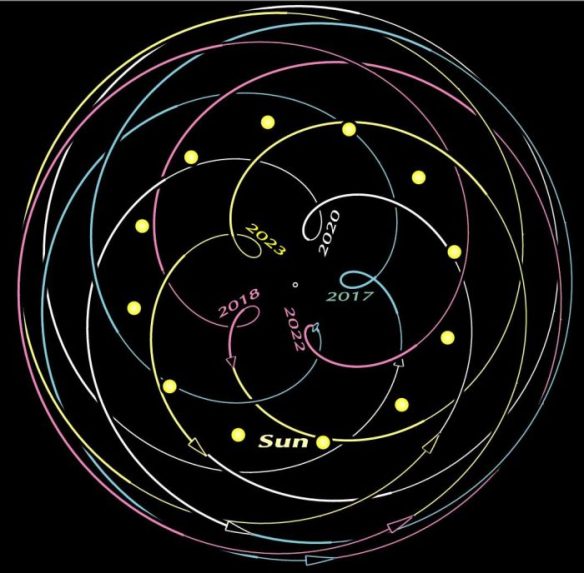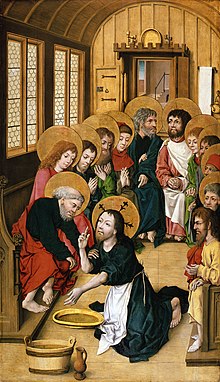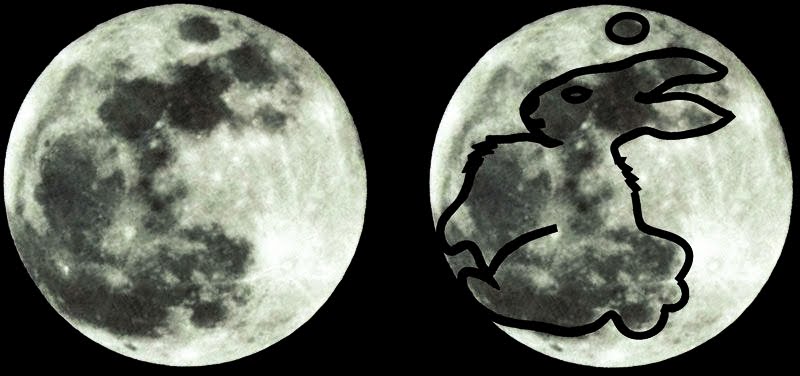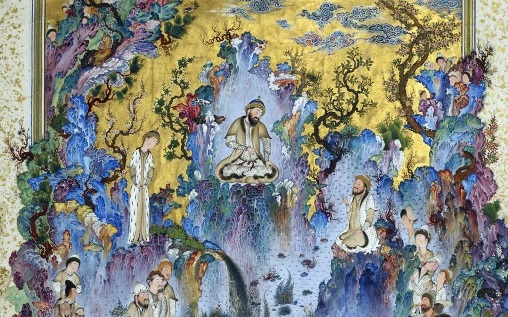Passover is the Passing By Feast
On the Origin of Easter
The modern English term Easter, cognate with modern Dutch ooster and German Ostern, developed from an Old English word that usually appears in the form Ēastrun, -on, or -an; but also as Ēastru, -o; and Ēastre or Ēostre. Bede provides the only documentary source for the etymology of the word, in his eigth-century The Reckoning of Time. He wrote that Ēosturmōnaþ (Old English ‘Month of Ēostre’, translated in Bede’s time as “Paschal month”) was an English month, corresponding to April, which he says “was once called after a goddess of theirs named Ēostre, in whose honour feasts were celebrated in that month”.In Latin and Greek, the Christian celebration was, and still is, called Pascha (Greek: Πάσχα), a word derived from Aramaic פסחא (Paskha), cognate to Hebrew פֶּסַח (Pesach). The word originally denoted the Jewish festival known in English as Passover, commemorating the Jewish Exodus from slavery in Egypt.[ As early as the 50s of the 1st century, Paul the Apostle, writing from Ephesus to the Christians in Corinth,] applied the term to Christ, and it is unlikely that the Ephesian and Corinthian Christians were the first to hear Exodus 12 interpreted as speaking about the death of Jesus, not just about the Jewish Passover ritual. In most languages, Germanic languages such as English being exceptions, the feast is known by names derived from Greek and Latin Pascha.[4][34] Pascha is also a name by which Jesus himself is remembered in the Orthodox Church, especially in connection with his resurrection and with the season of its celebration.
Pesaḥ which would be derived from the verb pasaḣ which means “to go ahead, to spare”, “passing by” because, according to the Bible, the Israelites had been ordered to sacrifice a lamb unscathed from any blemish and to brush the blood on the uprights of the doors so that the evil powers which would come to destroy the first born Egyptians during the tenth plague, pass above these doors without stopping. Every year Jews commemorate this event on the feast of Passover. The Passion of Christ having taken place, according to the Gospels, during these celebrations, Christianity invested this feast and its symbolism, Christ becoming the lamb slain to save humanity from its sins.
The undeniable truth is that for Christianity Jesus is the personification of the central sun of our solar system. Perceived from the northern hemisphere, and particularly from between the latitudes of the Tropic of Cancer and the Arctic Circle, the celestial arc-shape path of our Light Bringer becomes in the fall each day a little smaller. But on (about) December 21, this daily shrinkage comes to stand still. In other words, the daily changing in the size of the Risen Savior’s arc has then stopped, or “died”. However, after three natural days, in which the nights lasted the longest of the year, this heavenly motion comes back to life again, starting with the sunrise on December 25. We celebrate this annual rebirth of Jesus with the Light Feast as a continuation of the Germanic Midwinter Festival.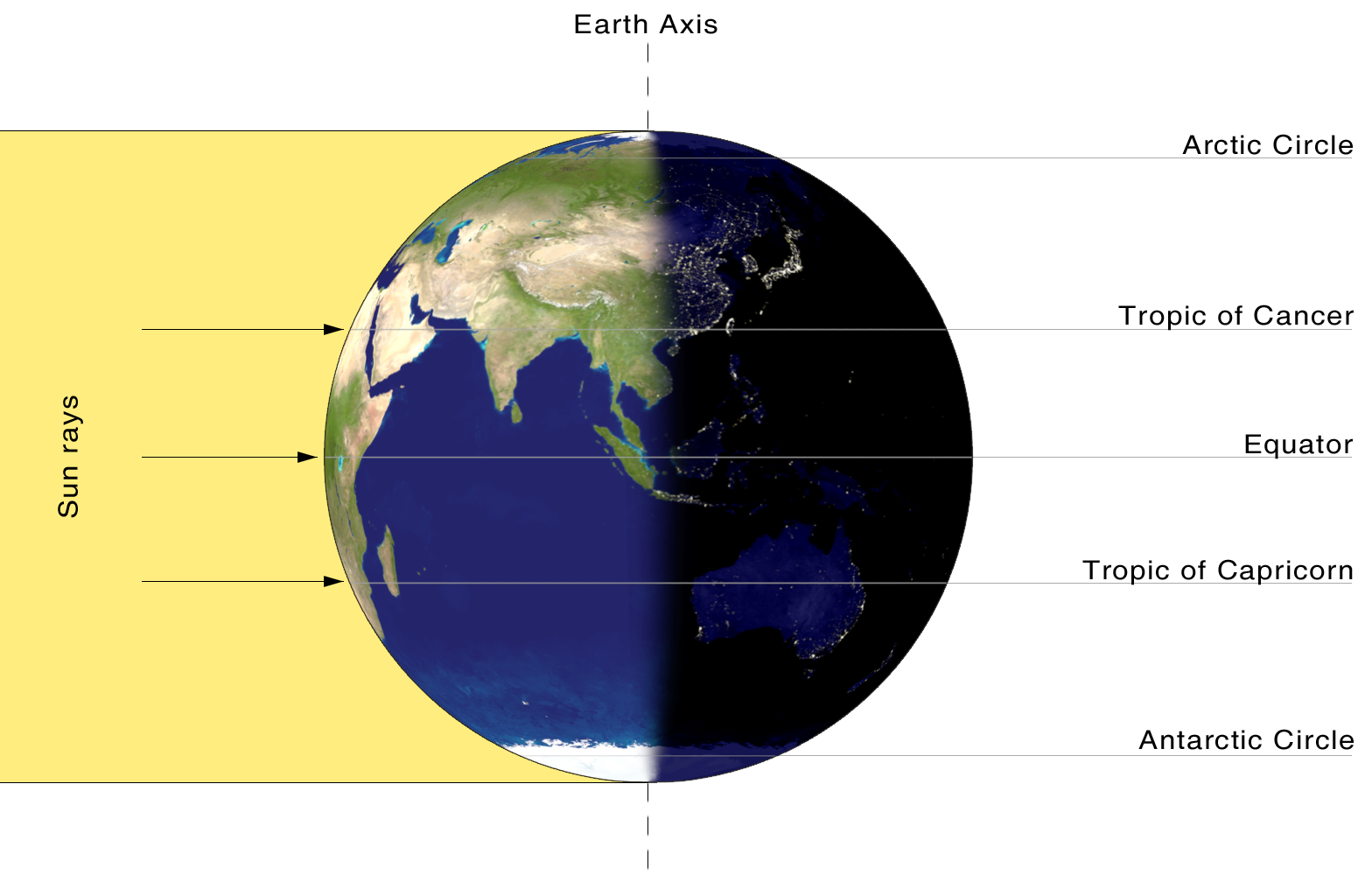
As the Roman deceivers want this to be hidden from the uninitiated, they moved Jesus’ day of death from December 21st to “Good Friday”, that is, the Friday before Easter, which is today. Furthermore, they changed the meaning of this Passover to the resurrection of the Savior, which in reality occurs every year on December 25th.
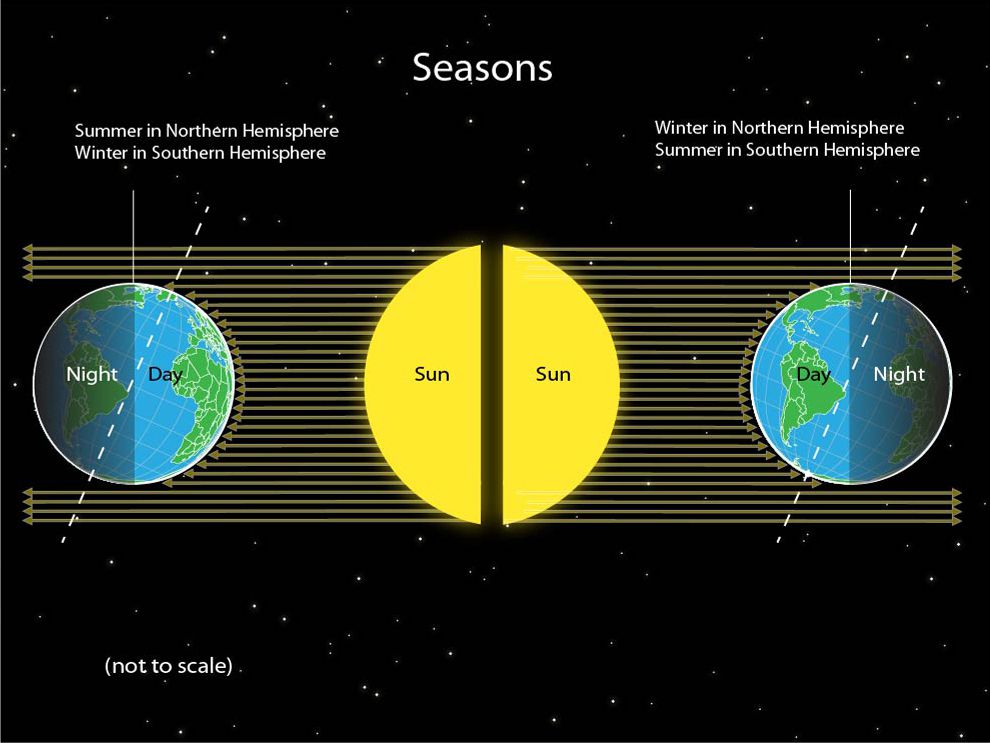
Just like Christmas, also the Passover is originally a Germanic feast. As we celebrate during the Midwinter Feast our survival of the year’s darkest part, we celebrate during the Eostre Festival the fact that within a natural day the day time period has again become longer than the night time period. In other words, the light of the day has again overtaken or passed by the darkness of the night. The official version of the origin of the name “Passover” tries to fool us by pointing to the Hebrew word “Pesach”, but that is like putting the world upside down. In reality, the name “Passover” originates from the old Germanic verb for ‘passing by’. Somehow ‘passing by’ and ‘taking over’ merged into “Passover”. Another myth is that the name “Easter” is referring to the East. This is nonsense, as it is derived from the Old English “Eostre”. Actually, it is all quite straightforward, only by examining these names.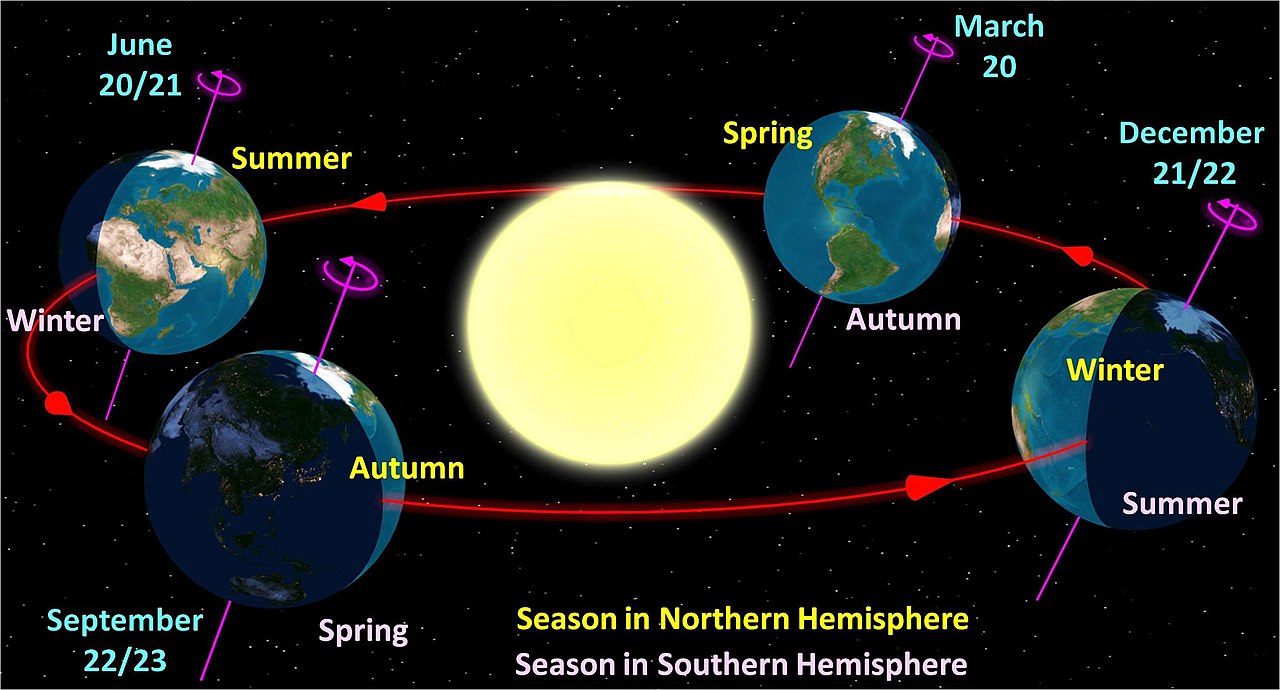
This (long) weekend, we celebrate the fact that the daily lighter period has taken over or passed by the nightly darker period. In other words, the entire period of natural day is again ruled by Light, and no longer by Darkness. We can also examine the way we still use the verb ‘pass’ in our contemporary language. For instance, we pass a deed. After this deed is passed, the previous owner passed it on to the following one. Similarly, we also pass a ball from the previous player to the next in various ball sports.
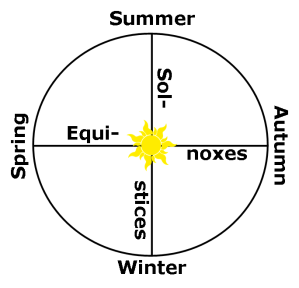 When we imagine a full year as a circle, then the straight lines that connect the starting points of opposing seasons form a cross within that circle. This is the true Cross of Jesus, as shown in the figure on the right-hand side. Opposite to the beginning of winter on (about) December 21st lies on this circle the beginning of summer on (about) June 21st. These two points are called ‘solstices’ from solstitium in Latin, literally meaning ‘solar standstill’. However, it is not the standing still of the Light Bringer, but the standstill of the daily growing (or shrinking) of its arc-like path. Likewise, opposite to the beginning of spring on (about) March 21st lies on this circle the beginning of autumn on (about) September 23rd. These two points are called equinoxes from aequinoctium in Latin, literally meaning ‘night getting even’ (with day). On these two days a year, the nocturnal darker period and the diurnal lighter period indeed get even.
When we imagine a full year as a circle, then the straight lines that connect the starting points of opposing seasons form a cross within that circle. This is the true Cross of Jesus, as shown in the figure on the right-hand side. Opposite to the beginning of winter on (about) December 21st lies on this circle the beginning of summer on (about) June 21st. These two points are called ‘solstices’ from solstitium in Latin, literally meaning ‘solar standstill’. However, it is not the standing still of the Light Bringer, but the standstill of the daily growing (or shrinking) of its arc-like path. Likewise, opposite to the beginning of spring on (about) March 21st lies on this circle the beginning of autumn on (about) September 23rd. These two points are called equinoxes from aequinoctium in Latin, literally meaning ‘night getting even’ (with day). On these two days a year, the nocturnal darker period and the diurnal lighter period indeed get even.
Furthermore, in case you want to learn more about the original Germanic holidays, then study the Germanic Moon Calendar.
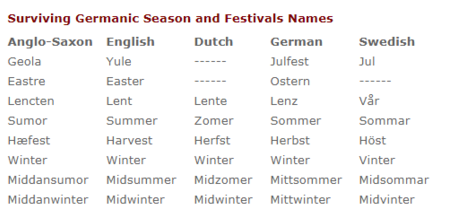
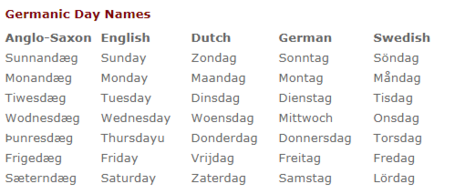
- Passover, also called Pesach – Migration( “Passing by” )fom mental or spritualSlavery
In the Tanakh, Passover marks the Exodus of the Children of Israel from Egyptian slavery, when God “passed over” the houses of the Israelites during the last of the ten plagues. When the Temple in Jerusalem stood, the paschal lamb was offered and eaten on Passover eve, while the wave offering of barley was offered on the second day of the festival. Nowadays, in addition to the biblical prohibition of owning leavened foods for the duration of the holiday, the Passover seder is one of the most widely observed rituals in Judaism.
- SHIR HA-MA’A LOT “Songs of Ascent”
These psalms were sung by pilgrims who went to Jerusalem on the occasion of the 3 great annual festivals of Passover: the Easter feast in spring, Shavuot: the harvest feast in early summer and Sukkot: the feast of the tabernacles, in autumn.
Many of these rituals or liturgies are often based on older models of “agricultural worship” in which the changing of the seasons plays an important role. Following the movement of the sun, man recognizes his dependence on nature and when the sun sets in winter, he performs various rituals to ensure that the sun in spring will be beneficial for him to grow his crops again. The schedule that can be found all over the world is as follows:
a male god (father) and a female god (mother)
– thunder, rain, sun – – the earth, rivers, moon
– -the above waters- -the below waters
– – the heavens – – the abyss –
brings forth the crop: God’s Child
The god’s child, born in the early spring, grows, ripens in the summer, withers, and is cut in the late fall. The seed of the old crop (the young child has become an old man) is buried in mother earth in the winter so that her womb will be a new crop, or god’s child can give birth for the next new year.
The myth hidden here is that the young child grows up, becomes an adult, and in that sense is compared to the father.
He then even suppresses the original father god, becomes the new lover or husband himself of (his) mother earth.
That is why this “father god” is often presented as two persons in one, that is, as old and young at the same time: “the old of days” is “the young son” at the same time.
They complement or form two different facets of the divine person.
With the autumn equinoxe and the winter solstice the old god-father must die, be buried in mother earth where he then undertakes a journey into the dead worlds or hells, and then risen from the dead as a reborn young and powerful “son”, usher in the arrival of the new spring and ‘sunny’ prosperity
Prof. Houck Borsch in his book “the royal rites” concludes that within these very old models of ritual “worship” five main elements are recurring: Despite the different variations, these elements are refined and expanded according to the natural environments and social constructions (differences in materials or in the leadership such as a high priest, a king or a chieftain). What always emerges is a great dynamic in which a new impulse within the same model is brought about by the protagonist in order to assure his followers of a “good harvest” or. a safe future:
1- The all-important cultic period for the king and his society came at the time of the chief annual festival. Usually taking place at one of the equinoxes (apparently regulated both by the position of the sun and with regard for the times of the fructifying rains. Whether the stress fell on the spring or autumn equinox seems to have had much to do with local agricultural and seasonal patterns. Choosing the correct day was obviously of great importance , and it is probable that astral calculations and mythology played a more sigini-ficant role than we now realize. Both the heavenly royal Man and his frequent bull (or animal) companion (or enemy) could be seen among the stars. This might be one of the contributions to the several links which exist between Mesopotamian astral imagery and that of later gnostic-type religions)
This festival was concerned with establishing good omens, giving promise of beneficial agricultural conditions, and with presiding a social and cosmological harmony between the. people and their ruler and between the ruler, representative of all the people, and the god or gods. The festival was seen as a re-creation of the world. The powers of nature had been decaying, relapsing again toward chaos over the course of the year. The cycle had run its limit, and, if the natural order were to go on, the forces of chaos and death had to be defeated anew. During the days of the festival the creation story was therefore either ritually enacted or, at the least, ceremonially read. For these reasons the festival can be described, as it often was, as the festival of the New Year or the feast of the end or turning of the year.
The central figure was the king; he was both chief actor and priest. Not only did he function as the representative of the people and their intermediary with the divine, but he could assume for certain designated parts of the drama the role of the king-god. ‘What happens to the king symbolizes what has happened to the god.’

The stage was cosmic; distinctions between earth and heaven were temporarily suspended. The king and the king-god could, representationally, be one, their attributes confused. The human king, if not strictly regarded as a divinity for these purposes became a sacred personage. ‘In certain respects a union of divine and human takes place in his representative person. Possibly this could be viewed as a kind of incarnation of the god, but this seems neither the intent nor the interest of the rites and myths. It is not so much that the divine has come to earth to be represented by a mortal man, as that the king-man has become a divine being and can represent the king-god to his people.
Nevertheless it is, we believe, just this cultic tendency to fuse roles which enabled the king-gods in mythical legends to share many of the characteristics of the earthly king, the king who is a figure of the First Man. The king-god can thus be described as a king or First Man now in heaven, though he often still plays a part in the lists of earthly kings of primordial times. So also to the earthly king, who is the son of the king-god, there are attributed qualities of the one who reigns in heaven.

2-As the chief actor and in the role of the king-god the king must fight the creation battle against the primeval forces of darkness, evil and chaos. These powers are often represented as beasts or a chaos monster. In historified forms the enemies can be seen as foreign kings or peoples intent on overthrowing the society. It may be that versions of the myth which were agriculturally oriented have supplied the picture of chaos in terms of water and flood, while those which centred upon the conception of the king-god as a solar deity conceived of evil as the power of darkness. None the less, if this distinction be accurate, the variants have a common point in that the sun was often believed to set into the sea from out of which it must rise the next day.
In this struggle the king is at first defeated. He is near to drowing (in the subterranean waters or river which threaten to engulf and return the earth to chaos), and/or he goes down into the earth to a place of darkness and death. He suffers and is totally humiliated; he becomes a figure of contempt, even of ridicule. His royal regalia has been stripped away. He may actually have been struck and beaten, even immersed or put into a pit.
Often this suffering was interpreted as a result of his sin, though at times he is seen to suffer as an innocent victim.
Note :It is sometimes held that clear distinctions must be kept between various kinds of suffering undergone by royal figures:
- a suffering in ritual or mythical battle;
- suffering which comes upon an innocent figure;
- a suffering which is penitential (often imposed by God) and accepted as the result of sin. Though the emphases are various and some sort of categorization is always possible, it is our belief that these forms of suffering, in so far as they do relate to the leader of the society, represent three ways of viewing the same ancient theme.
Description and imagery often reveal that the suffering (at the hands of demons, beasts, evil forces or foreigners, in water, at the creation, that is horribly disfiguring, etc.) derives from stories about the suffering of the first king. Whether he is an innocent or a penitent depends on the particular standpoint and the version of the story which is being employed, though it is not uncommon to find the two ideas side by side in stories about both kings and first men. So, e.g., Ps. 69.4f. (and note that, whereas in v. 4 the suffering is caused by others, in v. 26 it is said to come from God). There seems a sense in which by confession of wrongs and humble submission (or through a very great deal of suffering) the figure becomes a kind of acquitted or innocent sufferer.
If he is a sinner, his great crime consisted in a lack of humility. Odd though it at first seems, he was accused of trying to make himself into a deity. Yet he is subject to all the pangs of mortality, and the gods are punishing him.
He, of course, is deposed and ceases to be a king. In his woe and tribulation the king makes confession of sin and/or pleas of innocence. He performs acts of humility. He calls out for help to the god and cries for salvation. Probably various sacrifices were made at this juncture.
3-His cries are heard. He is saved and is raised up, or., in some forms, the stress fails on the idea that he himself is empowered to rise. Through the partaking of the sacred water and/or food his powers revive in him. He may now be given some of the appurtenances of his kingship; thus armed, he overcomes the powers of evil and chaos, a victory in which both king and people share. Out of the body of the slain chaos monster the new creation is made.( In a few presentations it would seem that the world was made from the body of the primordial king-god who had been killed in the battle. He was the dead ruler, while now the new king was raised up to rule in his stead. Behind this understanding there lies a myth of the battle of the seasons)
It was probably at this moment that divine oracles were interpreted; the destinies for the new year were set.
An oracle was read proclaiming the favour of the god toward the king. He is seen as absolved, cleansed. He is born, arises and is pronounced the divine son, the rightful claimant to the throne. He becomes the adopted son or representative of the god, the true king. The defeated enemies are led in triumphal procession. The king ascends to a high mountain, symbolically to heaven.

4-There follows the enthronement of the king, emulating the enthronement of the king-god in heaven. (Usually this was, of course, performed in the temple of the city-state either built like or actually set upon a mountain or hill. It would appear, however, that at times the enthronement might have taken place in a ritual hut, a hut which was constructed both as a symbol of the order of the new creation and as a replica of the god’s heavenly temple. This has affected later interpretations of the function of the temple.) The king is anointed. The holy garment is put on him together with the crown and other royal regalia. He is said to be radiant, to shine like the sun just as does the king-god. He is initiated into heavenly secrets and given wisdom. He is permitted to sit upon the throne, often regarded as the very throne of the god. He rules and judges; all enemies are subservient. All do him obeisance.

5-The final stage is one of great rejoicing. In several cultures the king now consummated the sacred marriage with a woman who was herself regarded as a representative of the goddess, wife of the kinggod. This union not only demonstrated who the king was, but it was a mimetic act, intended to signal and encourage the reproductive processes of the world of nature.
All would be well with the society. Once more the people share in the drama of their king, now in its happy conclusion. Feasting ensues. The king fulfils his role as the great provider, giving to his people gifts of food and drink like those of which he had partaken. Mythically it is the food of paradise, for now he rules in paradise next to the tree of life and beside the river of life which is peaceful and ordered again and over which he exercises control. All nature is his dominion. It is the beginning of creation all over again, and the king is the First Man and ruler restored, the father of his people. The cycle is ready to repeat itself.
If we take a closer look at these 5 main elements against the background of the themes used in the Old and New Testaments, we see that these kings ‘rituals of kings’ drama of the New Year celebration are constantly reviving. It seems as if the primal myth of the creation of the world by Man as a mirror image of God are relived every time by the protagonist (prophet, king or priest) as an example of the first Man, Man-Son, servant or Messiah on behalf of his fellow man or. society. This re-experience, memory or rather “remembrance” (in the sense of bringing together the loose (lost) limbs, as in the myth of Isis and Osiris) serves as a dynamic or force to remove the old dead parts, fuse back together and breathe new life into solving a particular problem within a particular environment and for a specified time. When Israel installs itself in the Promised Land, the myth is transformed, the demons have become Israel’s enemies, “Adonai” becomes greater than the other local gods and thus the people can secure their future. On one side, Adonai takes on an all-powerful king character while Man has become a servant or innocent suffering. The myth is becoming more democratic and the reliving of the primal ritual is always pushed back into the future. The actualization of the royal drama with its self-sacrifice is seen as a hope, hope in the eschatological times when the enemies and demons will be finally destroyed. Visions of the “new city of peace” are experienced by many (see the various apocryphs and apocalypse). These experiences often serve as warnings to the people, sometimes they offer them a new élan (in the form of new movements, gnostic sects, etc …) until the time comes when visions are no longer experienced and there is waiting for the arrival of the final judgment . Hereby the conclusions of Aage Bentzen in his book “King and Messiah” (pg.73-80):
-The eschatologizing and renaissance of the myth:
We saw that the Israelite king must be understood as a Saviour, actually present in the people assembled in the Sanctuary to repeat and “re-live” the great fundamental events of God’s victory over the Powers of Evil.
The king is a present “Messiah”, no eschatological figure, but the sanctified, anointed, messenger of God. He guarantees the happiness of Israel in the New Year, inaugurated through the “remembrance” of God’s saving acts of Creation. The “Messiah” of early Israel was not an “eschatological” figure, but the incarnation of God’s blessing according to His covenant with Israel. But he did not remain so.
In the second volume of his Psatmenstudien, Mowinckel has shown that the historical experiences through which Israel had to pass led to “Eschatology”.’ Israel passed “from Experience to Hope”. The realities of history did not confirm the faith, nourished by the experiences of the Enthronement Festival, that Israel’s happiness was secured through the presence of the Anointed of Yahweh. The fall of both Israelite kingdoms in 721 and 587 necessarily made this discrepancy between faith and facts very keenly felt.
Such is the background of the origin of “Eschatology”. Deutero-lsaiah worked in the faith and expectation of a “New” world-age, with a “New Myth”. The Messianic bliss is not of this world; it will come with the New Creation. New Creation is no longer connected with regularly returning days of the calendar. The festival no longer preaches “Salvation is here!” Rather, it keeps expectation alive-“Salvation will come! And it is very near.”
The rise of Eschatology carries with it a new interpretation of the Enthronement Psalms. The Anointed of Yahweh is no longer a present figure. He is the coming king. This expectation is pre-exilic. Already before the exile, in the Royal Psalms of Isaiah 9, 11, and Micah 5, we find an “eschatologizing” of Royal PsaIms. The eschatologizing of Psalm 2 is encountered also in the dream-vision of Daniel 7. This prophetic “dream”, in all its main features, follows the pattern of the psalm. First, we see the four terrible monsters rising out of the Sea. They correspond to the “kings of the earth” in the psalm, the instigators of the revolution against Yahweh and his Anointed.
That the animals rise from the “Sea” and not, as in the psalm, from the “Earth”, is irrelevant. The “Sea” and the “Earth” are symbols of the same idea, the powers hostile to God, the “Chaos”. Nevertheless, this change of expression has some significance. The “kings of the earth” in the psalm were characterized as being only terrestrial. That the eschatological monsters come from the sea expresses their demonic character more strongly. The vision of the apocalyptist is more “mythological” than the psalm, not only by mentioning the “Sea”, the great Enemy of the Creator, but also in describing the “kings of the earth” as horrible monsters. The psalm is probably influenced by the tendency to that “historification” which was peculiar to Israel. In Daniel’s dream, we observe what we may call the Renaissance of mythology in later Judaism. While the anti-Canaanite reaction of pre-exilic days led to a “de-mythologizing” of the “Messiah” and of the Creation festival, later Judaism seems to have accepted this material again to a great extent. It had now passed through the purgatory of Israel’s history.
Monotheism was now so firmly rooted that mythology could not imperil Israel’s religion. Therefore, in this respect the dream of Daniel is more “antique” than the psalm, the pattern of which is the pattern of the dream.
As in the psalm, the noisy upheaval of the Human Empires, represented by the fabulous animals, is contrasted with a picture of sublime calmness. “The Ancient of Days” judges the monsters. As the culmination of the revelation, there appears the “Son of Man”, the incarnation of the Kingdom of God. This corresponds to the proclamation of the king in Psalm 2. That the Son of Man is described as identical with the kingdom of God, with God’s people, is no matter of difficulty. The Royal Messiah of the ancient cult was also identical with God’s people, and in writings which take no special interest in the personal Messiah, but concentrate on the kingdom of God, this feature tends to vanish into the background. To the people of God, described as the Son of Man, world dominion is given that God may reign for eternity. The animals are annihilated. The judgment, still only a possibility in the psalm, is now seen as executed. As I have said in my commentary on Daniel, the vision of chapter 7 is an eschatologized representation of the ancient Enthronement Festival. It has been influenced by the idea of world periods, peculiar to eschatology proper. It culminates in the taking over of world dominion by the jewish people, represented by the figure of the “Son of Man”. Later Jewish theologians (and the ecclesiastical exegetes who followed them) had no idea of the real, original meaning of the “cultic pattern” of the Near East. The result of the anti-Canaanite reaction of Israel was that it could be used without detriment to new religion, as a description of the Age to Come. The later eschatological “Messianic” interpretation, which in many respects rests on typology, is to a great extent a return in refined forms to the conception of the king as identical with the Son of God, in Canaan with Ba’al himself. For the sake of refinement, Ba’al had to be expelled from Israel’s world of thought, but the idea that the Saviour was not only of Israel, but also from “Heaven”, from the Higher World, the World of Divinity, “the durative world” , had been outlined by the Ancient East. In Israel, the idea was preserved by borrowing the notion of adoption, also found, e.g. in Mesopotamia. The New Testament again speaks of a Prince “born of a woman”, but also “ante omnia saecula”, and so it is linked up with the king mythology of the Ancient East.
The Second Psalm cannot be interpreted as dealing directly with Jesus the Christ, but its conception of the Messiah, as an “eschatologizing” of the Saviour of the ancient rituals, certainly establishes a close connection between the psalm and the “Fulfilment”. When we speak of “Fulfilment”, we are using as we said before-an interpretation of faith. But to draw the “Messianic Line”, as we have attempted here, is to furnish this interpretation of faith with a very valuable foundation in the phenomenology of religion. The King Messiah of Psalm 2 is a “prefiguration”, a typos, of the eschatological Messiah, of the Son of Man in later judaism and the New Testament.
That the Son of Man, Primeval Man, and Messiah have common roots has been said before. In this way, the “Anointed” of Psalm 2 becomes a “prefiguration” of the Christ of the Church But this process was not completed without important additions.
In this interpretation of the Messiah of the Psalms, what is called by Engnell the “Aspect of Suffering” was preeminently drawn into the foreground. Isaiah 53 acquired a decisive importance. But we have seen that this chapter, too, had its lines of connection with the ancient ideology of the Primeval Man and King.
The fulfilment assumes features which had been rejected by the anti-Canaaite reaction of Israel. Even the idea of death and resurrection of the divine saviour has been placed in the centre of the New Testament world of thought, while the Old Testament type (Isaiah 53) had expurgated the divine features completely. The expurgation had been a sort of disintegration of the original pattern. The fulfilment re-integrates the lost but necessary range of ideas to suggest that humanity alone cannot save humanity. The Saviour must come from Above.
This thought had been lost through the reaction against “heathenism”; but the “heathen” truth had to be recovered. Thus it is that religio-historical research serves theology. I had almost said that the history of religions and the interpretation of faith confirm one another. Nevertheless, one must not slur over the difference between Prefiguration and Fulfilment. It is an inherent principle of typology that the Antitype is always greater, and often in opposition to, the Type.
For example, Psalm 2, as it stands, is the expression of a totalitarian political claim which must be rejected in favour of the pure totalitarian claims of the Kingdom of God. Regenerated on the higher level of the Gospel, the political totalitarian claim of the psalm can be regarded as a “presentiment” of the conviction that only under the rule of the Son, sent by God, the homoousios to patri, can there be security for the nations of this world. We have seen that the conception of the Messiah is presented to us in three forms with common roots-three aspects of a totality which in different ages have been accentuated in different ways. First, we described the Royal Messiah of the Ancient Nations and of pre-exilic Israel, as he is presented by the Royal Psalms. He is the fighter in the ritual combat of the Creation Drama, the Bearer of Salvation, present in full actuality in the “reliving” of the saving facts in the New Year Festival. He has suffered the vicissitudes of the combat, but is now able to proclaim the victory of God. Secondly, we considered the Moses redivivus, described as the Prophet of the Exile who, in the shape of the Innocent Sufferer, secures the Salvation of the people. And finally, we considered the Heavenly Son of Man, as the impersonation of the Kingdom of God in the Book of Daniel.
These types, however, are not successive phases in a history, in which they appear one after another as absolute nova. They all have features common to what we call “king ideology”. In the first type, we meet the Victor; in the second, the Suffering Servant; and in the third, the transcendence of the Son of Man is accentuated. We have seen that we ought perhaps to regard the idea of “First Man” (rather than the king ideology) as the connecting element between the three types. The First King and the First Prophet are both “aspects” of the same type, the Saviour and First Ancestor, the Patriarch, conceived differently, with different emphases on the various elements in different circles. The final picture, the Son of Man, seems to give the best expression of the entire type. Different ages accentuated different aspects: the ancient age, the king; the school of Deutero-lsaiah, the suffering First Prophet. That the latter is described as Moses redivivus is due to several factors, but, above all, to historical circumstances. Israel was living in a time which was analogous to the Exodus-situation, and when, in prophetic and deuteronomistic circles, Moses had become the normative type of a prophet. The strong transcendence of the Son of Man is also traceable to the circumstances of the time. The Hellenistic period had strongly transcendentalized the idea of God. Accordingly, the Divine King had to follow the lead. The Book of Daniel stresses the sole activity of God in Salvation, and so the heavenly and not the “individual” character of the Saviour is emphasized. But all three types of the Saviour have common roots. If we wish to speak of “evolution” in this connection, we should have to mean a process which, through the centuries, alternately brings to the fore different components of the type as dominating features in the picture of the Messiah. Whether that can properly be called “evolution”, I leave to the biologists. These different components are all present in the Psalm Literature.
This literature was our starting point, since king ideology and everything else (including the First Man ideology) is present there. The expression “Son of Man” has been found in the Psalms, as well as the theology of Suffering. Here the central position of the Psalms in the literature of the Old Testament becomes obvious. An Old Testament Theology could very appropriately start with a description of the religion of the Psalter.
Further, we must stress that the roots of the Messianic ideas are found outside the Old Testament. The theological consequences of this must be taken into account by students of Dogmatics and Ethics more positively than, I think, is commonly done. Of course, the differences between the king ideology and Messianism of the Ancient East and that of the Old Testament will have to be fully appreciated. In this connection, the position taken about the question of “Mythology” which reveals itself in different ages is important. In the period of the Israelite Monarchy, we encounter, in the anti-Canaanite reaction, a tendency towards “de-mythologizing”. The death of the Divine King is not accepted as an “article of faith” in Israel, but expressions originating in this circle of ideas have been retained in cultic poetry. Even the idea of the divinity of kings was taken over, but it was adapted to Israelite conceptions. The notion of Divine Sonship by adoption, known from Mesopotamia, was probably the form in which divine kingship could be tolerated. Later, in DeuteroIsaiah, every trace of it vanished. However, in later Judaism and in the Early Church we observe a “renaissance of mythology”. The ancient conceptions of the Divine King were used as material in Christian circles for the development of a Christology as early as the New Testament.
Here the role played by the “aspect of suffering” from Isaiah 53, which is combined with the figure of the Son of Man, is of first importance. The result is that Jesus re-unites all aspects of the idea of Primeval Man and Primeval King in His own person, and so the entire mythology of the Ancient East is reinstated. Systematic Theology must learn from both these currents. It is necessary to appreciate both the criticism springing from the anti-Canaanite reaction and also the positive attitude of the mythological renaissance in later Judaism and the Early Church. We may conclude with some final observations concerning this “renaissance of mythology”. We have said that Israel travelled the road “from experience to hope”.
The present Messiah was changed into the eschatological Messiah under the pressure of the realities of history – the defeats, decline and fall of the kingdom and of the nation as an independent political entity. But we find still another change, when we pursue the line further into the Church and its world of faith. The Kingdom of God in the preaching of the Gospel is not only, as in Judaism, the Coming Kingdom.
In certain words of Jesus, and in the sacramental conception of the New Testament as a whole, the kingdom is present in Jesus himself, both in his historical appearance and in his Body the Church. It is this “hodie” which is so impressively stressed by Danielou and characterized as the specifically Christian idea in eschatology.
This means that, with Christ and His Church, the idea of the present Messiah has returned and again become a vital force in religion. We find also a “renaissance” of the ideology in the ancient cult. In the Church, in the Corpus Christi, the King and Saviour is really present-as expressed in the communion hymn. In the cultic experience of the Church, both in the Roman Mass and the Protestant service, as also in the preaching and in the individual reading of the Bible, the Messiah is present, bringing with him Salvation from God.
A significant historical cycle was completed when the ideology of ancient rituals was utilized by the first Christians to express their meeting with Jesus of Nazareth and the effects on them of His personality. It was this which created the “New Myth” visualized by Deutero-lsaiah, now the “antitype” of the “types” in the Old Testament, the Exodus from Egypt and from Babylon. As god-in-person this Jesus lived the life of goodness and self-offering which no other was able to do. Though it was only our sin and his mercy which made it necessary, he earned the right to be our sovereign Lord and to command the allegiance of our hearts in love. In the language of this day, he is truly the Man for others.

Send your light and your faithfulness, they will guide me,
They may lead me to your holy mountain, to your dwelling ”(Ps 43,3)
See also
 Song of Ascents is a title given to fifteen of the Psalms, 120–134 (119–133 in the Septuagint and the Vulgate), each starting with the superscription Shir Hama’aloth (Hebrew: שִׁיר המַעֲלוֹת , meaning “Song of the Ascents”). They are
Song of Ascents is a title given to fifteen of the Psalms, 120–134 (119–133 in the Septuagint and the Vulgate), each starting with the superscription Shir Hama’aloth (Hebrew: שִׁיר המַעֲלוֹת , meaning “Song of the Ascents”). They are
also variously called Gradual Psalms, Songs of Degrees, Songs of Steps or Pilgrim Songs.

See Research: Offerliederen Offerliederen tot de fonkelende hoogten

- Resurrection and the Feminine Divine
The Christian holiday of Easter is the archetypal summit of the year, where rebirth and
resurrection are venerated in the mystery of Jesus Christ’s awakening from the tomb. In Christian orthodoxy, Easter is known as pascha, the Greek and Latin term referring to the Jewish Passover.
The Apostle Paul uses this word as a title for Christ, “For Christ our Passover lamb [pascha], has been sacrificed” (1 Cor. 5.7). By the end of the first century CE early Christians had reinterpreted the Exodus story and the Passover ritual as a prototype for the sacrifice of Christ.
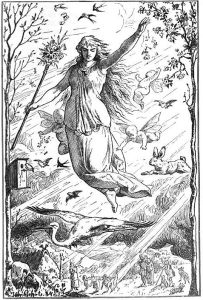 The word “Easter” itself, however, is Old English, from Eastre or Eostre, a title derived from an old English month now known as April. Christian Easter is celebrated on the first Sabbath after the first full moon after the spring equinox. This holy-specific day most often occurs in April and is representative of the most fertile time of the year, when sun, moon, and earth are all in their phases of rebirth and awakening. Easter is therefore the day of resurrection, in heaven and on earth. And this heaven-earth relationship is only an archetypal symbol for the heaven-earth awakening that occurs in the soul of God, or in the spirit and breath of each mortal man and woman. In Christian rite and belief, every soul will arise like the sun, moon, and earth, to a new immortal dwelling.
The word “Easter” itself, however, is Old English, from Eastre or Eostre, a title derived from an old English month now known as April. Christian Easter is celebrated on the first Sabbath after the first full moon after the spring equinox. This holy-specific day most often occurs in April and is representative of the most fertile time of the year, when sun, moon, and earth are all in their phases of rebirth and awakening. Easter is therefore the day of resurrection, in heaven and on earth. And this heaven-earth relationship is only an archetypal symbol for the heaven-earth awakening that occurs in the soul of God, or in the spirit and breath of each mortal man and woman. In Christian rite and belief, every soul will arise like the sun, moon, and earth, to a new immortal dwelling.
Despite this traditional context, historically, Easter had feminine roots. Significantly, the old English month of Eostre was itself named after a goddess whose rites of rebirth were celebrated at the same time among the early inhabitants of Britain and Northern Europe. Eostre was a Germanic goddess whose name is cognate with the Proto-Germanic austrôn, meaning dawn or to shine. This deity belongs to a long line of female divinities who are goddesses of the dawn, and are found in various forms throughout Indo-European cultures as beings who bring light and life to the world. For thousands of years before Christianity the divine being who brought forth resurrection was represented as a goddess. Inanna, Isis, Rhea, Cybele, and Demeter are beings with the divine stewardship over rebirth.
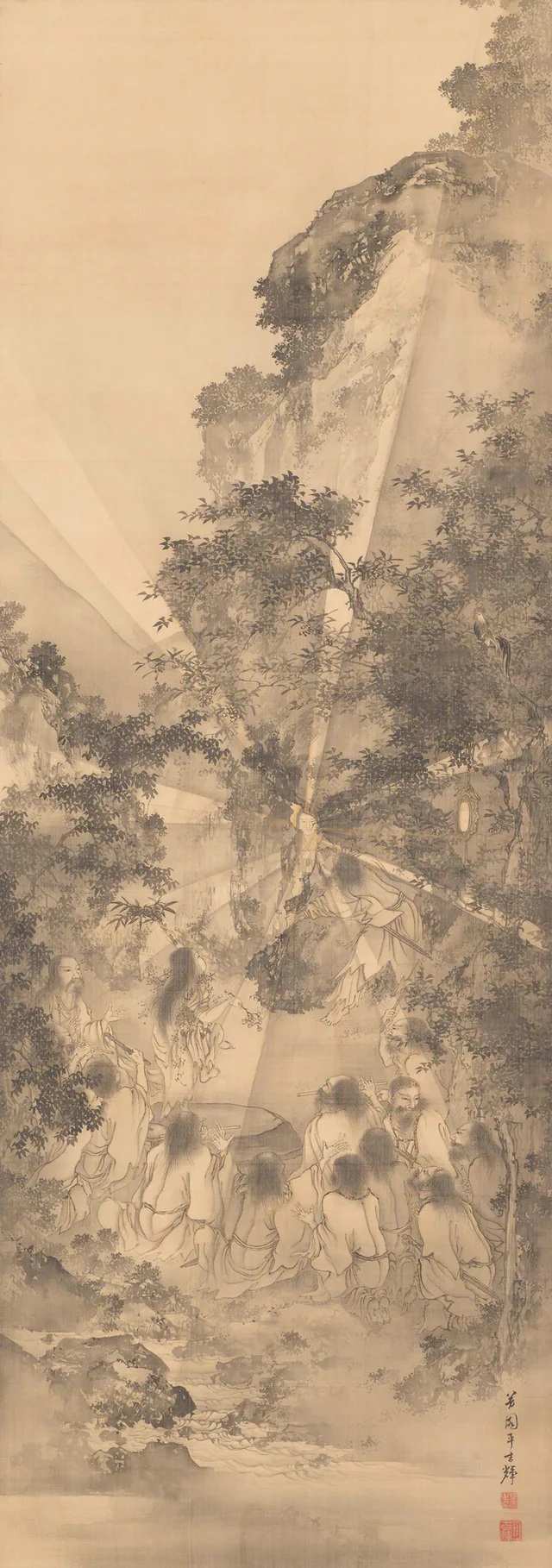
The Japanese Amaterasu is a goddess of the dawn who also brings light and life to the world. While these deities were seen as the powers behind the fertility of all things on earth, they also held stewardship over the mysterious cosmic principle of heavenly life. In the Greco-Roman mystery religions, the revitalization of the initiate was promised via the gifts and boons of the goddess. This should make sense as in fact it is only woman who can bring forth life from her womb. In many respects, the rites of rebirth analogized the tomb with the womb, so that those going into the beyond could be reborn by a Heavenly Mother whose womb was the cosmic precinct of immortality.
The Goddess in Prehistory
“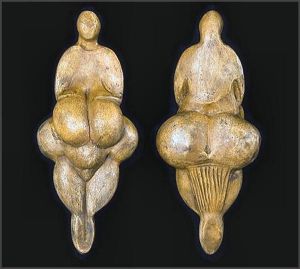 As far back as the Paleolithic Age,” writes Maarten J. Varmaseren, “one finds in the countries around the Mediterranean a goddess who is universally worshiped as the Mighty Mother” . From 30,000 to 10,000 BCE, adds Joseph Campbell, “the [Goddess] is represented in those now well-known little ‘Venus’ figurines” . A limestone relief found in southwestern France in the Pyrenees is illustrative in this regard. Dating to 25,000 BCE, an engraved Venus image is shown holding a bison horn inscribed with thirteen vertical strokes. This is the number of nights between the first crescent and the full moon .
As far back as the Paleolithic Age,” writes Maarten J. Varmaseren, “one finds in the countries around the Mediterranean a goddess who is universally worshiped as the Mighty Mother” . From 30,000 to 10,000 BCE, adds Joseph Campbell, “the [Goddess] is represented in those now well-known little ‘Venus’ figurines” . A limestone relief found in southwestern France in the Pyrenees is illustrative in this regard. Dating to 25,000 BCE, an engraved Venus image is shown holding a bison horn inscribed with thirteen vertical strokes. This is the number of nights between the first crescent and the full moon .
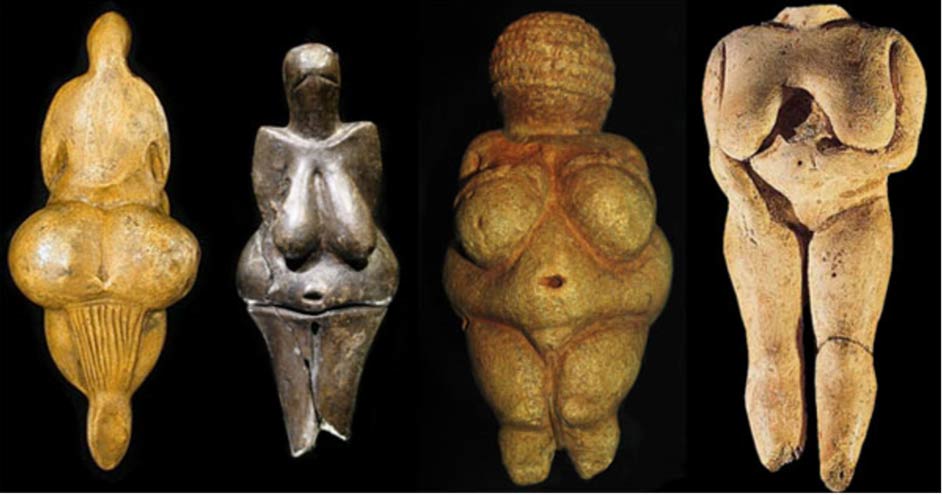
The Goddess figure is holding her swollen belly with her other hand, suggesting that at this early date, the lunar and menstrual cycles were connected, and that the Goddess figure was symbolic of the whole archetypal complex of the feminine divine: life, birth, and death.
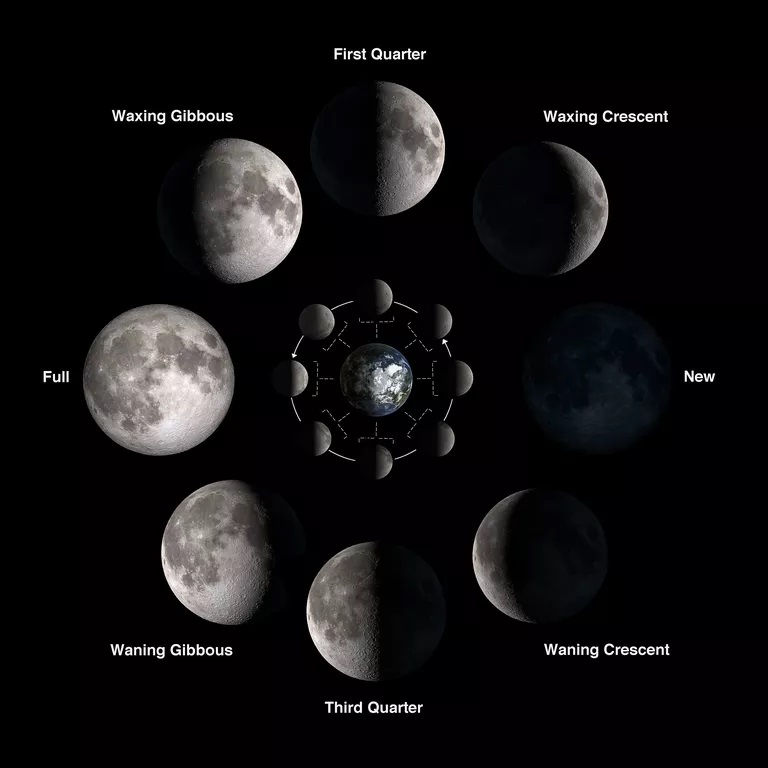
According to Joseph Campbell, the goddess has three functions:
“one, to give us life; two, to be the one who receives us in death; and three, to inspire our spiritual, poetic realization”

All three of these functions can be seen in the prehistoric art of Çatal Hüyük.
On a green schist stone dating to about 6000 BCE, the goddess is portrayed “back-to-back with herself, on the left embracing an adult male, and on the right holding a child in her arms”.

The powers of the Mighty Mother are the transformations of life: “She is the transforming medium that transforms semen into life. She receives the seed of the past and, through the miracle of her body, transmutes it into the life of the future” . Her womb is the ultimate matrix of metamorphosis, a cosmic umbilicus whose power derives from the heavenly antipodes between which all material creation was forged: “The Goddess is the axis mundi, the world axis, the pillar of the universe. She represents the energy that supports the whole cycle of the universe” . Perhaps for this reason the Mother Goddess was most often worshiped in caves . The subterranean chamber was the anagogical medium that connected the wombs of heaven and earth.
This heaven-earth correspondence is a very important point to make. By the second millennium BCE the Mother Goddess was a nature deity represented as Mother Earth. Her womb was the land that produced the seed of bounty, and she was associated with the fertilization and growth of life from the dark soil. Her shrines were in groves and caves representative of this chthonic source of life. Yet the chthonic feature of the Goddess was only half of the symbolic heritage. The Goddess was, above all, the Heavenly Mother, the Queen of Heaven, and Cosmocrator of the World. Her chthonic womb was only the root of the heavenly tree.
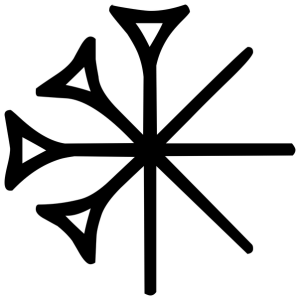
In Sumerian, the glyph for heaven, An, also meant “crown of tree” . The female date palm grew numerous branches holding massive clusters of dates. This image was analogous to the whole of creation, where the tree was symbolic of the universe, both in form and function.
The roots, trunk, branches, and fruit were images of the underworld, material world, and heavenly world where life originated. The date laden branches of the palm tree were an image of the stars in the sky that produced light and life. The glyph An meant heaven and crown of tree because, analogically, they were the exact same thing.

In religions and myths throughout the Near East and Mediterranean, the Goddess was analogized with the Heavenly Tree. While the roots of this cosmic tree were the chthonic womb of the Mother Goddess, the “crown of tree” represented her seat of power. It was her heavenly womb that was the lapis occultus, the heavenly vault of the mysteries from which all life
descended. So it is that “the date palm represents the celestial mother goddess nurturing her abundant harvest of children in the high heavens” , and that “the seed of mankind is the light of the stars. This is the seed that the mother of humanity gestates in her heavenly womb” .




This heavenly aspect of the Goddess survives in many forms, including in her old role as
a solar deity. One is reminded that among the Hurrians, Canaanites, and pre-Islamic Arabs the sun was female .
 In ancient Mesopotamia the earliest aspects of the Mother Goddess had solar connections, and the sun-goddesses of the Near East may prefigure their male
In ancient Mesopotamia the earliest aspects of the Mother Goddess had solar connections, and the sun-goddesses of the Near East may prefigure their male
counterparts: “even the Akkadian sun god Šamaš is meant to have mysterious feminine origins.
The earliest hard evidence for Šamaš in Mesopotamia comes from the Early Dynastic period where his name occurs in personal names—and some such names like ‘Ummi-Šamaš literally meaning ‘My mother is Šamaš’, obviously imply a feminine solar deity”. In Uruk, the Queen of Heaven held stewardship over the 50 Me. The Me were the priesthood keys of authority that regulated all forms of civilization on earth but were only copies of divine, celestial
powers residing in the heavens.

The Goddess was an earth deity only inasmuch as her role as Mother Earth was a reflection of a celestial archetype: Queen of Heaven.
Returning to the art of Çatal Hüyük, we find a terra cotta figurine also dating to at least 6000 BCE and depicting the Mother Goddess sitting on a throne between two lions . Between her legs emerges a human head, and at first glance the symbolism appears to be that of birth. Some scholars believe that the emerging head belongs to the divine son of the Mother Goddess. 
In mystery cults throughout Classical Greece it is the Goddess and her divine counterpart—her son—that provide the pathway to everlasting life and resurrection. Yet other scholars have a completely different interpretation of the image. Rather than interpreting the emerging head as an act of birth, they believe it is a scene of the Goddess “taking the deceased back into her womb” . In other words, the symbol is not of birth but of re-birth into the next world; “This idea is not without parallels in the Mediterranean area, and special attention is drawn to the fact that at Çatal Hüyük, both in the cult-rooms and in the houses, so much space was reserved for the dead” . 
Either interpretation seems acceptable as birth and death are part of an eternal circuit of a cosmic cycle. One leads to the other, but neither takes precedence. The womb is the tomb. The tomb is the womb. Of even greater interest are the two lions which frame the throne upon which the Goddess is seated. Not only is the Mother Goddess associated with a Heavenly Tree, she is also depicted with lion wards throughout Near Eastern and Mediterranean art.  The Cretan Mother Goddess is depicted standing on her holy mountain framed by two lions. Inanna and Ishtar are often shown standing on or by their two lions. The mystery goddess Cybele is always pulled in a lion chariot and is crowned on her lion throne. While this lion imagery is often taken as an earth-bound symbol and part of the repertoire of the “Lady of the Beasts,” the truth is this lion imagery, in its cultic context, always held celestial meanings.
The Cretan Mother Goddess is depicted standing on her holy mountain framed by two lions. Inanna and Ishtar are often shown standing on or by their two lions. The mystery goddess Cybele is always pulled in a lion chariot and is crowned on her lion throne. While this lion imagery is often taken as an earth-bound symbol and part of the repertoire of the “Lady of the Beasts,” the truth is this lion imagery, in its cultic context, always held celestial meanings. 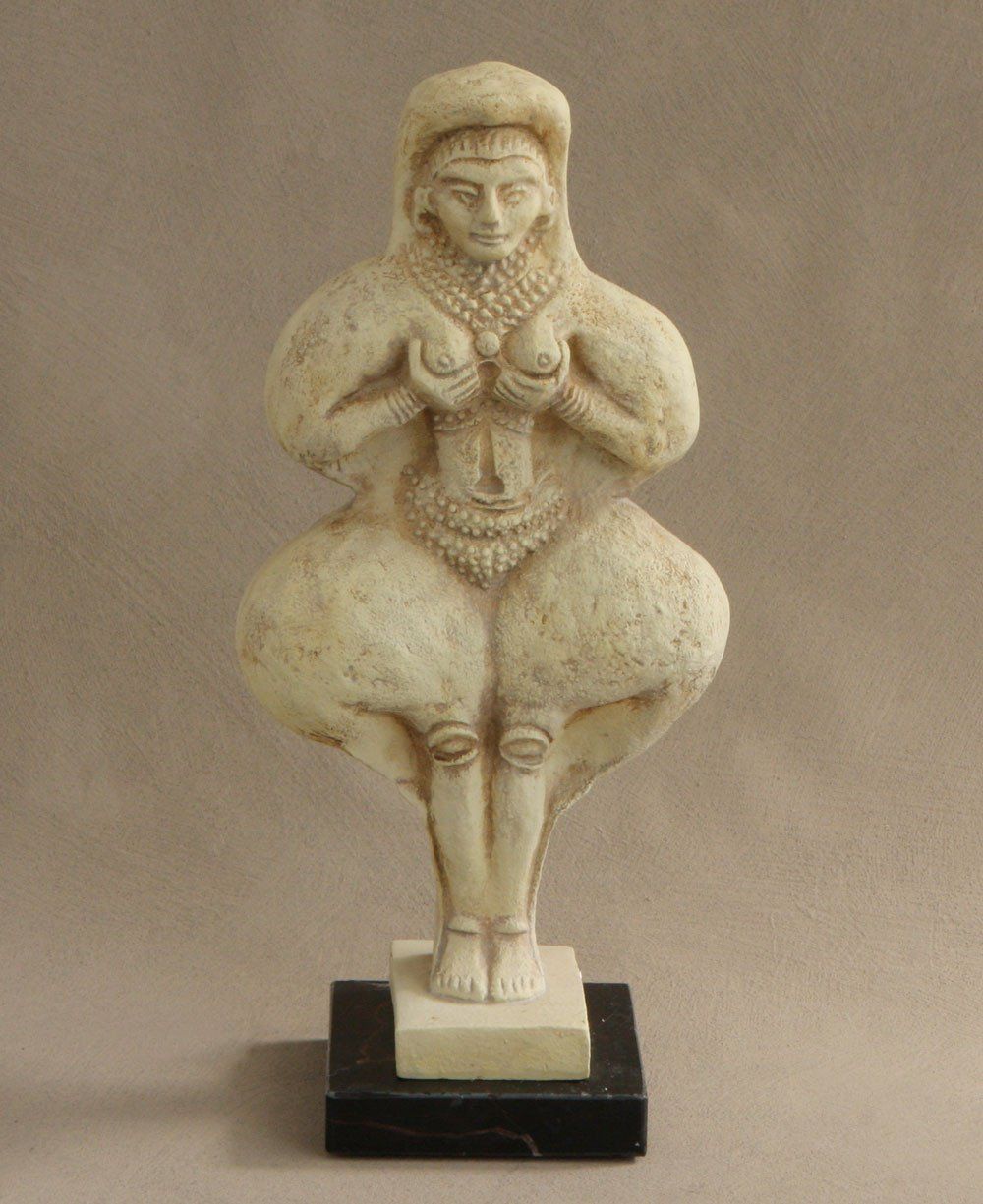
The Mother Goddess of Çatal Hüyük sitting on her lion throne is provocative in this regard. The lion throne is indicative of heavenly powers. The Egyptian pharaoh always sat upon a lion throne whose symbolism established his right to rule on earth via a heavenly mandate. Zeus, too, is often depicted on his lion throne, and throughout Medieval times representatives of the Papacy distributed orders from their lion thrones. The lion upon the throne was more than a symbol of power or royalty. In its more ancient context, the lion was a symbol of the power and royalty of the heavenly world. It was the lion that always stood at the portal to the next world, and leonine sphinxes guarding the gates of temples have been found throughout all of ancient Eurasia. The guardian lion was heavenly ward and psychopomp par excellance in the Near East. Osiris could only arise from death upon his lion couch, and Gilgamesh could only descend into the underworld whilst wearing lion robes.
It is the lion skin itself that is representative of the heavenly vault. Its striations or spots signified the starry realm, and wearing a lion skin was very often a necessary cultic endowment in the mystery religions. The priests of Pharaoh always wore lion skins as they performed their rituals for the afterlife. The lion garment proclaimed their authority to officiate in the arcane secrets. In the Ramesseum Dramatic Papyrus, Horus acknowledges Osiris and declares, “The panther skin unites thy limbs, [. . .] the eye [of Horus is] ssf-cloth”. The term ssfcloth is symbolized by a panther goddess and represents the mummy wrappings (Nibley 440).
 Thus, every Egyptian mummy symbolically wore a lion garment and was given the lion crown at the lion gate of the next world. Meanwhile, Heracles must defeat the Nemean Lion and wear its skin for his Twelve Labors. This episode only makes sense in the context of the celestial voyage of the dead. Jason and Theseus must also wear lion skins as they perform their Labors, whilst Attis must defeat a lion guardian and Bellerophon must slay the lion-headed chimera.
Thus, every Egyptian mummy symbolically wore a lion garment and was given the lion crown at the lion gate of the next world. Meanwhile, Heracles must defeat the Nemean Lion and wear its skin for his Twelve Labors. This episode only makes sense in the context of the celestial voyage of the dead. Jason and Theseus must also wear lion skins as they perform their Labors, whilst Attis must defeat a lion guardian and Bellerophon must slay the lion-headed chimera.
In all these examples the lion is the symbol of the powers and secrets of the next world.
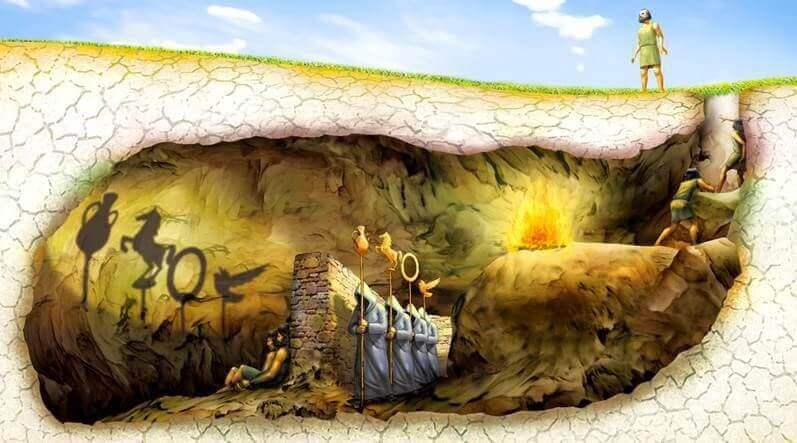
Borrowing from Plato’s allegory of the cave, the lion sphinx, the lion throne, or the lion robe were all representations of the realm of true forms. The lion throne is the embodiment of the royal mandate; for example, it announces to its subjects that its occupant is the holder of the secrets and keys from the celestial realm. The lion skin or garment is the robe of rebirth and the ultimate ritualistic accouterment for dealing with archetypal powers. While in later eras it was the kings who wore the lion emblem, the terra cotta figurine from Çatal Hüyük shows that the Goddess possessed the celestial powers of birth and rebirth in the archaic age. She was the ultimate symbol of the antipodes of the universe: her chthonic and heavenly wombs were the source of all life.

- Egyptian Mysteries
The archetypal complex of the Mighty Mother was inherited by Egypt. It is often assumed that the process of resurrection in the Egyptian scheme was overseen by Osiris, the Lord of the Underworld.

The mysteries of Osiris place this god center stage, for his death and rebirth are the main theme of the mystery play. The truth is, however, the entire drama of rebirth is not overseen by the god but by the goddess, whose womb is the deus ex machina which saves the climactic action from complete oblivion. Repeatedly in the funerary texts and vignettes the major characters of the liturgical pageant show up performing all their prescribed duties: Osiris is killed and rises, Anubis guides, Thoth records, Horus aids and fights, Atum, Re, or some other version of the solar god breathes new life into the dead, etc. Never far away from all these scenes, however, is a representation of the Mother Goddess who oversees the entire operation from beginning to end and is the key to cosmic rebirth.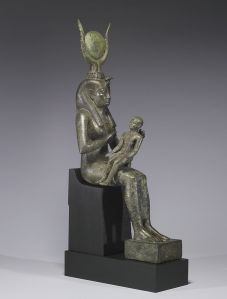
It is actually Isis and Nephthys who always appear by the lion couch where Osiris lies, and it is their power which helps raise him from the state of death. In Egyptian myth, Isis and Nephthys are really dual personifications of the Mother Goddess, one representing the heavenly mother and the other the earthly one . Isis and Nephthys are the celestial and chthonic wombs of life. Meanwhile, in the twelve divisions contained in the book That Which is in the Underworld the solar god is always accompanied by a figure called “lady of the boat” who is the true guide through the darkness leading the envoy past each obstacle and gate which inhibits progress .
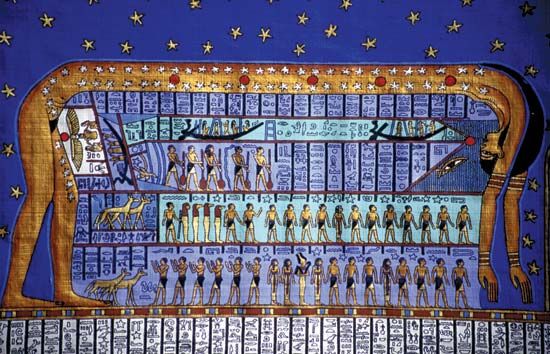


Each boat in the underworld is adorned with symbols of the various manifestations of the Mother Goddess, including symbols representing Hathor, Maat, and Isis, all who are absolutely essential for the journey’s success. Isis remains central to the resurrection drama. When the Egyptian boat is at its darkest, deepest, and most treacherous juncture in the netherworld only Isis can tow it across the dry sand and to safety . It is Isis “whose mouth is the breath of life, whose sentence drives out evil, and whose very word revives him who no longer breathes” . A papyrus dating from the time of Khufu speaks of Isis as the true ruler of the Pyramids . She is the “Mother of God” who raises the dead to the celestial heights: “The Divine Sothis, the Star, the Queen of Heaven” .

“To be reborn in resurrection, the king must enter again into his mother’s womb,” writes Hugh Nibley. “The sarcophagus in which he lay was called mw.t, which also means ‘mother,’ and was designed to represent the embracing arms and wings of the starry sky-mother [Nut]”). As the deceased lies in his coffin he is swallowed by the mouth of Nut in the west and reborn from the womb of Nut in the east; the entire gestation cycle is celestial.
The essential role of the Mother Goddess in the process of Egyptian rebirth explains the essential difference between her imagery as Nut, the Sky Mother, and the imagery found in other mythologies where the mother goddess is terrestrial, such as Gaia, the Earth Mother. In the latter example the mother goddess is analogized with the fertile ground which receives the solar semen and whose womb swells with the pregnant produce of nature. As all material forms, however, are only reflections of celestial archetypes, the true womb of the universe must remain heavenward.
The chthonic womb of the Goddess was the heavenly underworld, while the celestial womb was the vault of the high heavens, variously named the aperion, realm of fixed stars, Islands of the Blessed, or the Garden of Eden. Like the Mother Goddess seated in her lion throne at Çatal Hüyük, Nut, or Isis, are symbols of the Queen of Heaven who holds ultimate stewardship over the cycles of rebirth in both worlds.
- Greco-Roman Mysteries
What is true of Egyptian myth and rite in this regard is also true for the later Greco-Roman mystery cults, as Jane Ellen Harrison makes clear: “The mysteries of Greece never center round Zeus the Father, but rather round the Mother and the subordinate son” . While Olympian gods are approached with prayer, praise, and presents, the Mother Goddess “is approached by means that are magical and mysterious” because she possesses the mysteries .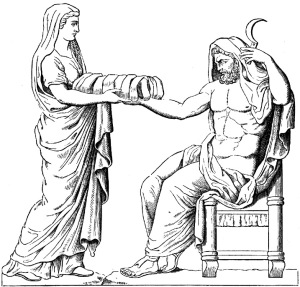
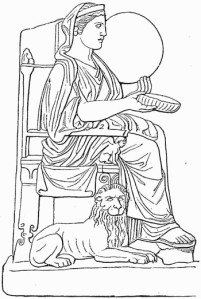
One must remember that in ancient Greece the various female deities were all facets of the Mighty Mother. Hera, Demeter, Athena, Aphrodite, and Artemis represent different aspects of the one Mother Goddess.
 In the Metamorphoses of Apuleius, the Mother Goddess is identified by many names, including: Mother of the Gods, Minerva, Venus, Diana, Proserpina, Ceres, Juno, Bellona, Hecate, and others . Whatever her title, name, or station, she is always understood to be both queen of heaven and the underworld, of life and death and of the mystery of rebirth . In Roman times “the performance of her rites remained in the charge of orientals, not Romans, a dispensation carefully maintained by the Roman Senate throughout the Republic; under the direct control of the State the cult of the Goddess was to be kept in the proper channels” .
In the Metamorphoses of Apuleius, the Mother Goddess is identified by many names, including: Mother of the Gods, Minerva, Venus, Diana, Proserpina, Ceres, Juno, Bellona, Hecate, and others . Whatever her title, name, or station, she is always understood to be both queen of heaven and the underworld, of life and death and of the mystery of rebirth . In Roman times “the performance of her rites remained in the charge of orientals, not Romans, a dispensation carefully maintained by the Roman Senate throughout the Republic; under the direct control of the State the cult of the Goddess was to be kept in the proper channels” .
The oracle at Delphi was dedicated to Apollo only in later times; the oracle center first belonged to the goddess Themis who was the steward of the gate of heaven. At Delphi there was a sacred rock known as the omphalos, or navel of the world, as well as a mysterious cleft descending into the earth which represented the nexus between worlds. Here the seekers of knowledge from the other world descended into the cave of the Goddess, for she kept the ultimate secrets and possessed the navel and nexus of creation. The Oracle at Delphi has an interesting parallel to the school of Parmenides. Parmenides is the father of Greek philosophy.
He declared his authority to teach via a vision he had in which he ascended to heaven and was met by aids and stewards of the heavenly word, all of whom were female. At the apex of heaven, Parmenides discovers the secrets of the world, and they are taught to him by the Goddess.

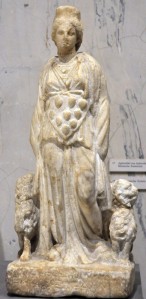

All the mystery cults held the divine Mother as central to the mystery of rebirth. Cybele was the Heavenly Mother of the Attis cult. She was not only the Queen of Heaven but also the Queen of the Underworld and the wife of Hades . Demeter and Persephone fulfill the same role at Eleusis, while Harmonia fills in at Samothrace. Mother-Goddess imagery
is absent in Mithraism, an all-boys club, but the Attis Mysteries were utilized by priests of Mithraism for the initiation of women so they too might receive their afterlife rewards .
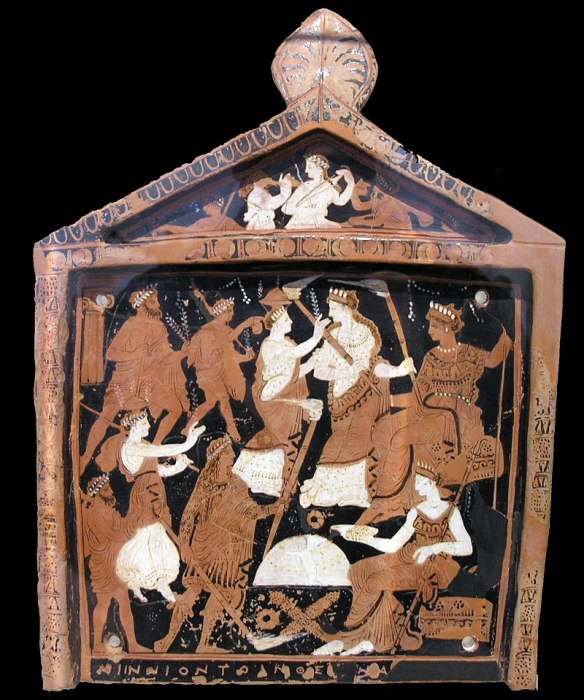

Demonstrably, in the Greco-Roman mysteries, female priestesses were stewards of the matriarchal rites and always attended the mystai performing various roles as they aided the initiate on his quest. This fact also parallels the sister/daughters of Osiris who lift him out of the clutches of death and the sister/daughters of Oedipus who guide him to the mystery grove at Colonus.
At the heart of the mystery religions were the secrets of rebirth. These secrets were sacrosanct, and initiates were forbidden to reveal them at the pain of death. The very word mystery is from the Greek mysterion, derived from the verbal root myein meaning to close, “referring to the closing of the lips or the eyes” . As Marvin Meyer observes, “an
initiate, or mystes (plural, mystai) into the mysterion was required to keep his or her lips closed and not divulge the secret that was revealed at the private ceremony. [. . .] Most mystai observed their pledge of secrecy, and as a result we posses little information about the central features of the mysteries” .
Additionally, the verb myein held special reference to the closing of the eyes. Kevin Clinton notes, “evidence from other mystery cults shows that it was the practice for an initiate to be blinded; the term [mystai] expresses the opposite of epoptes ‘viewer’): the first stage is characterized mainly by ritual blindness (when the initiate is led by a mystagogue), the second stage by sight” . The darkness every initiate endured represented death. Each initiate was led through dark passages and blind wanderings by a guide; this was exemplary of the journey of the soul through the underworld. It was widely believed that the souls of all those who did not receive proper initiation would remain bound to the dark regions of the netherworld.
Those who had received the proper, ritual instructions for the afterlife were given a “passport through the sky,” borrowing a phrase from Macrobius, whereby the soul would be led to the Islands of the Blessed. This ascent of the soul was reenacted during the ceremonies in a moment of blinding vision called epoptes. The initiate’s liturgical descent through darkness ended in the Telesterion. A hidden skylight was built in the Telesterion that was opened at the correct, ritual moment whereby sunlight would stream into the darkness at the moment of the initiate’s symbolic rebirth .
All this journeying through darkness into light meant that each initiate needed a guide. Plato assures us, “For after death, as they say, the genius of each individual, to whom he belonged in life, leads him to a certain place in which the dead are gathered together for judgment, whence they go into the world below, following the guide, who is appointed to
conduct them from this world to the other” (Phaedo 664). It is a tradition that would find itself rooted in early Christianity, “Because strait is the gate, and narrow is the way, which leadeth unto life, and few there be that find it” (Matt.7.14).
In the Greco-Roman mysteries, however, the straight and narrow path belonged to the Goddess. The expedition of the soul is recorded in one tradition within the famed Orphic gold plates. 
These were tablets of gold found buried with Orphic initiates whereon instructions for the celestial afterlife journey were written. Many of the tablets were found on the mouths of the
deceased, as if they were the oral passports through the netherworld. Others were found clutched in the hands of the dead as a token and passport through the underworld. On one tablet we read:
Blessed and most happy you will be god instead of mortal.
[. . .] Go th the right [. . .] observe very carefully,
[. . .] Once human you have become a god.
A kid, you fell into milk.
[. . .] Take the right-hand road to the sacred meadows and grove of
[Persephone].
Now you died and now you were born, thrice blessed one, on this day.
Tell [Persephone] that the Bacchic one himself has released you.
Enter the sacred meadow!
For the mystes is without punishment.
On another tablet we read: “Thou art become god from man. A kid thou art fallen into milk. Hail,
hail to thee journeying the right hand road, By holy meadows and groves of Persephone”
Still another tablet adds to the details listed above, “And indeed you are going a long sacred way which also other mystai and bacchoi gloriously walk”.
This special road was reserved only for the initiated. “Thrice blessed one” refers to those who have performed three ordinances or have taken three sacraments essential for the journey of
the dead. The special road is itself populated with key features that the dead must attend to, as
another tablet makes clear:
Thou shalt find to the left of the House of Hades a spring,
And by the side thereof standing a white cypress.
To this spring approach not near.
But thou shalt find another, from the Lake of Memory
Cold water flowing forth, and there are guardians before it.
Say, “I am a child of Earth and starry Heaven;
But I am parched with thirst and I perish. Give me quickly
The cold water flowing forth from the Lake of Memory.”
And of themselves they will give thee to drink of the holy spring,
and thereafter among the other heroes thou shalt have lordship.
As Susan Cole points out, the collection of Orphic gold tablets has grown so large that the
categories of similarities have become as important as the categories of differences.
The Orphic gold plates share repeated celestial themes: a journey, a path, an initiation, a spring of water, the crossing of water, a great tree, and a celestial garden. There are guardians that must be surpassed by the “secret password,” that just so happens to be a declaration of the true identity of the human soul, “I am a child of Earth and starry Heaven.” One’s true nature belongs in the divine realm, and one’s true destiny is apotheosis, “Once human you have become a god.” Such a being is a “kid [. . .] fallen into milk,” which most likely represents the journey of the soul through the Milky Way, where the thrice-blessed dead sojourn to their heavenly realms.
Of great interest is the fact that the underworld realm where the journey begins belongs to
the Goddess. It is an agent of the feminine divine who often appears holding a torch to guide the dead through the dark recesses of the underworld. They are guided to a garden, and in the gold plates thus far found the Orphic dead start in the groves and gardens of Persephone. It is only in this archetypal precinct of the Goddess that the dead find hope. In the first tablet cited the dead are told to tell Persephone that the Bacchic one has released them. 

The “Bacchic one” is Dionysus, who here operates as a sort of judge and intercessor for the dead. Dionysus becomes a savior figure much like Jesus. Unlike the Christian mythos, however, those who are redeemed by Dionysus must be reborn by Persephone. The underworld garden is the chthonic womb that contains a great tree and the Spring of Memory from which the initiated dead must drink. The garden and tree is the form of the divine body of the Goddess, whilst the living waters are the function of her life giving milk. In this conception of the afterlife, the underworld remains the liminal stage of the Heavenly Mother who is birthing her children for the divine drama known as eternity.
According to Plutarch, the contemplation of eternity was the object of philosophy, but it was the contemplation of the mysteries that was the object of religion . The mysteries presented the initiate with two main ideas: myein and epoptes. Dark and light. And this dualistic aspect of nature was the fabric of life. All living processes were held together in opposites. Furthermore, the mortal soul was microcosmos, a reflection of heavenly powers and processes. According to Karl Kerényi, “[The mysteries were] to transform men into true sources of life in the service of that most fragile living thing, the embryo, ‘man in germ.’” . Man was an embryo, and he had to become through the process of a new birth—at inception, at death, and even during life in that awakening called “being born again.” It was the womb of the Goddess that gestated the embryo of being into its greatest potential. The chthonic womb preserved the human soul through myein, and the heavenly womb transformed it at epoptes.



Yet it was the earthly womb of the Goddess, as revealed in the cycles of nature, that reminded the living that life was a constant act of becoming. As Joseph Campbell reminds us, the third aspect of the Goddess was “to inspire our spiritual, poetic realization.” Campbell continues:
She gives birth to us physically, but She is the mother too of our second birth—our birth as spiritual entities. This is the basic meaning of the motif of the virgin birth, that our bodies are born naturally, but at a certain time there awakens in us our spiritual nature, which is the higher human nature, not that which simply duplicates the world of the animal urges, of erotic and power drives and sleep.
Instead there awakens in us the notion of a spiritual aim, a spiritual life: an essentially human, mystical life to be lived above the level of food, of sex, of economics, politics, and sociology. In this sphere of the mystery dimension the woman represents the awakener, the giver of birth in that sense. The rites of the Mother Goddess, traditionally recorded as so many fertility chants and nature props in many a textbook, often discounts the precious idea of her central role as renewer of the living. To be born again was to individuate one’s soul with the spirit of the Goddess; a most difficult task in every age, as Plato assures us: “‘many’ as they say in the mysteries, ‘are the thyrsus-bearers, but few are the mystics,’—meaning, as I interpret the words, the true philosophers” (Phaedo 608). The true philosophers, according to the mysteries of the Goddess, were the ones who understood the origin, destiny, and living purpose of the human embryo.
The rites of the Mother Goddess, traditionally recorded as so many fertility chants and nature props in many a textbook, often discounts the precious idea of her central role as renewer of the living. To be born again was to individuate one’s soul with the spirit of the Goddess; a most difficult task in every age, as Plato assures us: “‘many’ as they say in the mysteries, ‘are the thyrsus-bearers, but few are the mystics,’—meaning, as I interpret the words, the true philosophers” (Phaedo 608). The true philosophers, according to the mysteries of the Goddess, were the ones who understood the origin, destiny, and living purpose of the human embryo.
- The Hebrew Goddess
 Raphael Patai’s first exploration of this theme was in his 1947 book, Man and Temple in Ancient Jewish Myth and Ritual (New York: Nelson), where he cites textual evidence that was not repeated in his later works.
Raphael Patai’s first exploration of this theme was in his 1947 book, Man and Temple in Ancient Jewish Myth and Ritual (New York: Nelson), where he cites textual evidence that was not repeated in his later works.
The Hebrew Goddess demonstrates that the Jewish religion, far from being pure monotheism, contained from earliest times strong polytheistic elements, chief of which was the cult of the mother goddess. Lucidly written and richly illustrated, this third edition contains new chapters of the Shekhina.
Thesis
The Hebrew Goddess supports the theory through the interpretation of archaeological and textual sources as evidence for veneration of feminine beings. Hebrew goddesses identified in the book include Asherah, Anath, Astarte, Ashima, the cherubim in Solomon’s Temple, the Matronit (Shekhina), and the personified “Shabbat Bride”.
The later editions of the book were expanded to include recent archaeological discoveries and the rituals of unification (Yichudim), which are to unite God with his Shekinah.
The identification of the pillar figurines with Asherah in this book was the first time they had been identified as such.
- Christian Mysteries
Rebirth was also symbolized by the male principle. Human life requires both semen and an egg. Osiris, Dumuzi, Attis, Dionysus, and Orpheus are all male deities of rebirth. In the Christian mythos, the male principle dominated to the exclusion of the Goddess who was prominent in the role of salvation for millennia. This exclusion of the divine feminine took many centuries to complete, and as one digs into early Christianity one finds pieces of a grand mosaic that had at one time incorporated the feminine divine into Christian liturgy, but had transferred her role within a male dominated ethos.
In the Didascalia, the third century Church Fathers prescribed three sacraments for the newly baptized Christian initiate. Like the Orhpic mystes, the Christian neophyte had to become “thrice-blessed.” The disciple first had to drink a cup of water that was analogous to the waters of baptism, but also represented the waters of life . These sacramental waters were no different than the waters drunk by the Orphic dead from the Spring of Memory in the garden of the Goddess. By Christian times, this spring of life had been turned into the waters pouring forth from the rock of Christ. The metaphor had changed, but the metamorphosis of that change had not fully eliminated the presence of the feminine.

 So it is that the second sacrament was a drink of milk. This holy milk was indicative of a “mystic rebirth” whereby the neophyte was remade into the newborn child of god. Literally, the initiate was seen as a newly born infant of Christ, and the cup of milk was the true sacrament for the “born again” status; or the initiate as “man in germ.” Poignantly, a milk pail is repeatedly depicted in Christian funerary art, often next to a female ewe, such as is found at the Sepulcher of Lucina, or the Gallery of Flavians , or the Gallery of Flavians, and in the catacombs of Ad Duas Lauros.
So it is that the second sacrament was a drink of milk. This holy milk was indicative of a “mystic rebirth” whereby the neophyte was remade into the newborn child of god. Literally, the initiate was seen as a newly born infant of Christ, and the cup of milk was the true sacrament for the “born again” status; or the initiate as “man in germ.” Poignantly, a milk pail is repeatedly depicted in Christian funerary art, often next to a female ewe, such as is found at the Sepulcher of Lucina, or the Gallery of Flavians , or the Gallery of Flavians, and in the catacombs of Ad Duas Lauros. 
According to Robert Eisler, the milk pail “cannot but represent the first or milk- communion of the newly baptized ‘children’ of the mystic ‘Mother,’ into whose womb, the ‘gremium Matris Ecclesia,’ they have entered, to be ‘reborn into eternity’” .
The Christian disciple has become a “kid fallen into milk” and has placed his feet upon the one true path, “Because strait is the gate, and narrow is the way, which leadeth unto life, and few there be that find it.” Once again, however, the presence of the Mother Goddess has been transferred. Clement of Alexandria invokes the mystical title “heavenly milk” upon Jesus, identifying the milk as the Logos “which flows from the sweet breasts of the mystic bride” which has now become the Church .
The third cup was of wine, and it was often taken with the sacramental bread. This sacrament represented the newborn infant of God as the fully formed christos, the anointed of God who has finally become the “true philosopher.”
 In the Eleusinian mysteries the paramount event was when the initiate was shown a token that represented the “revelation of man,” or his divine origin and destiny. This token was the symbol of Demeter, a newly cut stalk of blooming wheat. Clement of Alexandria made much ado about this pagan rite, insisting upon the absurdity of showing a man a ridiculous piece of grain offered as some form of higher teaching.
In the Eleusinian mysteries the paramount event was when the initiate was shown a token that represented the “revelation of man,” or his divine origin and destiny. This token was the symbol of Demeter, a newly cut stalk of blooming wheat. Clement of Alexandria made much ado about this pagan rite, insisting upon the absurdity of showing a man a ridiculous piece of grain offered as some form of higher teaching.
![]() Joseph Campbell points out, however, that at the height of the Christian Mass this same piece of grain, now made into a sacramental wafer, is offered as representative of the mystery of the rebirth of Christ. Meanwhile, in Greek art, the mystery initiate named Triptolemus is shown carrying a stalk of wheat in a chariot being pulled by Hermes, whilst next to him is another image of Dionysus in the same cart carrying his cup of wine. The bread and wine of Catholic Mass had its precursor in the wheat and wine of the feminine mysteries. The three sacraments of Christian baptism had an exact parallel with the three blessings of Orphic initiation where one was reborn in the groves of Persephone.
Joseph Campbell points out, however, that at the height of the Christian Mass this same piece of grain, now made into a sacramental wafer, is offered as representative of the mystery of the rebirth of Christ. Meanwhile, in Greek art, the mystery initiate named Triptolemus is shown carrying a stalk of wheat in a chariot being pulled by Hermes, whilst next to him is another image of Dionysus in the same cart carrying his cup of wine. The bread and wine of Catholic Mass had its precursor in the wheat and wine of the feminine mysteries. The three sacraments of Christian baptism had an exact parallel with the three blessings of Orphic initiation where one was reborn in the groves of Persephone.
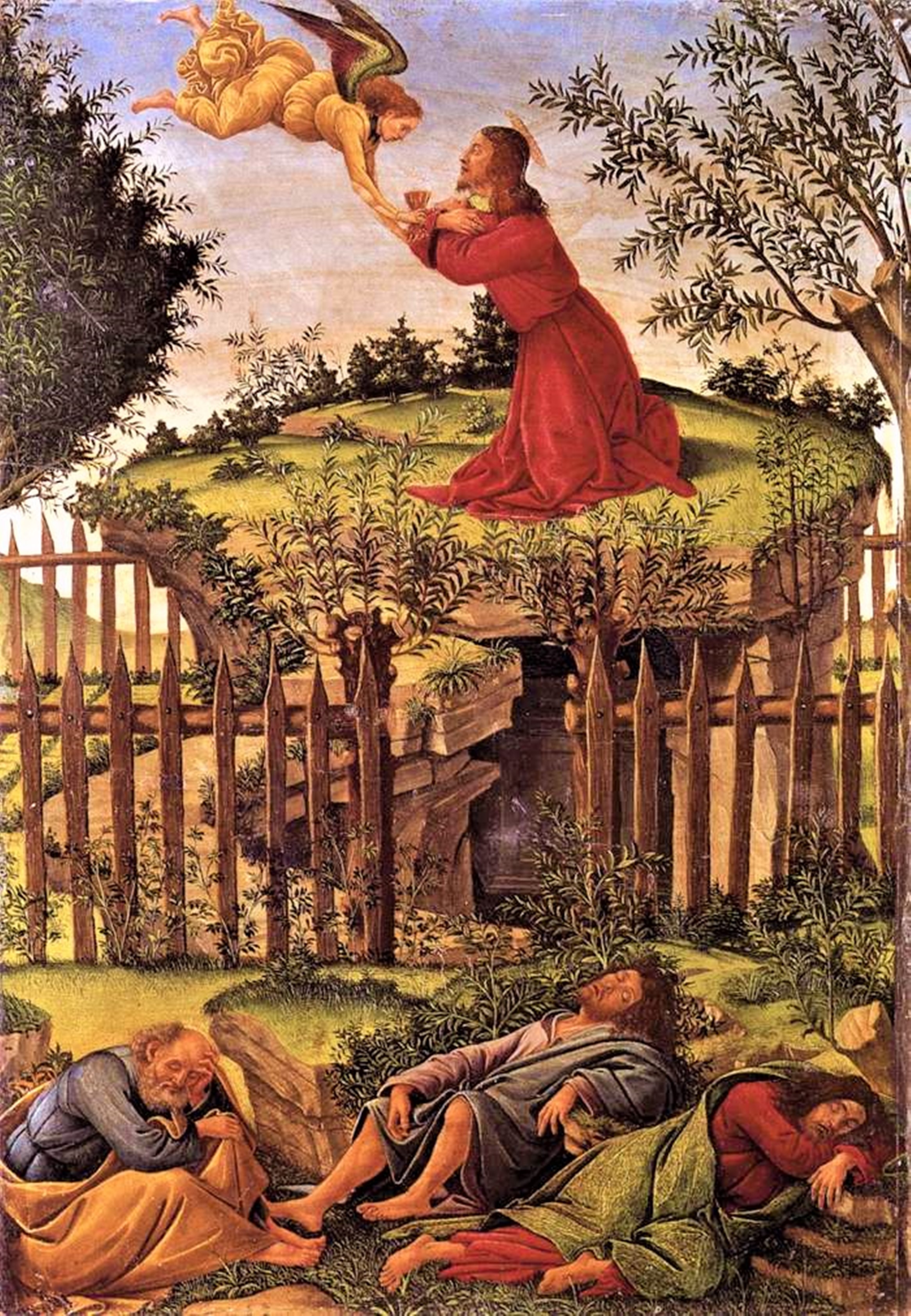
In the emerging order of official Christianity, the Goddess was taking a back seat to the God, Christ Jesus. This stance was not the case in the “unofficial” order of Christianity, such as we find among the gnostics. According to the writings of Hippolytus, the Christian sect called the Naassenes “initiated [themselves] into the Mysteries of the Great Mother, because they found that the whole Mystery of rebirth was taught in these rites” . In gnostic texts the Goddess is identified as Wisdom.  This wisdom was not intellectual smarts, but the essence of gnosis, the knowledge of the true way. Thus, Wisdom could only be found in heaven, and in one gnostic text we read of a traveler who finds himself at the gate of heaven, “And in that place I saw the fountain of righteousness which was inexhaustible: And around it were many fountains of wisdom; and all the thirsty drank of them and were filled with wisdom, and their dwellings were with the righteous and holy and elect” . This of course is the same scene we find in the Orphic plates at the gardens of Persephone. Wisdom, or gnosis, is really no different than the experience of epoptes in the mysteries. It is only to be had by those who have drunk the sacramental milk of the Mother.
This wisdom was not intellectual smarts, but the essence of gnosis, the knowledge of the true way. Thus, Wisdom could only be found in heaven, and in one gnostic text we read of a traveler who finds himself at the gate of heaven, “And in that place I saw the fountain of righteousness which was inexhaustible: And around it were many fountains of wisdom; and all the thirsty drank of them and were filled with wisdom, and their dwellings were with the righteous and holy and elect” . This of course is the same scene we find in the Orphic plates at the gardens of Persephone. Wisdom, or gnosis, is really no different than the experience of epoptes in the mysteries. It is only to be had by those who have drunk the sacramental milk of the Mother.
Gnostic texts include the Goddess by many names, “All Mother,” “Mother of the Living,” “Shining Mother,” “the Power Above,” and even “the Holy Spirit” . Her essential role in these texts is as the giver of special knowledge, however, and as Wisdom she is the key to rebirth. In the Enoch tradition Wisdom is depicted as a tree (1 Enoch 32.3), as a fountain (1 Enoch 48.1), and is the assessor of God who holds heaven’s secrets (1 Enoch 84, 42- 3, 69). In the Pistia Sophia, Wisdom is called the Virgin of Light, who, with her seven female attendants, baptize the worthy, anoint them, and lead them into the Treasury of Light (328-9). This celestial treasury is a heavenly domain under her particular stewardship, of which the Lord Christ proclaims, “For this cause, therefore, have I brought the keys of the mysteries of the kingdom of heaven; otherwise no flesh in the world would be saved. For without mysteries no one will enter into the Light-kingdom, be he a righteous or a sinner” (351).
Even so, from the earliest days of Catholicism the form of the Mother Goddess was kept alive within the cult of the Virgin Mary. Jesus was God and was to be worshiped. Mary was the Mother of God and was to be venerated. As Joseph Campbell makes clear: “The Virgin Mary has been called a co-savior in her anguish and suffering, which was as great as the suffering of her son. She also brought him into the world, and her submission to the Annunciation amounts to an act of salvation, because she acquiesced to this saviorhood” .
The centrality of the Virgin Mary in Catholic Christianity was not a Catholic invention.
This was a hold over from many centuries of worshiping a goddess who was key to the cycle of rebirth. As one pair of writers observe, “Mary takes on many of the roles of the Great Mother goddess of the Pagan Mysteries. Indeed, the Christian festival of the Assumption of the Virgin in August has ousted an ancient Pagan festival of the goddess. Statues of the Egyptian goddess Isis holding the divine child have been the models for many Christian representations of Mary and the baby Jesus” .
![]()
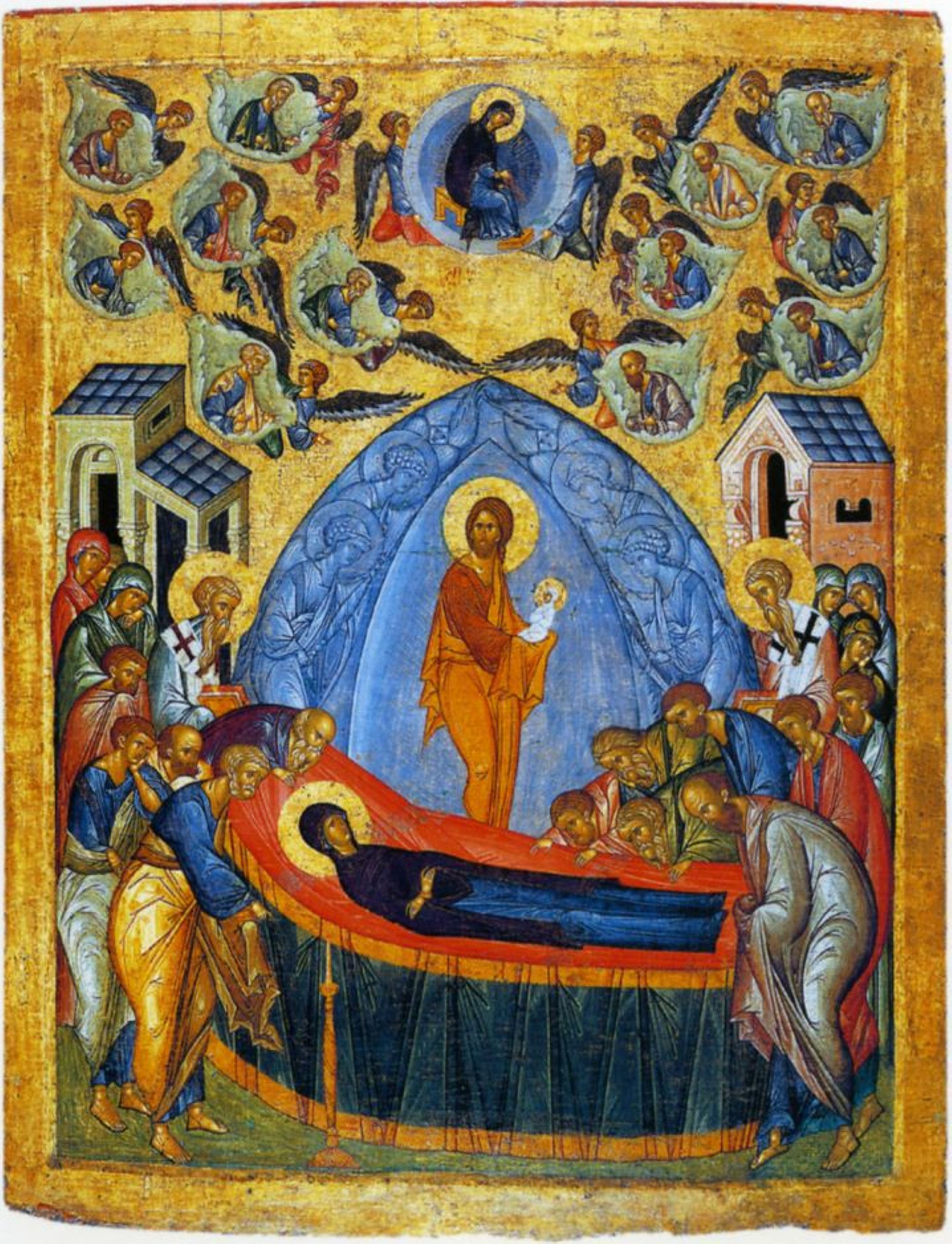
It is easy to see how the veneration of the Virgin Mary was a natural byproduct of the religiosity from the public at large. For numerous generations, oral peoples recognized the essential presence of the feminine divine in the birth of both deity and dignity. Christians often forget the close affinity the early Church had with the feminine principle. While the Virgin Mary was never to be worshiped, she was absolutely necessary for the growth of the new faith. The religious impulse of early Christian converts was deeply entrenched towards the Goddess as the primary metaphor for the principle of rebirth.
Modern Christians have forgotten this connection not without reason. As again Joseph Campbell reminds us, “Orphic imagery is the foreground to Christian imagery, and the mythology of Christianity is far more firmly rooted in this classical [Greco-Roman] mystery religion than it is in the Old Testament” . This statement comes as a shock to
most Christians, simply because they know nothing about the Greco-Roman mysteries.
Christianity was supposed to have been born from Old Testament Judaism. Indeed, if Christianity were solely a product of Judaism, than the veneration of Mary must be viewed as idolatrous.
Protestants certainly see it that way. Yet, while the earliest Christians were all Jews, the expansion of Christianity was due to the converts from the Greco-Roman world at large. In the Greco-Roman mysteries the initiate was given a ritual endowment learning the secrets for the next world. He was often accompanied by female priestesses who would guide him to a garden reprieve after his terrible initiatory ordeal. The whole process was indicative of death and rebirth as overseen by the goddess. We do not find any of this imagery in the Old testament. Indeed, the Old Testament is empty of any reference to resurrection or rebirth until perhaps the very late book of Daniel, where the dead turn into stars: “Those who are wise [sakal; the knowledgeable ones] will shine like the brightness of the heavens, and those who lead many to righteousness, [will be] like the stars for ever and ever” (Dan. 12.3). Hardly orthodox Judaism; however, this is the exact teaching of the Greco-Roman mysteries. While the divine feminine is absent from Old Testament Judaism, (and there is much evidence to suggest that it once was all there), we do find it cryptically embedded in New Testament Christianity.
- The Dream of the Virgin Mary

The Blessed Virgin Mary fell asleep on Mt. Rahel, Jesus came to her and asked; Mother are you asleep? I did sleep but you my Son awakened me, said the Blessed Virgin Mary.
She continued telling him this; I saw you in the Garden, stripped of your clothes, you were led to Caiphas to Pilate, from Pilate to Herode. There your Holy face was spat on (upon) and they crowned you with thorns.
Then they tied you to a pillar of stone and beat you with the chain of iron until your Holy Flesh fell away and then they nailed you on the cross and with a spear they pierced your side from which came your Holy Blood and Water. For more info Read the The Way of the Seeded Earth, Part 1: The Sacrifice (Historical Atlas of World Mythology)
Sacrifice : the hidden meaning of easter
“Death is not the opposite of life. The opposite of death is birth. Life has no opposite.” — Eckhart Tolle
What if the story of Jesus isn’t about Jesus at all?
To re-cast a famous Joseph Campbell saying, what if each of us is the dying god of our own lives? What riches are uncovered if we read the dying god stories not as literal, historical events but as metaphors for our own evolution from material, biological beings bound by instinctual conditioning into spiritual beings of awakened consciousness? Is it any wonder then that the dying god is so often born of a virgin or through some other non-biological process? Horus was conceived as his mother Isis hovered in the form of a hawk over the dead body of her husband Osiris. Mithra was born spontaneously from a rock. Adonis, Attis, Dionysus, Jesus, Quetzalcoatl and many others were born of virgins. The hero, the gift-giver and the dying god live and have their being in higher consciousness, not in the lower realms of ego, competition and conflict. In the Gospel of John, when Nicodemus asks for Jesus’ advice, Jesus simply says, “you must be born from above.” In other words, each of us must shift from lower consciousness to the higher plane of God-consciousness within. The virgin birth signifies that each of us, at the level of our divine essence, was not born from the union of sperm and egg but are identical and unified with the eternally Real, what Krishna called “the unborn” and what Jesus called “everlasting life”. Shifting out of body and ego identification is the work of every spiritual tradition.
If the purpose of myth is to teach us how to live our own lives, then what have we learned?
In Buddhism the central metaphor is that of awakening from the sleep of ignorance, suffering and conditioning. In Christianity the central metaphor is death and rebirth, coming out of our animal nature with its instinctual drives of acquisition and conflict and rising into the unitive experience of God-consciousness, transcending all boundaries and limitations. Resurrection is transformation. Rebirth signifies death to the ego, to limitation, to space and time. Rising from the “grave” of our lower nature embodies the realization of awakening.
Beneath the crests and troughs of the ocean’s waves lies an immense stillness, a stillness that is both the source of the waves and their destination. Is it not true that we “die” every night? Were it not for sleep, this cyclical, recurring “death”, this immersion into the sea of unconsciousness, our life would cease. Just as the silence between notes makes music possible, so too the empty formlessness of the Void makes possible the vibrant fullness of our conscious, waking life. In the end, the inner and the outer are the same. The surface mirrors the depth. The tomb is a womb. Nirvana is samsara, and the kingdom of heaven is lying all around us, only we do not see it. Not only is there a correspondence, there is an identity. Life, in essence, is synonymous with the eternal Ground of Being, the Real, what we in the west call God, and as such it is ultimately untouched by death. “Death is not the opposite of life,” Eckhart Tolle writes in Stillness Speaks. “The opposite of death is birth. Life has no opposite.” Despite centuries of theological calcification it is still possible for us to exhume the universal spiritual wisdom of the Christian story, that each of us is the presence of God-consciousness in the field of forms. Only, as Buddha pointed out, we don’t know it. Like the sun breaking over the horizon at countless sunrise services throughout Christendom this Easter, we too are gradually dawning to the truth of our divine nature. Dare to say it out loud. Let your sun rise. Let the wisdom within you shape your thoughts and words and actions. Become, finally, who you really are. This is the hidden meaning of Easter.

Pakal’s sarcophagus lid ( maya mythology)

Carved lid of the tomb of Kʼinich Janaab Pakal I in the Temple of the Inscriptions.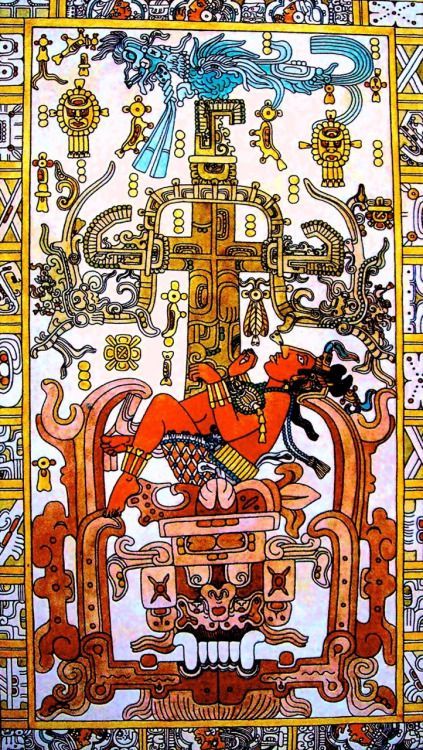
The large carved stone sarcophagus lid in the Temple of Inscriptions is a unique piece of Classic Maya art. Iconographically, however, it is closely related to the large wall panels of the temples of the Cross and the Foliated Cross centered on world trees. Around the edges of the lid is a band with cosmological signs, including those for sun, moon, and star, as well as the heads of six named noblemen of varying rank.[18] The central image is that of a cruciform world tree. Beneath Pakal is one of the heads of a celestial two-headed serpent viewed frontally. Both the king and the serpent head on which he seems to rest are framed by the open jaws of a funerary serpent, a common iconographic device for signalling entrance into, or residence in, the realm(s) of the dead. The king himself wears the attributes of the Tonsured maize god – in particular a turtle ornament on the breast – and is shown in a peculiar posture that may denote rebirth.[19] Interpretation of the lid has raised controversy. Linda Schele saw Pakal falling down the Milky Way into the southern horizon.
Germinate osiris:
 Beginning in Dynasty 18, beds were made on which soil was molded into the shape of the god of regeneration and ruler of the dead, Osiris. Thickly sown with grain and kept moist until the grain sprouted and grew, then left to dry again, these figures were created as part of a ritual carried out in association with the Osirian Festival of Khoiak. They magically expressed the concept of life springing from death, symbolizing the resurrection of Osiris. Some examples are also seen in tomb contexts, as the deceased was identified with this god.
Beginning in Dynasty 18, beds were made on which soil was molded into the shape of the god of regeneration and ruler of the dead, Osiris. Thickly sown with grain and kept moist until the grain sprouted and grew, then left to dry again, these figures were created as part of a ritual carried out in association with the Osirian Festival of Khoiak. They magically expressed the concept of life springing from death, symbolizing the resurrection of Osiris. Some examples are also seen in tomb contexts, as the deceased was identified with this god.


In later periods, pottery Osiris bricks were most likely used during the Khoiak Festival as planters; this example was empty, but others contained soil mixed with cereal grains and linen. Here Osiris is shown in his typical form as a mummy, wearing the tall crown of Upper Egypt flanked by ostrich plumes. In his hands he holds the crook and flail of kingship. See : The Corn Osiris of Isis Oasis




Read also: OSIRIS & HUN HUNAHPU: Corresponding Grain Gods of Egypt and Mesoamerica
Many scholars suggest that Quetzalcoatl of Mesoamerica (also known as the Feathered Serpent), the Maya Maize God, and Jesus Christ could all be the same being. By looking at ancient Mayan writings such as the Popol Vuh, this theory is further explored and developed. These ancient writings include several stories that coincide with the stories of Jesus Christ in the Bible, such as the creation and the resurrection.
 The symbol of the serpent has long been associated with deities of Mexico and Guatemala. In the Aztec language, the word “coatl” means serpent. By placing the Aztec word “quetzal” in front of the word “coatl” we have the word, “Quetzalcoatl”. The word “quetzal” means feathers. A beautiful bird, native to Guatemala, carries the name quetzal. Quetzalcoatl, therefore, means, “feathered serpent,” or serpent with precious feathers. (See our web site for illustration} The word quetzal is the name of the coin in Guatemala and also is the national symbol of the country.
The symbol of the serpent has long been associated with deities of Mexico and Guatemala. In the Aztec language, the word “coatl” means serpent. By placing the Aztec word “quetzal” in front of the word “coatl” we have the word, “Quetzalcoatl”. The word “quetzal” means feathers. A beautiful bird, native to Guatemala, carries the name quetzal. Quetzalcoatl, therefore, means, “feathered serpent,” or serpent with precious feathers. (See our web site for illustration} The word quetzal is the name of the coin in Guatemala and also is the national symbol of the country.
Throughout pre-Columbian Mexican history, scores of individuals, both mythological and real, were given the name or title of Quetzalcoatl. Attempts also have been made to attribute the name Quetzalcoatl to only one person. The following quotations are indicative of what is said about Quetzalcoatl
The role that both Quetzalcoatl and the Maize God played in bringing maize to humankind is comparable to Christ’s role in bringing the bread of life to humankind. Furthermore, Quetzalcoatl is said to have descended to the Underworld to perform a sacrifice strikingly similar to the atonement of Jesus Christ. These congruencies and others like them suggest that these three gods are, in fact, three representations of the same being. Read more here: Quetzalcoatl the Maya Maize God and Jesus Christ
In the sacred history of Meso-America, a Christ-like figure dominates the spiritual horizon. His name is Quetzalcoatl, which means the Plumed Serpent. Quetzalcoatl is one of the most ancient concepts of God in this region. He reconciles in himself heaven and earth. He is the creator of humankind and the giver of agriculture and the fine arts.
 In the tenth century, a Toltec priest named Quetzalcoatl acquired a large following in the Valley of Mexico. He opposed both human sacrifice and warfare, promoting instead the arts and self-discipline as a means for coming closer to God. This made him many enemies among the ruling classes. They brought about his downfall, but he confounded them by rising from the dead, after being consumed in a sacred fire. His heart became the morning star, and he himself became young once again. He promised to return one day to his people.
In the tenth century, a Toltec priest named Quetzalcoatl acquired a large following in the Valley of Mexico. He opposed both human sacrifice and warfare, promoting instead the arts and self-discipline as a means for coming closer to God. This made him many enemies among the ruling classes. They brought about his downfall, but he confounded them by rising from the dead, after being consumed in a sacred fire. His heart became the morning star, and he himself became young once again. He promised to return one day to his people.
The stories of Quetzalcoatl and Christ are so similar that it is easy to see one in the other. In this icon, both Quetzalcoatl and Christ are depicted in the same guise. It is a resurrection icon, with their heart ascending from the flames of death and rebirth. Around the edge, in gold leaf, is an ancient Aztec depiction of the Plumed Serpent. Red and black are the colors the Aztecs associated with the morning star.
Quetzalcoatl and Christ bring us the same timeless message: God is closer to us than we are to ourselves. In both their lives, our human condition has been joined inseparably to the divine. Each proclaims to us a simple gospel of compassion, and invites us to dance with God in the divine fire burning in each of our hearts.
The body and person in the space-time of the Mayans

 For traditional Maya doctors from the Chenes region, in campeche state, winik,the term designating the person, man or individual is closely linked to the symbolism of healing rituals and the principles of the Mayan worldview. In contrast to the Cartesian vision of the world, typical of the Western mind, which separates the body from the mind and spirit, for the Maya the person manifests himself in his material form, the body, kukut,as a reflection of the cosmos, with four directions and a center, and is made up of the elements of nature: earth, water, fire, wind and light. Simultaneously, the same components that make up its materiality are manifested as subtle entities through which the individual interacts with the different levels of the cosmos. This interaction takes place in a space delimited on four sides, the movement of which – countersent to the rotation of the clock hands – binds it with time. Read morehere
For traditional Maya doctors from the Chenes region, in campeche state, winik,the term designating the person, man or individual is closely linked to the symbolism of healing rituals and the principles of the Mayan worldview. In contrast to the Cartesian vision of the world, typical of the Western mind, which separates the body from the mind and spirit, for the Maya the person manifests himself in his material form, the body, kukut,as a reflection of the cosmos, with four directions and a center, and is made up of the elements of nature: earth, water, fire, wind and light. Simultaneously, the same components that make up its materiality are manifested as subtle entities through which the individual interacts with the different levels of the cosmos. This interaction takes place in a space delimited on four sides, the movement of which – countersent to the rotation of the clock hands – binds it with time. Read morehere
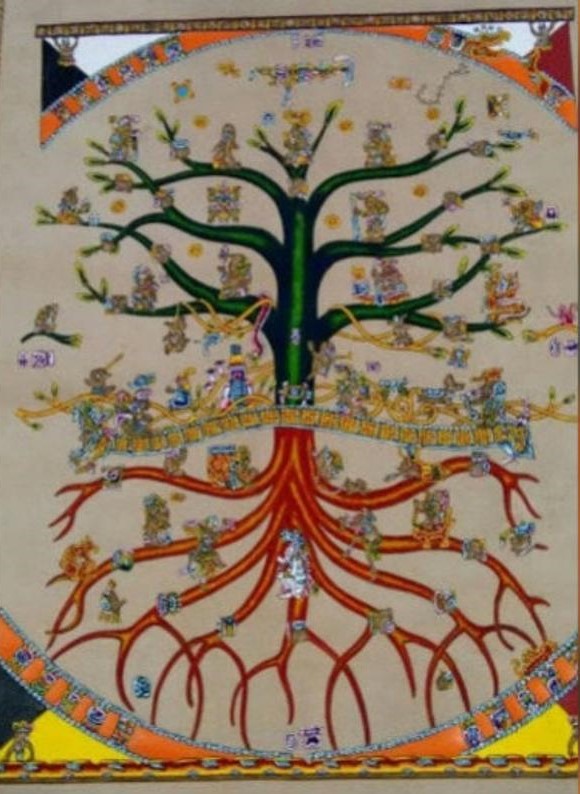
- The Resurrection of Christ, the Standard Bearer and St. George’s Cross.
The resurrection of Easter coincides with the Anniversary of St Georges ( 23th of April) and in many countries connected to it. One of the most common symbols in artwork of the Resurrection is the flag that Christ is waving. Just take a look at this picture of Christ springing out of the tomb.
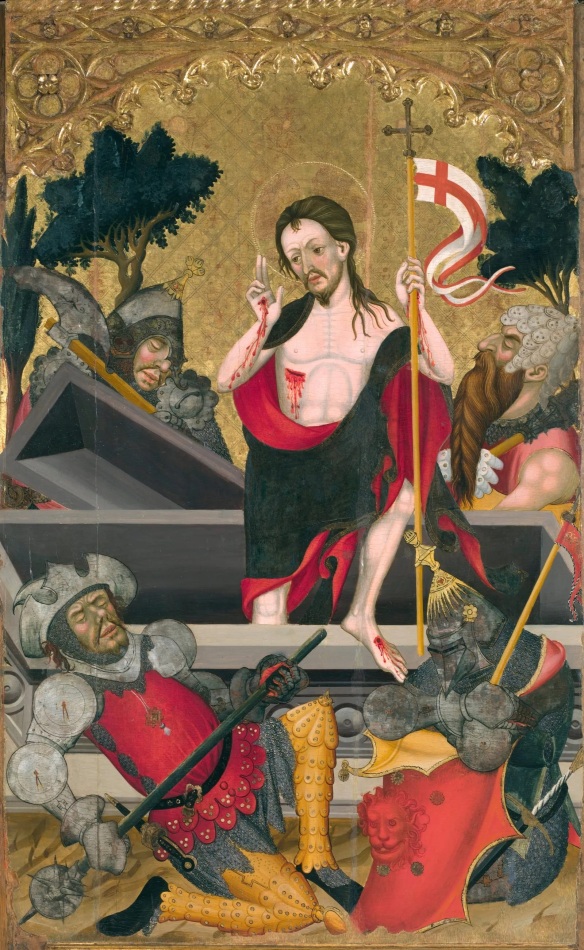
And there are many more examples of this symbol showing up in religious art! There are a lot of pictures in which Christ is holding a flag that has either a white background and a red cross) or a flag that has a red background and a white cross. And this is consistently the case throughout all of Western Europe from the period of the 12th century onwards.




The standard was a distinct flag that was waved during battle. An unarmed soldier, known as a standard bearer, would hold up this flag for the entire length of the battle and wave it around. You might think that this position would be given to those who were normally cannon fodder, so to speak, since this person would be unarmed, but no! Usually, this position was given to persons of honor and these people were heavily guarded, since this position was so extremely important. Furthermore, to drop the standard was seen as a cowardly and potentially treasonous act. So, only the best were chosen for this job.
When the standard was first unfurled, it was a signal to begin the battle. But the flag continued to be important throughout the battle! The flag was also an inspirational sign. As long as your standard was still waving, you had hope.
As you can imagine, it was a popular image for many Christians! After all, He had just defeated death! Yet, His disciples were all scattered and scared in the frenzy of this last victorious battle. So, Christ is commonly depicted as waving this standard to signal victory and to inspire and regroup the troops using a symbolism that many in this time period easily recognized.
While this symbolism might fly over our heads in this modern age, the message still remains the same! Christ has still destroyed death. And, as we go forth in our lives, we should always turn to Christ to both regroup and to be inspired. For His Way is the path to life eternal!
Which leads to the question: why the Flag of St George ?
 This flag became popular around the 12th century because of two reasons: the popularity of St. George and the popularity of the Crusades.
This flag became popular around the 12th century because of two reasons: the popularity of St. George and the popularity of the Crusades.
St. George lived sometime in the third century and died in 303. Though historical records of him in particular are scarce, legend states that he was born in a Christian family with Greek parents somewhere in what is now Palestine. As a young nobleman in the Roman empire, he joined the Roman army, as was typical in his class. He thrived under the military and quickly advanced in rank… until 303.
At that time, the Roman emperor, Diocletian, issued an edict stating that all Christians in the army were required to give sacrifices to the Roman gods and would be degraded if they professed their Christianity — and possibly killed. Then a high-ranking official, St. George realized that he would probably be killed soon, so he gave everything he owned away and then confronted Diocletian himself. There, in the presence of Diocletian, St. George declared that he was a Christian. Which is even more bolder when you consider that the emperors believed themselves gods and, that by declaring his Christianity, St. George was essentially calling out Diocletian of being a mere mortal!
Not wanting to lose a good military leader, Diocletian did his best to convert St. George into Paganism of Rome, to no avail. Finally, he sent St. George to the dungeon, declaring that St. George would be killed in the morning. But then, Diocletian did something sneaky… he sent a woman into St. George’s cell in order to seduce him and thus get St. George to renounce his faith. No good! St. George ended up converting the woman instead! He was executed shortly after.
St. George was venerated as a Christian martyr and seen as a patron of the military after that. However, it was only when the legend of him slaying the dragon was written somewhere in the 12th century that his popularity skyrocketed in the medieval era, filled with popular romances about knights. In those days, where medieval heraldry was the norm, it was popular to give saints their own heraldry.
And so… St. George’s cross was born! Since St. George was a saint who stood up for Christ, they commonly depicted his heraldry as a red cross on a white, though it was also commonly portrayed the opposite way (white on red) too! Take a look at this manuscript illumination of St. George killing the dragon…
Around this time, another thing came about: the Crusades. While in the modern day, the Crusades is seen as terrible, the Crusades were actually remarkably popular at its time! Before the Crusades, you were stuck in a caste system and couldn’t really advance out of your position, even if you wanted to escape the drudgery of peasantry and live the romantic lifestyle of a knight instead. As soon as the Crusades happened, this all changed, and anyone could go out as a knight and escape their peasant situation, if they wanted. As can be expected, many people did!
The Crusades also united Europe as a whole. Before then, Europe was populated by a bunch of vassal states. With the Crusades, they truly became Christendom and connected with each other.
The Green Man, St George and the Dragon Power of Nature
Wherever we travel, from the troubled lands of the Middle East to the remote regions of Russia and Central Europe, we find that he is still honoured as one of the timeless spiritual guides of humanity. He also presides over the great historical institutions like a guiding light, with his chapels and churches located at the very centres of power. Why, we may find ourselves asking, does this alleged Roman soldier martyred for his beliefs right at the beginning of the Christian era still exert such a powerful influence, especially as in 1969 the Vatican demoted him to the rather undignified status of a minor local saint?
![]() The truth is that the long and glorious career of St George has been the target of a campaign of Church propaganda since the very beginning. Close examination of the available records can only lead to the conclusion that the Roman general who is said to have died for his Christian beliefs is unlikely to have ever existed, at least with the name George.
The truth is that the long and glorious career of St George has been the target of a campaign of Church propaganda since the very beginning. Close examination of the available records can only lead to the conclusion that the Roman general who is said to have died for his Christian beliefs is unlikely to have ever existed, at least with the name George.
Eusebius, the generally reliable chronicler and Bishop of Caeseria in whose province the martyrdom occurred, never even mentions him. It is only when that arch-manipulator Constantine the Great begins to rewrite history at the various councils of the early fourth century that George surfaces as a suitably heroic figure to lead the Holy War against paganism. In Constantine’s New World Order the political and military need to create a state religion was imperative; the very existence of the Roman Empire was at stake.
When we begin to look at some of the other elements of the George myth a completely different picture begins to emerge. One of the most telling clues to the genuine mystery behind the George phenomenon is in the name itself.
The word begins and ends with the root Ge. This is one of the oldest words known, occurring in Sumerian, Egyptian, Greek and Indo-European languages. It means Earth. Everyday words still in common use such as Ge-ology or Ge-ography show how persistent this root has been over at least the last six thousand years.
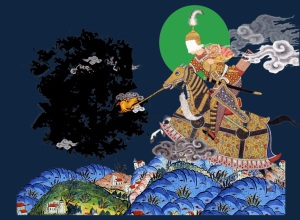 The etymology of George thus appears to show that he may originally have been an Earth-God connected with fertility, whose widespread worship in the ancient world was absorbed by Constantine’s attempts to make early Christianity into an all-inclusive religion that would become a vehicle for Roman bureaucracy. To reinforce this view the Greek translation of the name means ‘Earth-worker’ or ‘Tiller of the soil’.
The etymology of George thus appears to show that he may originally have been an Earth-God connected with fertility, whose widespread worship in the ancient world was absorbed by Constantine’s attempts to make early Christianity into an all-inclusive religion that would become a vehicle for Roman bureaucracy. To reinforce this view the Greek translation of the name means ‘Earth-worker’ or ‘Tiller of the soil’.
What has this got to do with a martyred soldier?
 The widespread appearance of St George in Mayday and other springtime folk rituals also appears to show that he was the presiding spirit of such festivities that have their roots in pre-Christian times. It begins to look as though George may have originally represented the fertile spirit of the Earth itself, the force that lies dormant in the winter and awakens each spring to bring renewed Life. His ‘martyrdom’ is that of the dying god who is resurrected each year, and on whose rebirth we are all dependent.
The widespread appearance of St George in Mayday and other springtime folk rituals also appears to show that he was the presiding spirit of such festivities that have their roots in pre-Christian times. It begins to look as though George may have originally represented the fertile spirit of the Earth itself, the force that lies dormant in the winter and awakens each spring to bring renewed Life. His ‘martyrdom’ is that of the dying god who is resurrected each year, and on whose rebirth we are all dependent.
Note: Beyond this sufficient criterion, dying and rising deities were often held by scholars to have a number of cultic associations, sometimes thought to form a “pattern.” They were young male figures of fertility; the drama of their lives was often associated with mother or virgin goddesses; in some areas, they were related to the institution of sacred kingship, often expressed through rituals of sacred marriage; there were dramatic reenactments of their life, death, and putative resurrection, often accompanied by a ritual identification of either the society or given individuals with their fate. see DYING AND RISING GODS
Many centuries after the supposed existence of the Roman St George a new element was grafted onto the myth that turned him into a dragon-slayer. This came about because of a story in Jacobus de Voragine’s The Golden Legend, a compendium of the lives of the saints. Destined to become one of the best-selling books of all time it had a massive influence on the popular psyche, for in those days it was believed that such writings were the results of historical scholarship and not propaganda or mass mind-control through the media, as we might perhaps see it today.
But Jacob was Bishop of Genoa, one of the great maritime trading and banking centres of the Knights Templar, a city dedicated to St George. Its foundation legend told of San Siro, who coaxed a troublesome draconic serpent from a well and banished it. Such legends were common throughout the pre-Christian world and it seems more than likely that Jacobus’ grafting of the dragon legend onto that of St George was yet another exercise in bringing the pagan mythologies into line with the worship of the One True God. His idea worked brilliantly, for it blended the Dragon Lore of the Celtic world with the heroic knight of Christendom who fought for Truth and Justice
It also, beyond its fairy-tale appeal to the common mind, alluded to a tradition that was well-known amongst the mystically-inclined Templars. This was the esoteric science of the Dragon Power of Nature, the Life-Force that animates the Earth, the Kundalini or fiery serpent power cultivated by mystics and those involved in the search for enlightenment, the essential root of evolving spiritual consciousness. see THE KUNDALINI – SERPENTS AND DRAGONS
- Rebel in the Soul: An Ancient Egyptian Dialogue Between a Man and His Destiny

“The man’s soul tells him that men of greater value than he have suffered from the world, and advises him to gain an insight from his attitude and search to overcome his despair.
It tells him about the “mythical field of transformations”
…both the field AND the plough are to be found within mankind.
The field is the ground – the earth, where the soul of the man dwells, and is to be cultivated by the plougher.
The harvest is what is then offered back to the soul. The “harvest”, what is left of the man after his life, is in dangerous hands if left uncultivated.
It is exposed to a “storm from the North” said to indicate the Head.. the storm is consciousness threatened by intellectual rebellion.

This mythical field of transformation, Become the place of theophany.
It ‘is what Rumi calls the spiritual resurrection: “The Universal Soul is in contact with the part of the soul and the latter has received from her a pearl and she puts it in her bosom. Due to this touch of her bosom, the individual soul has become pregnant, like Mary, of a Messiah ravishing the heart. Not the messiah who travel by land and sea, but the Messiah who is beyond the limitations of space! So when the soul has been fertilized by the soul of the soul, then the world is fertilized by such a soul .

More info about Rebel in the Soul: An Ancient Egyptian Dialogue Between a Man and His Destiny , Translation by Bika Reed here
- The best example of the Plougher is St George the Martyr
George is said of geos, which is as much to say as earth, and orge that is tilling. So George is to say as tilling the earth, that is his flesh. And St. Austin saith, in Libro de Trinitate that, good earth is in the height of the mountains, in the temperance of the valleys, and in the plain of the fields. The first is good for herbs being green, the second to vines, and the third to wheat and corn.
Thus the blessed George was high in despising low things, and therefore he had verdure in himself, he was attemperate by discretion, and therefore he had wine of gladness, and within he was plane of humility, and thereby put he forth wheat of good works.
Or George may be said of gerar, that is holy, and of gyon, that is a wrestler, that is an holy wrestler, for he wrestled with the dragon.
Or George is said of gero, that is a pilgrim, and gir, that is detrenched out, and ys, that is a councillor. He was a pilgrim in the sight of the world, and he was cut and detrenched by the crown of martyrdom, and he was a good councillor in preaching. Read more here
- Asking St George his Intercession, protection
he Prayer to Saint George directly refers to the courage it took for the saint to confess his Belief before opposing authority:
 Prayers of Intercession to Saint George:
Prayers of Intercession to Saint George:
Faithful servant of God and invincible martyr, Saint George; favored by God with the gift of faith, and inflamed with an ardent love of Christ, thou didst fight valiantly against the dragon of pride, falsehood, and deceit.
Neither pain nor torture, sword nor death could part thee from the love of Christ. I fervently implore thee for the sake of this love to help me by thy intercession to overcome the temptations that surround me, and to bear bravely the trials that oppress me, so that I may patiently carry the cross which is placed upon me; and let neither distress nor difficulties separate me from the love of Our Lord Jesus Christ. Valiant champion of the Faith, assist me in the combat against evil, that I may win the crown promised to them that persevere unto the end.
O God! You are the Bestower of favours. No one has favour over You. O Possessor of Majesty and Nobility, You are the One Who constantly bestows His bounties. There is no deity other thanYou. You are the One who grants safety and refuge to those that seek it and to those in fear. We ask You to remove all tribulations, those that we know and those that we do not know and those about which You know more, for truly You are the Most Mighty, the Most Generous. ( From the Prayer on Bara’a Night )
look here Celebrations of St George’s Say all over the world

and the Patronages of Saint George all over the world


- The iconography of dragon slaying


The iconography of dragon slaying. To begin with, one must observe that in this Christian iconography, the dragon is not dead but is rather being transfixed by the weapon of the saint. The young Knight is the ideal, noble, and perfect man whose hospitality and generosity would extend until he had nothing left for himself; a man who would give all, including his life, for the sake of his friends.

The Lady, representing his Soul, is looking at him and keep a leach in her handand attached to the dragon, but is not affected by the dragon of the ego. When the Knight succeeds they shall be reunite again on the path of Love and Wisdom.
——————————————
In our Times we need to unite in the Holy War as meant by John Bunyan, not to go for a war outside of us, but inside of us, to make war with our ego, in Islam and sufism it is call Jihad al Akbar, the greater jihad, meaning the inner struggle against the ego. see the seven levels of beings

 See Also: The Green Man, St George and the Dragon Power of Nature
See Also: The Green Man, St George and the Dragon Power of Nature
Saint George in devotions, traditions and prayers
St George: The Art of Dragon Taming
Saint George and the dragon: Cult, culture and foundation of the city.
St. George and the Miracle of Mons – Belgium
About Venus, Virgin Mary and “The Pentacle” of Sir Gawain
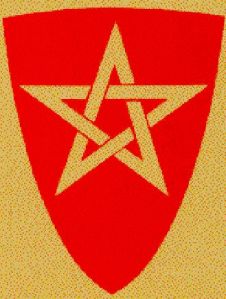 Celtic Symbolism : “The Pentacle” on the Medieval Poem “Sir Gawain and the Green Knight”
Celtic Symbolism : “The Pentacle” on the Medieval Poem “Sir Gawain and the Green Knight”
“Then they showed forth the shield, that shone all red,
With the pentangle portrayed in purest gold.
And why the pentangle is proper to that peerless prince
I intend now to tell, though detain me it must.”
(Sir Gawain and the G. K. 2.619-623).
An anonymous contemporary of Geoffrey Chaucer wrote Sir Gawain and the Green Knight in the 14th century, outlining an adventure of Sir Gawain, a knight of King Arthur’s Round Table. Gawain represented the perfect knight, as a fighter, a lover, and a religious devotee.
It was written in a Northern dialect and uses alliteration similar to the Anglo-Saxon form of poetry. Alliteration is characterized by the repetition of consonants and a sharp rhyme at the end of each section.
The story begins as King Arthur’s court celebrates the New Year for fifteen days. The lords and ladies of the court are having a great time dancing and feasting. The story describes the lavishly served feast with all the trimmings. Each guest is free to partake in the royal meal. However, King Arthur will not eat on such a high holiday until someone tells a fascinating or adventurous tale.
planet venus-geocentric-2016-2023:
-Successive inferior conjunctions of Venus against the Zodiac form a Pentagram.
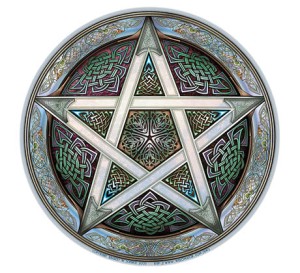 The Pentacle’s “Five-ness” of Moral Virtues
The Pentacle’s “Five-ness” of Moral Virtues
In Sir Gawain and the Green Knight the narrator employs the pentangle to illustrate the central conflict within the story, which is Gawain’s inner fight, rather than his ordeal with the Green Knight.
Each of the five points of the pentangle represents a set of Gawain’s virtues: his five senses, for he is “faultless in his five senses;” his five fingers “Nor found ever to fail in his five fingers;” his fidelity, “his fealty … fixed upon the five wounds that Christ got on the cross;” his force, “founded on the five joys / That the high Queen of heaven had in her child;” and the five knightly virtues: friendship, generosity, courtesy, chastity, and piety (lns. 640-54). Read more here


Prayer of Intercession to Saint George:
Faithful servant of God and invincible martyr, Saint George; favored by God with the gift of faith, and inflamed with an ardent love of Christ, thou didst fight valiantly against the dragon of pride, falsehood, and deceit.
Neither pain nor torture, sword nor death could part thee from the love of Christ. I fervently implore thee for the sake of this love to help me by thy intercession to overcome the temptations that surround me, and to bear bravely the trials that oppress me, so that I may patiently carry the cross which is placed upon me; and let neither distress nor difficulties separate me from the love of Our Lord Jesus Christ. Valiant champion of the Faith, assist me in the combat against evil, that I may win the crown promised to them that persevere unto the end.

 One would suspect that if the Goddess were going to show up with the divine son, it would be either at his death or resurrection. Curiously, at the crucifixion and resurrection, as recorded in the Gospels, Jesus is only attended by females. It is only Mary Magdalene and Mary the mother of James (Matthew 27.56) who, after his crucifixion, anoint him on the day of his resurrection (Mark 16.1) and are thus the first to see him rise from the sepulcher, which also happens to be in a garden (John 19.41). In the Gospels of Matthew, Mark, and Luke, moreover, there is a peculiar band of women who always stand witness of the crucifixion, while in the Gospel of John this band of female attendants is replaced by three Marys: Mary Magdalene; Mary, the Mother of Jesus; and her sister, also named Mary (John 19.25); a unique picture as the Mother Goddess is not only represented by two sisters but also by three women who represent youth, motherhood, and old age.
One would suspect that if the Goddess were going to show up with the divine son, it would be either at his death or resurrection. Curiously, at the crucifixion and resurrection, as recorded in the Gospels, Jesus is only attended by females. It is only Mary Magdalene and Mary the mother of James (Matthew 27.56) who, after his crucifixion, anoint him on the day of his resurrection (Mark 16.1) and are thus the first to see him rise from the sepulcher, which also happens to be in a garden (John 19.41). In the Gospels of Matthew, Mark, and Luke, moreover, there is a peculiar band of women who always stand witness of the crucifixion, while in the Gospel of John this band of female attendants is replaced by three Marys: Mary Magdalene; Mary, the Mother of Jesus; and her sister, also named Mary (John 19.25); a unique picture as the Mother Goddess is not only represented by two sisters but also by three women who represent youth, motherhood, and old age.
At Eleusis, the Mother Goddess was represented by Persephone, Demeter, and Hecate.
Dionysus was also represented by three female attendants; when a new sanctuary of Dionysus was founded “three priestesses called maenads would go there to establish the cult. Each one of them would assemble one of the three women choirs that helped celebrate the Mysteries” .
It is a supreme curiosity that at the crucifixion of the Savior none of the twelve apostles are present, and the whole affair is overseen by a retinue of female attendants. There is one obscure reference in John 19.26 where the mother of Jesus is at the cross, attended by a “disciple, standing by, whom [Jesus] loved.” Christian tradition believes this “beloved disciple” to be John the apostle, but this conclusion is circumstantial. This unidentified disciple remains unspecified, and belongs in the background with the soldiers and priests. It is only Mary and the women who attend to the crucified Jesus. Even so, at the resurrection none of the apostles are present, and the first to witness the true day of Easter was a woman or group of women to whom the knowledge of life after death was first given.
The Gospels are a far cry away from modern Protestantism, who would crowd these scenes with popes, priests, apostles, and kings. Protestantism lost something essential when it exiled Mary from all of its iconography and symbolism. This male dominated ethos was never part of the original revelation that is Christ, and in the Gospels we are poignantly reminded that it is the Mother who stands as the central image around the dying and resurrecting Jesus.

The Death and Rebirth of the Goddess
In most textbooks addressing the subject, the subordination of the Mother Goddess begins with the Aryan invasions into the fertile crescent and beyond, where war gods conquered peaceful goddesses, either by execution or marriage. While no doubt there is much truth to this, there are additional factors that are no longer seen from our viewpoint. How did the introduction of writing, for example, influence male and female mythologies? If the divine feminine resided in the secret, oral rites of the cave, and if the new possessors of writing were the male priests of the temple, what would be the consequences of the expansion of writing? Would not this new technology subordinate the oral traditions underneath reed and quill? It is normally asserted that the male gods of the nomads conquered the female goddesses of the fields; but the expansion of civilization depended entirely upon agriculture to support the newly burgeoning populations of the city-states. One would suspect that the necessary increase in agricultural production would establish the goddess as the ruler of the city? Yet, the opposite seems to occur, and one guesses that it is not the war gods that conquer the goddesses, but the literate pantheon of bureaucrats who take charge, with a stylus in one hand and a mace in the other.
Monotheism is the real death-nail to the Goddess. The Bible certainly makes it clear that the introduction of Yahweh, the one true god, was a long and hard fought process. In later centuries, however, the conversion to monotheism is swift and absolute. Egypt had thousands of gods and goddesses, yet its people convert to Christianity in just over a century. This was not due to a “forceful takeover.” Polytheism seems to have become so complex, burdensome, and exhausted, that the new faith of one savior-god appears to have been more than enticing. In other words, the diminishment of the Goddess is a varied and complex historical process.
Even so, the human psyche always demands balance. Centuries of culture centered around a male, monotheistic god will produce, by human nature alone, a resurgence of the feminine divine. Like the diminishment of the Goddess, the process of her rebirth will probably take centuries to unfold, with many uneven turns in the road. Nor will her reestablishment mean
a peaceful and harmonious era. One thing is certain, however, in the age of ego-centric, hypermaterialism, her presence is sorely missed. Ironically, until she is reborn, the male, monotheistic gods must carry her torch for her. When she reappears, it will be at their pleading.
The Tale of the Easter Bunny
 The ancient Germanic tale of the Easter Bunny tells us that the goddess Ostara wanted to save a young bird. However, her help came too late. Then, this goddess turned the bird into a special bunny, who was still able to lay eggs, but only on one day a year, namely on the day on which Ostara was honored.
The ancient Germanic tale of the Easter Bunny tells us that the goddess Ostara wanted to save a young bird. However, her help came too late. Then, this goddess turned the bird into a special bunny, who was still able to lay eggs, but only on one day a year, namely on the day on which Ostara was honored.
The fact that we still celebrate Easter with the Easter Bunny and Easter Eggs clearly demonstrates the Germanic origin of this ancient festival. The German name for Easter is Ostern. Both in English and German, ignorant people are fooled by convincing them that this name is related with the direction of East (or Osten in German), but that is absolute nonsense. The truth is that both names are derived from the Germanic goddess called Ostara or Eostre. Nowadays, we call this goddess Venus.
But Venus was not always visible as a twinkling star. Before she ended up in her current stable orbit, she flew around our solar system like a rampaging comet, which were her days as a (free) bird. However, once she arrived in her current orbit, she turned into a running-around bunny. Therefore, not only the Enuma Elish tells us the true historical story of Venus, so does also the Germanic tale of the Easter Bunny. Furthermore, the (colored) eggs that we got today from this Easter Bunny represent the fertile emanations which Venus pours over us, during today’s celebration of the Feast of Ostara. see also The Enuma-Elish Version 2
The goddess Ostara, which was named Ishtar by the Babylonians, and later Astarte by the Phoenicians. In each of these ancient names, we pronounce the word ‘star’, and that is no coincidence. In phonetic Greek, the word ‘star’ is ‘asteri’, with ‘ster’ in the middle, which is Dutch for ‘star’. Furthermore, what verb do we use in our language to describe a long and fixed look at the stars? No, you really do not know this? What about ‘stare’? And the most beautiful star to star-e at is of course Venus, the brightest star light of the night!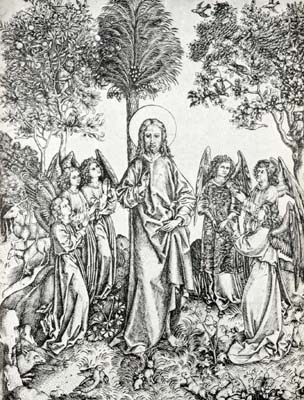 Jesus and the nine white Bunnies – Martin Schongauer 1453
Jesus and the nine white Bunnies – Martin Schongauer 1453
The ancient Greeks called this beautiful light in the night sky Aphrodite. In Latin, this name was changed into Aphrillis. The name of the Roman month in which the vast majority of celebrations of the Feast of Ostara fall is Aprilis, which is a further alteration of this Roman name of Venus. In our language, the name of this month became ‘April’. Therefore, April means ‘the month of Venus’. This is the yearly day on which the legendary Easter Bunny overwhelms us with the fruitful emanations of spring! Are you still not convinced?

Easter egg tree
The tradition in Germany to decorate the branches of trees and bushes with eggs for Easter is centuries old, but its origins have been lost. The egg is an ancient symbol of life all over the world. Eggs are hung on branches of outdoor trees and bushes and on cut branches inside.
In the meantime we know that bunnies definitely do do not lay eggs, but as a supplier in any case chicken and other poultry are possible. It is also true that the colored eggs have a cultural history are older to settle than the Easter Bunny. The egg is in many cultures as a symbol of fertility. The early ones Christians of Mesopotamia painted eggs red to reflect that to remember the blood of Jesus. In Christian theology applies the egg as a symbol of the resurrection. Just like Jesus at opened the rock grave during his resurrection, the eggshell breaks through when new life is hatched. 
In the Background or as a border motif of pictures of Mary the egg is occasionally found as an indication of the virgin birth. In the following, the question of why the use of eggs is to be investigated or, in particular, of colored Easter eggs at Easter became a popular tradition. It is historically known that eggs have been a natural product for Easter since ancient times assigned purpose. Among other things, they were part of the necessary gifts of the tenant to his landlord as interest in kind and duty obligations Due to the fact that in the Middle Ages it was Christians during the 40-day period It was forbidden to eat eggs during Lent, as chicken eggs were considered meat, this caused an egg surplus everywhere.
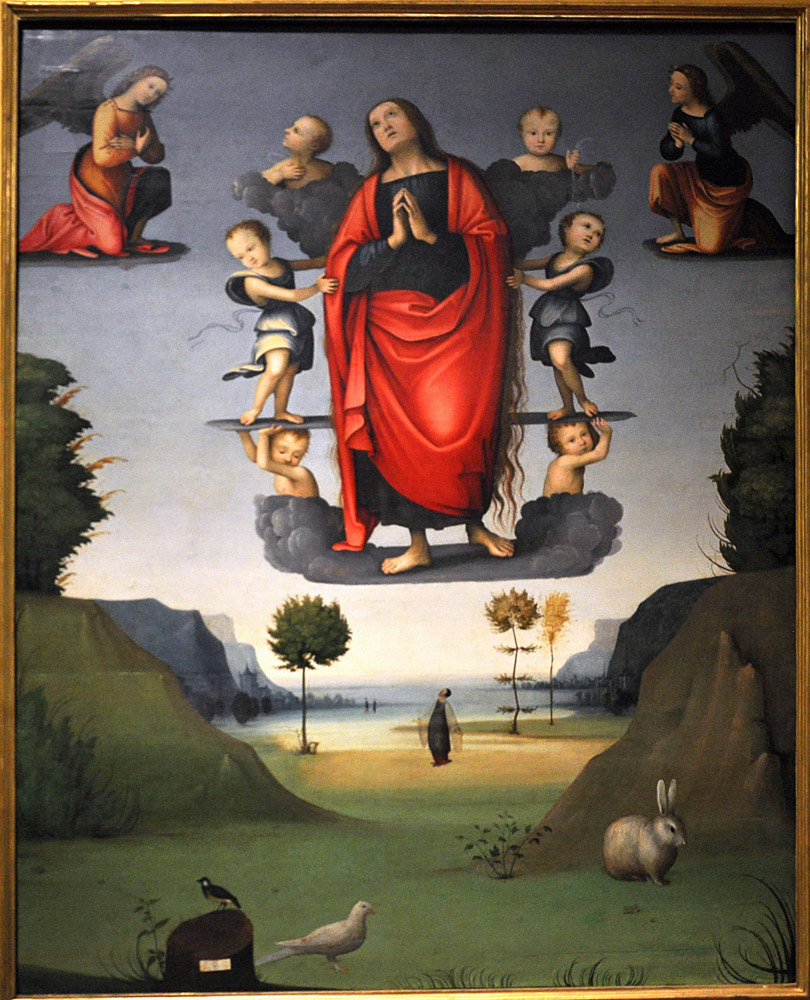
Master of the Assumption of the Magdalene, Assumption of Mary Magdalene, ca. 1506-1507
The Easter fountain 

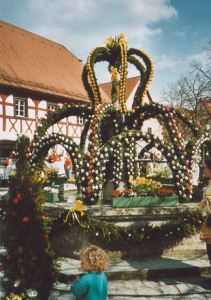 If you drive through the Usinger Land during Easter time, you will sometimes find yourself in the villages Easter decorated fountains. Originally from Franconian Switzerland originating this custom of decorating public village fountains with colorful Easter eggs and other decorations as Easter fountains has meanwhile also spread in our region in germany.
If you drive through the Usinger Land during Easter time, you will sometimes find yourself in the villages Easter decorated fountains. Originally from Franconian Switzerland originating this custom of decorating public village fountains with colorful Easter eggs and other decorations as Easter fountains has meanwhile also spread in our region in germany.
Pentecost Laubmännchen
The feast of Pentecost, on which the coming of Jesus Christ announced of the Holy Spirit is celebrated, at the same time stands for the ritual conclusion of the Easter season. On These days of Pentecost have – outside of the Christian festivities – an ancient one, the new one Preserve the life force of nature symbolizing popular custom is the tradition of the Laubmännchen ( Foliage male ).




The Green Man and the Wild Man
 Green is etymologically related to growth. What is green is growing and fertile. It will develop and develop. However, green also means naive and inexperienced. An inexperienced boy is a ‘greenhorn’; a rookie. He is compared here with the young green leaf. They say he is ‘not yet dry behind the ears’, or else: ‘he is still green behind his ears’. The Green man is young, full of vigor and potency and still has to ‘ outgrown’, so be initiated into the secrets of the adult world.
Green is etymologically related to growth. What is green is growing and fertile. It will develop and develop. However, green also means naive and inexperienced. An inexperienced boy is a ‘greenhorn’; a rookie. He is compared here with the young green leaf. They say he is ‘not yet dry behind the ears’, or else: ‘he is still green behind his ears’. The Green man is young, full of vigor and potency and still has to ‘ outgrown’, so be initiated into the secrets of the adult world.
Hereby a number of folk rituals and parades in which a man covered in leaves was carried away. These rituals were held at different places in Europe during the mornings. See The Green Man and the Wild Man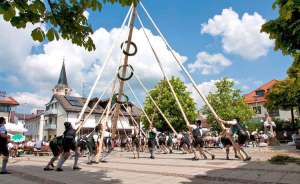
Look also Green Man, May Day and May Pole
Ostrich Egg
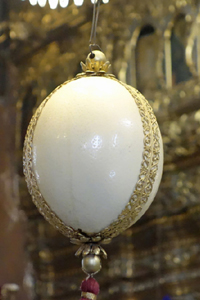
This is probably the most noticeable of the four symbols. Did you know that eggs or images of eggs appear in all sorts of religious architecture? In the ancient world, and at present day, one will find them symbolizing various things. The Romans attached great value to ostrich eggs, and freely used them to decorate their homes and temples. Muslims even use ostrich eggs atop minarets in the Western Sudan, to signify fertility and purity. In Egypt these eggs are occasionally found as well, such as at the tomb mosque of Kait Bey. Use of the ostrich egg by Islam is said to have acquired its origins from Christians in the Middle East, with many pointing to the Copts as the source.

In Christendom, eggs bear significant symbolism for many denominations. Obviously you think of eggs when it comes time for Easter, as a symbol of the resurrection because the small chick breaks from the egg at its birth, just as Christ broke forth form the tomb. The egg, like the seed, contains the promise of new life and hope. It also can represent chastity and purity, since the chick is protected within the shell. The Greeks decorate their churches with plain and ornamented eggs, hanging them in festoons, or suspending them singly from any convenient hook. For them, the ostrich egg is considered good luck, a belief inherited from the ancient Greek, who taught that if man were not watchful over his own soul it would grow bad, even as the egg addles when it is neglected.
In the Coptic Church, many churches hang an ostrich egg just above the main sanctuary door. The Copts differentiate the ostrich egg from all others as bringing to mind the remarkable and ceaseless care with which the parent birds guard their eggs. The vigilance of the ostrich is meant to remind the believer that their thoughts should be fixed continually on spiritual things.
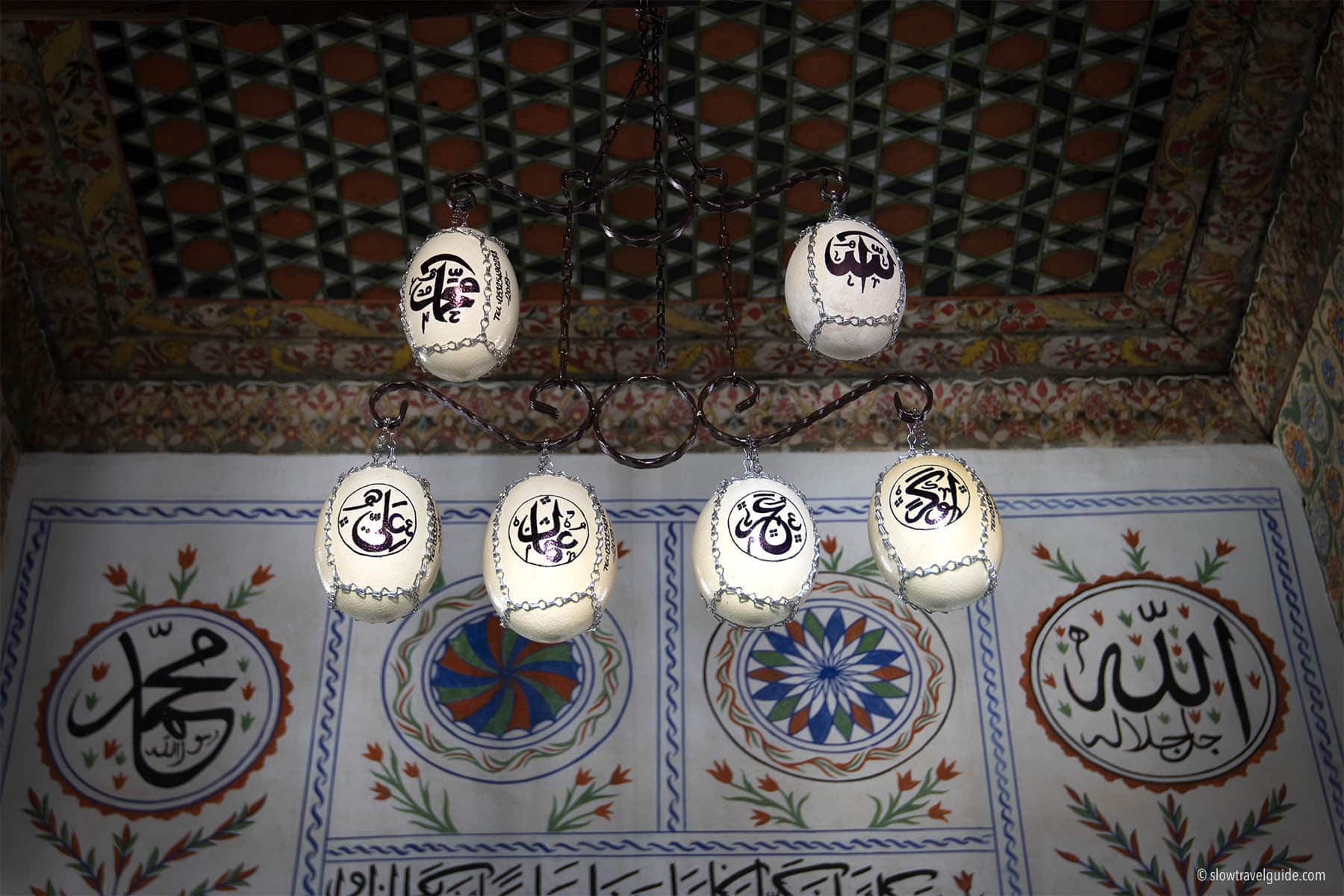
- Green Thursday – Maundy (foot washing)
Maundy (from Old French mandé, from Latin mandatum meaning “command”),[1] or the Washing of the Feet, or Pedelavium,[2] is a religious rite observed by various Christian denominations. The Latin word mandatum is the first word sung at the ceremony of the washing of the feet, “Mandatum novum do vobis ut diligatis invicem sicut dilexi vos“, from the text of John 13:34 in the Vulgate (“I give you a new commandment, That ye love one another as I have loved you”, John 13:34). This is also seen as referring to the commandment of Christ that we should imitate His loving humility in the washing of the feet (John 13:14–17). The term mandatum (mandé, maundy), therefore, was applied to the rite of foot-washing on this day of the Christian Holy Week, the Thursday preceding Easter Sunday, called Maundy Thursday.
John 13:1–17 recounts Jesus‘ performance of this act. In verses 13:14–17, He instructs His disciples:
If I then, your Lord and Teacher, have washed your feet, you also ought to wash one another’s feet. For I have given you an example, that you should do as I have done to you. Most assuredly, I say to you, a servant is not greater than his master; nor is he who is sent greater than he who sent him. If you know these things, blessed are you if you do them.
— John 13:14–17 (NKJV)

- Christ’s Resurrection and our Redemption: A Mytho-Psychological View of Easter
To get right to the point, from the mytho-psychological and spiritual perspectives, the life and teachings of Jesus together with his suffering and resurrection can be understood as portraying the integration of our total psyche (the “Self”), specifically the integration of the unconscious part of our psyche with the conscious part (ego consciousness, here called the “self” (uncapitalized)). Carl Jung called this the “individuation” process, which results in a person reaching a higher level of consciousness and self-awareness, and being more advanced spiritually. Psychologically, this endeavor can be termed “religious” because at the deepest and most basic level of our collective (transpersonal) unconscious lies an archetype of unity and totality that Jung calls the “God” (or Self) archetype, which produces a “God-image” in ego consciousness that is comprehensible to us and is the closest we can get to comprehending God. The God archetype is the most fundamental source of our numinous experiences of “divinity” that have a lasting emotional impact on us and drive much of our thinking and behavior, including in the individuation process. This happens in everyone, atheists included, and it is this unconscious realm that mystics from various religious and non-religious traditions access during their sacred experiences.
Jung held that there was a long historical period of evolution and preparation before ancient Mediterranean culture could reach the point where the Christ figure could emerge in myth to represent the individuation process and resonate with people’s psyches so that Christianity could emerge, become viable, and even dominate that culture. As Jung observed, “If ever anything had been historically prepared, and sustained and supported by the existing Weltanschauung, Christianity would be a classic example.” It is important to outline these developments here.
The process actually begins with the creation of the cosmos as depicted in myths. Myths typically depict the creation as a process of formless, unordered chaos being transformed into order, resulting in differentiation, multiplicity, and opposites (dark/light, heaven/earth, god/human, good/evil, male/female, etc.). This motif is actually a reflection in myths of the evolution of human consciousness to a higher stage of being, i.e., to a developed ego consciousness (self) that enables us to make distinctions and see opposites. (Neumann, 2-38) As the psychologist Marie-Louise von Franz put it, such myths “describe not the origin of our cosmos, but the origin of man’s conscious awareness of the world.” This process of rising consciousness is evident in the biblical Garden of Eden creation myth in which Adam and Eve gained the “knowledge of good and evil,” meaning that they became able to distinguish opposites (good/evil, male/female, naked/clothed) and therefore were ready to function outside the Garden in civilization. As Joseph Campbell put it, “The Garden is a metaphor for the following: our minds.” We must bear this in mind when we see St. Paul and other early Christian writers describe Christ as the “second Adam” who symbolized a second transformation of human consciousness.

Description: This image precedes the liturgy for the feast of Corpus Christi in a missal created for the Archbishop of Salzburg. The central roundel depicts a tree that bears both fruit and sacramental hosts. It thus combines the paradisaical Tree of Life and the Tree of Knowledge from Eden. On the right is Eve, who hands a forbidden fruit to a man kneeling at her feet. A death’s head appears among the fruits on her side of the tree. The tempting serpent winds around the trunk, and offers Eve another piece of fruit from its mouth. On the left side is Mary-Ecclesia. Rather than a death’s head, a crucifix hangs on this side. Instead of fruit, Mary-Ecclesia administers one of the hosts to a kneeling man who opens his mouth to accept it, and she is in the process of plucking yet another wafer. She is presented as a mirror image of Eve and thus the salvific antidote to the Fall. An angel accompanies Mary-Ecclesia on the left and Death accompanies Eve on the right. Both hold banderoles bearing text. Adam reclines in a gesture of sorrow at the base of the tree and also holds a banderole. In the upper two roundels are princely figures who hold banderoles bearing the text of Psalm 77:25 on the left ( ” Man ate the bread of angels: he sent them provisions in abundance”).and Psalm 36:16 on the right ( “Better is a little to the just, than the great riches of the wicked”). Three shepherds depicted below illustrate Thomas Aquinas’s Corpus Christi sequence “Lauda ducem et pastorum,” but they also embody the virtues expected of a good ruler. The one on the left is the personification of “Prudentia,” the one in the center is “Regalitas,” and the one on the right is “Verus Pastor.” All are accompanied by banderoles.
While humans were gaining in consciousness, however, Israel’s god Yahweh was temperamental, impulsive, and unpredictable. While sometimes loving and merciful, he was just as easily unjust and cruel and often changed his mind, reflecting a lack of self-awareness and a failure to consult his own omniscience. He violated many of the Ten Commandments. And he broke his Davidic Covenant in which he had promised that a descendant of David would forever be king over Israel; instead came the Babylonian captivity. Accordingly, Jung described Yahweh as “unconscious,” and specifically as having a dark, shadow side that was not integrated into his consciousness. He was not meaningfully aware of the opposites within him and they were not integrated, so he lacked control. Yahweh needed to better himself. Eventually many people grew tired of this and started to doubt Yahweh, because their own consciousness had outgrown that of their own god. Yet Yahweh needed humankind (its consciousness) to uphold his identity, to the point where he would need and want to share in being human. This represented our own restless unconscious seeking to make itself more conscious.
The turning point came when Yahweh let his shadow side (Satan) mistreat Job, who then protested Yahweh’s injustice, inflicting moral defeat on Yahweh from which he would never recover his old form. His wisdom became personified as feminine Sophia, needed by Yahweh for self-reflection and to accommodate to some extent the feminine side of the psyche. Also, in the books of Ezekiel, Daniel, and 1 Enoch, Yahweh drew closer to humanity as his consciousness developed, being represented in each of these books by quaternity symbolism of the Self, and each of these books featured the “Son of Man” figure, an outgrowth of Yahweh embodying wisdom and righteousness, an intimation that Yahweh’s incarnation lies in the future ; the gospels later would call Jesus the Son of Man. The figure of Satan became distanced from Yahweh, which mytho-psychologically speaking would inevitably require a counterpoising mythical figure of goodness, justice, and love. In short, Yahweh’s divine qualities were becoming differentiated, changing from an unconscious totality of all divinity into distinct conscious opposites represented by corresponding mythical figures.
Meanwhile, in the everyday human world, by the time of Jesus people in Palestine were dominated by the Roman military and governmental machine on the one hand, and by a strict and dry Jewish legalism managed by an aloof and corrupt priesthood on the other. People were taxed by both, monetarily and spiritually. Both trends were manifestations of ego consciousness run rampant, to the point where too many people’s lives had lost touch with the unconscious psychic energy that is the source of spirituality (in Christianity symbolized and carried by the Holy Spirit) and ultimately with the archetypal God-image; consciousness and the unconscious had become dissociated. The result was what psychologists term a “loss of soul” , which is the initial reaction to the unconscious reaching out to make itself felt by ego consciousness. Hopefully the end result of the process would be the integration of the Self. In 1st century Palestine, this process manifested itself mythologically as Yahweh inserting himself into humanity, resulting in the mythical figure of the God-man.
Thus, as Jung observed, the Christ figure is a symbol of the Self. But we must be careful here. As Jung also recognized, Christ is not a “snapshot” of anyone’s entire Self at any point in time. The deity now having split into various aspects, the Christ of the gospels represented only light, consciousness, goodness, love, and justice, lacking both the feminine element and any dark side, elements carried by Mary (in part) and Satan respectively. Rather, Christ was a mediating figure who represented the Self as it goes through the dynamic process of the incarnation of “God” coming from the unconscious into consciousness, spirit into body, as the Self becomes integrated and a person individuates. While in Christian tradition Christ’s appearance was literalized as a one-time historical event, mythologically and psychologically the implication is that incarnation can occur in any and all of us. Indeed, we see other versions of incarnation in other religious traditions, which suggests that the process of incarnation of the “divine” is an archetypal psychic process. Thus, in ancient Egypt the king was the god Horus born to a mortal woman, and in India Vishnu incarnated at times of need, while a Bodhisattva incarnated in order to liberate humanity.
Take, for example, Jesus’s saying in Matthew 18:4, that “unless you change and become as little children, you will never enter the kingdom of heaven” (likewise Mark 10:15; Luke 18:17; Gospel of Thomas 22, 46.2). Mark’s gospel provides a larger narrative context for this metaphor of integration. The enacted parable of “the child amongst” in Mark 9:33-37 can be read according to this psychological framework. In verse 34 the disciples’ egos seeking greatness and preeminence are driving their behavior and hindering their spiritual growth. So Jesus teaches them that if anyone would be first, he first must be last and be a humble servant. (In the ancient household, where this scene takes place, a child has the lowest status; also, in a young child the ego is not dominant and so is more integrated with the unconscious, so the child archetype represents the potential for wholeness of the Self.) So as Jesus the God-man visually embraces a child in a house, he teaches that a person first must identify oneself with a child and in an important sense become mentally like one, with the ego having no pretensions to greatness. Being a good and humble servant means being faithful to one’s principal, which in this case is Jesus and ultimately God, who originates in the God-image. Psychologically, the story shows the need to tame ego consciousness by becoming like a child, which through incarnation enables the divine (God, unconscious content) to integrate with the self so that self-aware individuation can occur. This can establish a new pattern for human relationships that will leave no occasion for strife, which is what at the beginning of this story had been occurring among the disciples.
Easter Walk: “Here i am Man , here dare i to Be”

The inevitable consequence of unconscious content confronting ego consciousness in the integration (incarnation) process is suffering, suffering of our ego consciousness (the self) as it cedes some of its position of preeminence and is transformed by unconscious content. The old self is “crucified” and then, as it transforms, it is “resurrected” into higher level of consciousness, resulting in a more integrated and “redeemed” Self. Easter. Springtime.
May we all celebrate a fruitful and happy Easter!

Arma Christi (“weapons of Christ”), or the Instruments of the Passion, are the objects associated with the Passion of Jesus Christ in Christian symbolism and art. They are seen as arms in the sense of heraldry, and also as the weapons Christ used to achieve his conquest over Satan. There is a group, at a maximum of about 20 items, which are frequently used in Christian art, especially in the Late Middle Ages. Typically they surround either a cross or a figure of Christ of the Man of Sorrows type, either placed around the composition, or held by angels.

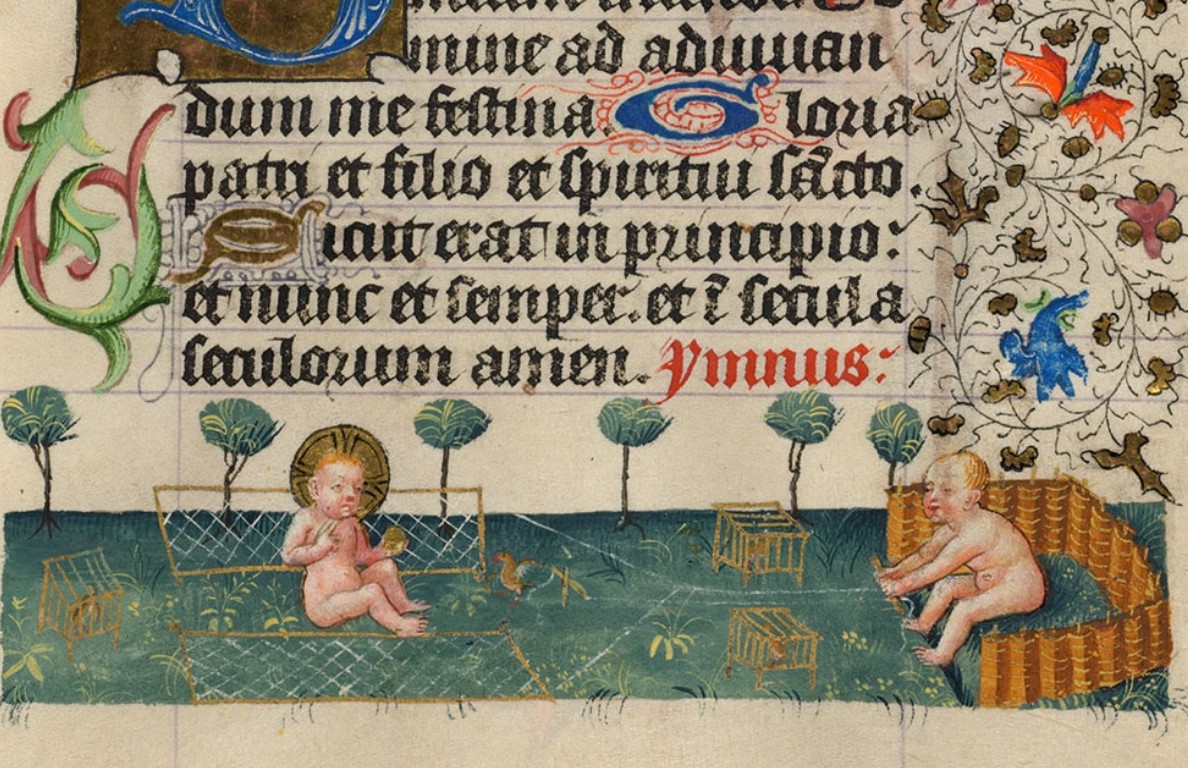
- Moon rabbit
The  moon rabbit or moon hare is a mythical figure who lives on the Moon in Far Eastern folklore, based on pareidolia interpretations that identify the dark markings on the near side of the Moon as a rabbit or hare. The folklore originated in China and then spread to other Asian cultures. In East Asian folklore, the rabbit is seen as pounding with a mortar and pestle, but the contents of the mortar differ among Chinese, Japanese and Korean folklore.
moon rabbit or moon hare is a mythical figure who lives on the Moon in Far Eastern folklore, based on pareidolia interpretations that identify the dark markings on the near side of the Moon as a rabbit or hare. The folklore originated in China and then spread to other Asian cultures. In East Asian folklore, the rabbit is seen as pounding with a mortar and pestle, but the contents of the mortar differ among Chinese, Japanese and Korean folklore. 
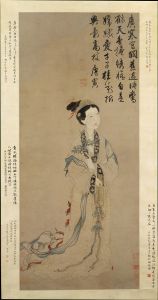
In Chinese folklore, the rabbit often is portrayed as a companion of the Moon goddess Chang’e, constantly pounding the elixir of life for her and some show the making of cakes or rice cakes; but in Japanese and Korean versions, the rabbit is pounding the ingredients for mochi or some other type of rice cakes. 
In some Chinese versions, the rabbit pounds medicine for the mortals and some include making of mooncakes. Read more Here

Unrelated or well moon folklore from certain native cultures of the Americas also has rabbit themes and characters.
 The traditional Mayas generally assume the Moon to be female, and the Moon’s perceived phases are accordingly conceived as the stages of a woman’s life. The Maya moon goddess wields great influence in many areas. Being in the image of a woman, she is associated with sexuality and procreation, fertility and growth, not only of human beings, but also of the vegetation and the crops. Since growth can also cause all sorts of ailments, the moon goddess is also a goddess of disease. Everywhere in Mesoamerica, including the Mayan area, she is specifically associated with water, be it wells, rainfall, or the rainy season. In the codices, she has a terrestrial counterpart in goddess I.
The traditional Mayas generally assume the Moon to be female, and the Moon’s perceived phases are accordingly conceived as the stages of a woman’s life. The Maya moon goddess wields great influence in many areas. Being in the image of a woman, she is associated with sexuality and procreation, fertility and growth, not only of human beings, but also of the vegetation and the crops. Since growth can also cause all sorts of ailments, the moon goddess is also a goddess of disease. Everywhere in Mesoamerica, including the Mayan area, she is specifically associated with water, be it wells, rainfall, or the rainy season. In the codices, she has a terrestrial counterpart in goddess I.

The Aztecs had a legend to explain it . A very short version in the Florentine Codex (right) reads: “The myth of the rabbit in the moon goes as follows: The gods, they say, were teasing the moon and flung a rabbit in its face. And the rabbit remained marked on the moon’s face. That is what darkened the face of the moon, as though it had been bruised. Upon which the moon went out to light the world.”
Here a lovely version on our Aztec legend: In the years that passed men realised that they enjoyed a beautiful Sun during the day, but they feared the darkness of the night. And so, according to the legend, the son of Chicovaneg set out on another journey to create for mankind a lesser Sun, one exclusively for the night. And here is what the legend tells of that feature …
 When the son of Chicovaneg grew up, the men of his tribe called him Huachinog-vaneg because he dreamed so much, and because his thoughts were more often in the sky with his father than on earth with his people. Often for long hours he sat in the shade of a tree, sad-faced and lost in meditation.
When the son of Chicovaneg grew up, the men of his tribe called him Huachinog-vaneg because he dreamed so much, and because his thoughts were more often in the sky with his father than on earth with his people. Often for long hours he sat in the shade of a tree, sad-faced and lost in meditation.
One day his mother Lequilants found him thus. “My son,” she said, “why is it you are so sad? Everywhere people are happily rejoicing in th Sun your father gave them.”
Huachinog-vaneg arose, bowed before his mother, put his face over her hand in greeting, and said, “Oh, my beloved and honoured mother, and why should I not be sad? My father did great deeds on earth and in the skies. I feel unworthy of my father and of you.”
“My son,” she told him, “you, too, are a creator. Do you not create beautiful houses out of stone, with sand and lime, so that people may live secure from storms and wild beasts?”
”It is true,” the son replied, “but I have taught many to build as perfectly as I do. And time will decay these houses and also the temples and high pyramids I have built. After several summers no person will remember the one who built them – or even his name.”
 Whereupon the mother said, ‘My son, not all men can create a new Sun, but there is ever a need for houses to be built, for fields to be tilled, mats to be woven, pots and plates to be made and fired, and trees to be planted. For if all this were not done, of what use would be the perfect Sun in the sky?’
Whereupon the mother said, ‘My son, not all men can create a new Sun, but there is ever a need for houses to be built, for fields to be tilled, mats to be woven, pots and plates to be made and fired, and trees to be planted. For if all this were not done, of what use would be the perfect Sun in the sky?’
’Honoured mother, you speak wisely. But you are a woman, while I as a man, with different ways and other thoughts, am driven on by ambition. Many times when I have sat alone, under a tree, I have spoken to my father. Know that it is my ardent wish to go to him.’
To this Lequilants said: ‘No mother, no wife or lover has the strength to prevent a man of strong mind from doing what he earnestly desires to do. Take me to the house, my son. Let me lean upon your arm, for now I feel my years.’
The son saw his mother to the house. She put out the light of the pine-wood torch and covered the embers on the hearth with ashes. But Huachinog-vaneg left the door open so that he might see the stars.
’Come here, my son,’ said his mother, ‘and sit beside me. I am afraid of the dark tonight as every night.’
’Do not be afraid, mother. I am with you.’
’Yes, my son, and I am glad. But there are mothers who have lost their sons, and mothers who are alone because their sons are far away, and there are those who never had a son. All are afraid of the dark night – as I am afraid when you are not here.
‘I have thought at times that the people of earth also need a Sun at night. But who could create a Sun for the night only? It would be more difficult I think that it was to create the Sun for the day. The kindling of the Day Sun needed great courage, but only a man who is truly clever could create a Sun of the Night. For think! Such a Night Sun must give light but not heat; otherwise no living thing could recov er from the day’s heat, and all life on earth must sleep and rest and gain strength for the coming day.’ Huachinog-vaneg pondered his mother’s words. ‘You are wise, my mother,’ he said. ‘It would indeed be difficult to create such a Sun for the night.’
’Imagine how difficult, my son!’ said Lequilants. ‘For the Night Sun must not disturb mankind, neither the animals and plants of the earth in their rest. Nor should it shine always with a full light. Rather, its light should increase and decrease gradually so that earth’s living things could grow accustomed to both light and darkness. And there should be nights on earth when the Night Sun disappears completely, so that people may know what true darkness means, and the usefulness of the stars and how satisfying complete stillness can be. How can any man on earth be clever enough to create such a Sun? Yet one dreams of such things as I often do.’
Said Huachinog-vaneg, ‘It is a beautiful dream, my mother, and I am happy you shared it with me.’
Time passed. One day Lequilants found her son sitting on the ground, sketching many rings in the soil.
She came to him and said, ‘What thoughts are you lost in my son? A new building, or what?’
’I have thought much about your dream of a Sun for the night,’ he told her, ‘and now I believe I have discovered the way to create it. There is a very wise and learned man who all his life has studied the paths of celestial bodies. I am sure that with his guidance I can create the Night Sun which the world needs – one that you and all people on earth would like to enjoy, one that will give light but not heat, one that will slowly grow and then become small again, one that will even disappear at times so that its existence will be more appreciated by men.’
Said Lequilants: ‘Go, my beloved son. My blessings are with you in all your wanderings and doings. Go and create a Sun of the Night so that mothers need not fear the darkness any longer. Should you meet your father, greet him for me and tell him that I think of him always in true love and admiration. When I look up in the dark sky and see that you have kindled the Sun of the Night, I shall know that my days are fulfilled, and that I can leave this earth as wife of the bravest man and mother of one of the cleverest men who ever lived.’
Huachinog-vaneg went first to the sage Nahevaneg, and asked him, ‘O Wise Man, where can I find the Serpent with feathers? I need his help for I seek to create a Sun for the Night.’

Nahevaneg replied: ‘The Feathered Serpent is the symbol of our world, and as there can be only one such symbol, there is only one Feathered Serpent. Your father freed the Feathered Serpent to help him create the Sun. And after the Sun was kindled, he ordered the Feathered Serpent to stretch itself around the world where the arc of the sky rests on the earth or the great ocean. And there the Feathered Serpent lies to this day guarding the world against the evil forces that live beyond, always and forever ready to destroy the world.
’Your father is not only brave but also cunning. He knows that the Serpent likes to drink deeply of the sweet dreams that flow along the horizon’s edge, streams of morning dew from flowers that grow, some at sunrise, some at sunset, streams that mix with star dust to make a sweet and heavy wine of strange power. How the star dust sparkles in this rare wine! And how the Serpent loves it! This wine at the world’s edge is the drink that alone can quench the Serpent’s thirst. So Chicovaneg descends at the end of each day to see that the Feathered Serpent has not taken too much of this ethereal wine.
’When Chicovaneg finds the Serpent awake and on guard, his radiant face paints the evening sky a golden red. But when he finds the Serpent asleep or drowsy with wine, he is angry, and his eyes flash like fiery wings dipping in and out of the dark evening sky. So you see, Huachinog-vaneg, the Serpent, busy as it is, cannot help you.’

As the sage was speaking, a rabbit came jumping along, nibbling eagerly at the lush cool grass growing near their feet.
’Take a rabbit along with you, son.’ said the sage. ‘A rabbit can leap, is a friendly companion, and can be of good use to you.’
Huachinog-vaneg accepted the sage’s counsel. He lifted the rabbit up by its ears and held it softly in his arms. Then he thanked Nahevaneg and bade him farewell.
Now Huachinog-vaneg set himself to the task of making two shields. As soon as he had found a convenient place to work he made a heavy shield to carry on his right arm. Then he made another of the fine silky fibres of the maguey plant. It was so light and wondrously woven that when he held it against the Sun, he could see the Sun like a dark disk behind it. This shield he did not fasten to either arm, but carried it first in one hand, then in the other. He had no need of a spear, for he meant to follow the golden road his father had built from which all evil spirits had been driven back into darkness. In that bright light and always in full view of his father, he need fear no enemies.
He provided himself also with a strong and long lasso, and when finally he was ready, he took his rabbit – Tul by name – and travelled to the end of the world.

 At the world’s end there was a deep cavern in which lived the great tiger Cananpale-hetic. This tiger came out of his cavern and said to Huachinog-vaneg: ‘Do not fear me, for understand, I am the world tiger. Here is the very spot from which your father started on his journey. It was here he hesitated, because he feared to jump to the lowest star. Here in his hesitation he stamped one foot, and then the other, treading so hard that this cavern was formed. I fled here, pursued by savage coyotes which the evil gods sent to destroy me. It was then Chicovaneg saved me from the coyotes, and offered me this cavern as a home. And he sent the Feathered Serpent to kill the coyotes, so I was left in peace to heal my wounds. Now I remain here for eternity, to protect the road from the earth up to the lowest star.
At the world’s end there was a deep cavern in which lived the great tiger Cananpale-hetic. This tiger came out of his cavern and said to Huachinog-vaneg: ‘Do not fear me, for understand, I am the world tiger. Here is the very spot from which your father started on his journey. It was here he hesitated, because he feared to jump to the lowest star. Here in his hesitation he stamped one foot, and then the other, treading so hard that this cavern was formed. I fled here, pursued by savage coyotes which the evil gods sent to destroy me. It was then Chicovaneg saved me from the coyotes, and offered me this cavern as a home. And he sent the Feathered Serpent to kill the coyotes, so I was left in peace to heal my wounds. Now I remain here for eternity, to protect the road from the earth up to the lowest star.
‘Rest here, Huachinog-vaneg, and gather strength for your difficult task. And your rabbit Tul may eat all it desires of the green prairie grass that lies around us.’
Huachinog-vaneg rested, and Tul ate well. Then together they climbed the rock Chabuquel.
Huachinog-vaneg looked at the lowest star and saw that it was too far away to reach in one leap. He became afraid and much discouraged, but Tul said, ‘I will go ahead and jump while you wait here. If I fall into the abyss of Balamilal, I alone will be lost. Find another rabbit then – there are many. I, myself, have a hundred and forty sons. You may select the strongest one, and tell him that I, his father, command him to follow you, and he will come.’
Then Huachinog-vaneg said, ‘Hear me well, Tul. We are friends, and I do not want to lose you. Let us wait here until the rock Chabuquel has grown a little more; then the jump to the lowest star will be easier than it is today.’
But the rabbit Tul replied, ‘My life is not so long as yours, Huachinog-vaneg. I cannot wait.’
And before Huachinog-vaneg could reply, the rabbit Tul had jumped. He fell back at first without touching the lowest star. But he tried again and again, and at last the tip of one of his long ears touched the star, and he struggled with his legs to get a foothold. A branch of a thornbush helped Tul to scramble onto the star. Then free of the thorns, he leaped up onto a high rock, jumping up and down until Huachinog-vaneg could see him. Huachinog-vaneg threw his lasso to the star; Tul caught it and fastened it onto the peak of a rock, and Huachinog-vaneg swung through space on the lasso and landed on the star.
Together in triumph they went to greet the inhabitants of this first star.
And thus did they wander from star to star, taking only tiny fragments from each one; for the Sun of the Night did not need to be as large or as bright as the Sun of the Day. To make a lesser and cooler light than that of the great Sun, Huachinog-vaneg tied each bit of star as it was given him to the lasso and let it down into the black void to cool off.
And Huachinog-vaneg said to Tul: ‘My Sun will not be as beautiful or as marvellous as the Sun created by my father; but the Sun I have almost completed is as my mother wanted it, sometimes great, sometimes thin, and sometimes invisible.’
‘How clever you are!’ said Tul. ‘How did you manage to do that?’ And Huachinog-vaneg showed him. He took the shield in his left hand and moved it slowly in front of the shield of the Night Sun which was fastened on his right arm. As the shade of the lighter shield moved across the heavier shield, the Night Sun became smaller and smaller until it was completely shadowed and only its darkened outline was visible. And slowly, slowly, Huachinog-vaneg moved the lighter shield along, letting the Sun-of-the-Night shield become larger and larger until it regained its full size.
When his mother looked up at the sky and saw this, she called her neighbours together, and said: ‘Now I can lie down and die in peace, for I have done my duty on earth. I have repaid the good earth for the life it granted me. I had a brave husband, and I bore him a son who was wiser and cleverer than he.’ Saying this, she bent down to earth, and died on her knees.
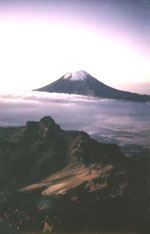
 The men of her tribe took her up to the highest mountain peak in the centre of the land, where she would be closest to her husband and her son. And the sky covered her body with a white mantle of eternal snow. The first ray that Chicovaneg sends to the earth each morning kisses her forehead before it reaches other people, and the last ray in the evening envelops her body in a red-gold glory.
The men of her tribe took her up to the highest mountain peak in the centre of the land, where she would be closest to her husband and her son. And the sky covered her body with a white mantle of eternal snow. The first ray that Chicovaneg sends to the earth each morning kisses her forehead before it reaches other people, and the last ray in the evening envelops her body in a red-gold glory.
Huachinog-vaneg journeyed steadily across the firmament bringing the light of the Night Sun to mankind. And so faithfully did the Night Sun make its changes that people on earth came to look to it for the order of the days and the hours and the months and the tides.
Once Huachinog-vaneg stumbled on his way and was late in his journey, and the people became confused in their accounting of the time. And so it is to this day.
Wherever Huachinog-vaneg went, the rabbit Tul leaped in his way, full of pranks and play. Now Tul was in front, now behind, and now between his legs; at last Huachinog-vaneg became impatient with Tul’s antics, and he said: ‘The people on earth will think that I stumble drunkenly across the heavens, and they will build no more temples to me and no pyramids, or any longer name days after me. It would be better for both of us if you went down to earth to join your family. You will live happily there, begetting perhaps a thousand more sons. I know that you love the nights more than the days, so when you wander at night longing to find the choicest cabbage leaves, I will send you the brightest light; my light will help you to see the coyotes or the wild cats who are after you. So I think it is time for you to go, Tul.’
Tul knelt before Huachinog-vaneg and blinked, his eyes moist with tears, as he said: ‘I learned long ago that human beings do not know gratitude, Huachinog-vaneg. But you are not part of the people any more; you are a god now and people build temples and pyramids on earth in your honour. Now to my surprise I learn from you that even gods know no gratefulness. And I hoped that your people on earth would make me half a god, if not a whole one, for I helped you reach your first star, and I have been a true friend and useful companion to you since the day we met for the first time.’
Huachinog-vaneg answered: ‘But don’t you understand? You are in my way, leaping and jumping as you do. So leap and jump back to earth, Tul. I thank you for your help. Anyway, perhaps I might have found my way without you.’
’I am not very sure of that,’ Tul replied. ‘For I remember too well how frightened you were, standing there by the cavern of the tiger, hopping from one foot to the other, afraid to make the leap. Now I’d have to jump from star to get back to earth from where we came, and my bones are old. If I fail in just one leap, I’ll fall into the bottomless void, and go falling forever. You couldn’t come to help me, now that your godly duty is to mark the times of the month and the year to people on earth.’
 ’Or perhaps I would arrive on earth – but with broken legs, unable to search for my food at night or for the hole in which I lived with my family, no matter how much light you sent me. I’d be unable to escape from the coyotes and dogs trying to catch me. And should an eagle spy me, I wouldn’t be able to sprint to a burrow before he’d swoop down and gobble me up. So, Huachinog-vaneg, like it or not, there’s no other remedy, I’ll leap around your legs as long as is good for my health.’
’Or perhaps I would arrive on earth – but with broken legs, unable to search for my food at night or for the hole in which I lived with my family, no matter how much light you sent me. I’d be unable to escape from the coyotes and dogs trying to catch me. And should an eagle spy me, I wouldn’t be able to sprint to a burrow before he’d swoop down and gobble me up. So, Huachinog-vaneg, like it or not, there’s no other remedy, I’ll leap around your legs as long as is good for my health.’
Angered by these words, Huachinog-vaneg grabbed Tul by his long ears and lifted him to hurl him forevermore into the black void of Balamilal. But Tul turned his face to Huachinog-vaneg, grinned and blinked, and cheerfully kicked his legs above the black void to show he was not afraid. And seeing those great kicking legs Huachinog-vaneg suddenly remembered how this rabbit had leaped out into space for him, risking his life every time, over and over, so that he, Huachinog-vaneg, could beome a god. And gratefulness rose up at last in his heart.
He embraced Tul and said to him: ‘You shall stay with me forever. I will put you in the middle of my great shield and carry you around with me on my trips across the firmament. And the people down on earth shall see you there for ever and ever in the very centre of my shield.’
Then Huachinog-vaneg removed some of the little star-fragments from the middle of his big shield and set the rabbit Tul there, where he can be seen to this day.
And this is how the rabbit Tul became part of the Mexican people’s calendar, as a grateful reminder of his help in kindling for them the glorious Sun of the Night
.
- Holi festival
Holi ( /ˈhoʊliː/) is a popular ancient Hindu festival, also known as the “Festival of Love”, the “Festival of Colours”, and the “Festival of Spring”.
 The festival celebrates the eternal and divine love of Radha and Krishna.[9][10] It also signifies the triumph of good over evil,[11][12] as it celebrates the victory of Lord Vishnu as Narasimha Narayana over Hiranyakashipu.[It originated and is predominantly celebrated in Nepal & India but has also spread to other regions of Asia and parts of the Western world through the diaspora from the Indian subcontinent. See more here
The festival celebrates the eternal and divine love of Radha and Krishna.[9][10] It also signifies the triumph of good over evil,[11][12] as it celebrates the victory of Lord Vishnu as Narasimha Narayana over Hiranyakashipu.[It originated and is predominantly celebrated in Nepal & India but has also spread to other regions of Asia and parts of the Western world through the diaspora from the Indian subcontinent. See more here
- Moon and Manas ( mind)
The way planets move, the way they physically behave and are set up, the light they reflect and the way they appear always has a correlation with their karakatwas. ( Karaka (कारक), the word derived from the verb Kr meaning to do or make; literally it means that which makes or causes an event. … In Hindu astrology, the word, Karaka, is used to mean the ‘significator’ of a particular thing or event, and also causes that thing or event to occur.)
All of the karakatwas are based on observation, however, there is nothing in the universe that is without explanation. Observation will always support logic, and logic will always support observation. Even the most non-intuitive things have a specific logic and rationality to them, just that we haven’t yet been able to figure out what it is.
Moon is fickle, like the mind. Every day it changes, it moves faster than any other planet. Just like the mind, a moment it here and a moment it is there. Someday it is full and white, just like a fully alert mind. Someday it just goes black, like a grieving mind. It grows bright and it grows dark from time to time.
Moon is responsible for the high tides and low tides of the ocean. Just like the mind is responsible for the flow of emotions, the highs and lows.
Planets get their karakatwas based on how they resemble the human life. The fastest is the moon, and it is responsible for the most fickle object in a human consciousness, the mind. Second fastest is mercury, it is responsible for intelligence which is more stable than emotional but still needs to be agile and quick. Third is Venus, responsible for love and feelings. It takes time to develop but still is quick to change if betrayed. Fourth is Mars, responsible for physique and energy. It takes much more time to build muscles and stamina and cannot be changed as quickly as love or wit or emotion. Fifth is Jupiter responsible for character. You cannot change your character and philosophy overnight or even in months or years. It takes a very strong impact to alter a person and then too it is rare. Sixth is Saturn, responsible for wisdom and death. The slowest of objects in life. It may take an entire lifetime to develop a sense of wisdom, and once done it cannot be undone.
Seventh is the Sun, which does not move at all. It remains the fixed center of the solar system but moves across the milky way along with its solar system. For the other planets, it is stationary. Hence, Sun is the soul. The absolutely fixed, eternal, and unending object. For as long as the Sun exists, the planets exists. If the Sun burns out, all the planets would get destroyed too. Hence, Sun is eternal for the planets. Mind, intelligence, wisdom, love would come and go. But the soul will remain fixed, unending, unchanging, unaffected. The entire world is a play around it and runs around it.
manas (Sanskrit: मनस्, “mind”) from the root man, “to think” or “mind” — is the recording faculty; receives impressions gathered by the sense from the outside world. It is bound to the senses and yields vijnana (information) rather than jnana (wisdom) or vidya (understanding). That faculty which coordinates sensory impressions before they are presented to the consciousness. Relates to the mind; that which distinguishes man from the animals. One of the inner instruments that receive information from the external world with the help of the senses and present it to the higher faculty of buddhi (intellect). manas is one of the four parts of the antahkarana (“inner conscience” or “the manifest mind”) and the other three parts are buddhi (the intellect), chitta (the memory) and ahankara (the ego).
Characteristics of Manas
- The perceiving faculty that receives the messages of the senses.
- The instinctive mind, ruler of motor and sensory organs.
- The seat of desire.
- Is termed the undisciplined mind.
- Is fraught with contradictions: doubt, faith, lack of faith, shame, desire, fear, steadfastness, lack of steadfastness.
- This particular faculty is characterized by doubt and volition.
- The mental faculty, that which distinguishes the human from mere animal.
- The individualizing principle; that which enables the individual to know that he or she exists, feels and knows.
- manas itself is mortal, goes to pieces at death — insofar as its lower parts are concerned.
Divided into two parts
- buddhi manas (higher mind)
- kama manas (lower mind), refers to lower mind; kama meaning “desire.”
For René Guénon, it is an “instrument of sensation” corresponds to an “entry”, and “an instrument of action” to an “exit” which “executes”, between the two, manas examines. Manas, as an internal sense, includes reason, memory and imagination; the sentimental dimension being it intermediate between this direction and the bodily element [3]. René Guénon remarks that manas, the “mind” or “internal sense”, to which the “self-consciousness” (ahaṃkāra) is inherent, is in the Hindu tradition a characteristic of human individuality that differentiates it from other beings in the living world. He notes that the root of this Sanskrit word is found in the Latin mens, the English mind, mental etc. This root man or men is often used in words used to designate the human being himself. Manas is situated between the five “faculties of sensation” and the five “instruments of action” [4]. “The five instruments of sensation are: the ears or hearing (shrotra), the skin or touch (tvak), the eyes or sight (chakshus), the tongue or taste (rasa), the nose or the smell (ghrana) […] The five instruments of action are: the organs of excretion (payu), the generating organs (upastha), the hands (pani), the feet (pada), and finally the voice or the organ of speech (vach) […] The manas must be regarded as the eleventh ”
- Eternal Spring

 The court of Kyumars, first mythical king of Iran, reigning on an Edenic land in an eternal spring. Illustration of the Book of Ferdowsi Kings. Shâhnâmeh of Shah Tahmasp (Shahnameh of Shah Tahmasp: A Book of Illustrated Kings of the 16th Century), Tabriz, c. 1537.
The court of Kyumars, first mythical king of Iran, reigning on an Edenic land in an eternal spring. Illustration of the Book of Ferdowsi Kings. Shâhnâmeh of Shah Tahmasp (Shahnameh of Shah Tahmasp: A Book of Illustrated Kings of the 16th Century), Tabriz, c. 1537.
 At the center, King Gayumars (first king of Persia according to the legend) is seated cross-legged and levitating above his many courtiers. On his sides, his son, Siyamak, is standing on the right, while his grandson, Hushang, is seated on the left. The harmony between the lavish vegetation, which goes beyond the margin, and the people is to be noted. In addition, the stylistic similarities with Chinese art in this Persian work show how cultural exchange happened even within the arts during the time.
At the center, King Gayumars (first king of Persia according to the legend) is seated cross-legged and levitating above his many courtiers. On his sides, his son, Siyamak, is standing on the right, while his grandson, Hushang, is seated on the left. The harmony between the lavish vegetation, which goes beyond the margin, and the people is to be noted. In addition, the stylistic similarities with Chinese art in this Persian work show how cultural exchange happened even within the arts during the time.
For those who are wondering, here’s a rough translation of the lines on the folio:
When the sun reached the lamb constellation,9 when the world became glorious, When the sun shined from the lamb constellation to rejuvenate the living beings entirely, It was then when Gayumars became the King of the World. He first built his residence in the mountains. His prosperity and his palace rose from the mountains, and he and his people wore leopard pelts. Cultivation began from him, and the garments and food were ample and fresh.
The Eternal Spring
In Chinese painting, the seasons correspond to feelings born of the Invisible, to combinations of yin and yang and aspects of the contemplative heart. The seasons of the miniature are analogous: they manifest a periodization of the soul and an activity of God. Persian painters almost never describe winter; the preferred seasons are spring or autumn, as in Behzad and his school. However, thriving vegetation, bright colors, birds and eggs in the nests, constantly suggest a spring idea of time, and this symbolic choice, which we will analyze here, is eminently revealing of the miniature paradise’s way.
 In Islam, as in other civilizations, spring is the emblem of Eden. In Roman antiquity, Ovid spoke of the “eternal spring” of the golden age, and Dante, in the Middle Ages, described the earthly paradise as a spring garden. Like the medieval troubadours, the Persian poets include in their poems of love or wine, or their panegyrics, an evocation of spring. In the image of a musical mode, this literary convention indicates the symbolic tone of the work and its hermeneutical register. The spring referring to a contemplative time, to the Ada
In Islam, as in other civilizations, spring is the emblem of Eden. In Roman antiquity, Ovid spoke of the “eternal spring” of the golden age, and Dante, in the Middle Ages, described the earthly paradise as a spring garden. Like the medieval troubadours, the Persian poets include in their poems of love or wine, or their panegyrics, an evocation of spring. In the image of a musical mode, this literary convention indicates the symbolic tone of the work and its hermeneutical register. The spring referring to a contemplative time, to the Ada mic consciousness, is therefore a spiritual intelligence that will deliver the deep meanings of the poem. This is also true for miniatures: their spring decor is not so much a temporal environment as an Edenic space, a symbolic box, a kaleidoscope of the Spirit. Conversely, autumn can be the season of separation and reflect the pain of lovers, as in the story of Leyla and Madjnun.
mic consciousness, is therefore a spiritual intelligence that will deliver the deep meanings of the poem. This is also true for miniatures: their spring decor is not so much a temporal environment as an Edenic space, a symbolic box, a kaleidoscope of the Spirit. Conversely, autumn can be the season of separation and reflect the pain of lovers, as in the story of Leyla and Madjnun.
 In the miniature, the Edenic meaning of spring is underlined by the presence of birds. These can be real (cranes, nightingales, geese, hoopoes, etc.) or mythical, such as Sîmorgh. In the Qur’an, the language of the birds is the initiatory wisdom granted by God to Solomon.( Coran XXVII, 16.)
In the miniature, the Edenic meaning of spring is underlined by the presence of birds. These can be real (cranes, nightingales, geese, hoopoes, etc.) or mythical, such as Sîmorgh. In the Qur’an, the language of the birds is the initiatory wisdom granted by God to Solomon.( Coran XXVII, 16.)
Sufism frequently uses the image of the bird to symbolize the higher or heavenly soul, a spiritual motion or inspiration, principles and states of Being. The birds are almost always associated with flowering trees, and one can see the symbol of spiritual degrees (birds) in the Divine Reality (the tree), or the symbol of the Sufi saint (the tree). ) and its inner realities (birds). The bird is associated with the soul, its cage with the body, its flight to the freedom of the spiritual consciousness flying in God.
 Spring is often mentioned by Ferdowsi in his Book of Kings, particularly in his description of the “heavenly” residence that King Kavus built in the Alborz Mountains. In these sumptuous palaces, of gold, crystal or gems, true spiritual places “where fortune must grow and never fall”, one did not “feel the heat of summer”: “the air was perfumed there Amber, “” The rain was wine, “” The gay spring reigned throughout the year, and the roses were beautiful as the cheeks of women. ”
Spring is often mentioned by Ferdowsi in his Book of Kings, particularly in his description of the “heavenly” residence that King Kavus built in the Alborz Mountains. In these sumptuous palaces, of gold, crystal or gems, true spiritual places “where fortune must grow and never fall”, one did not “feel the heat of summer”: “the air was perfumed there Amber, “” The rain was wine, “” The gay spring reigned throughout the year, and the roses were beautiful as the cheeks of women. ”
 Elsewhere he describes the palace of King Mihrab’s wives: “The palace looked like a spring garden by its colors, its perfumes, and its paintings of every kind. ”
Elsewhere he describes the palace of King Mihrab’s wives: “The palace looked like a spring garden by its colors, its perfumes, and its paintings of every kind. ”
In Sufi literature, spring enjoys a privileged meaning, with multiple and interdependent connections.
Rumi writes that “outside the spring of the world, it is a hidden spring“. This secret season, of which the earthly spring is a fleeting reflection, is none other than the divine time of the soul, its eternal rebirth in God.
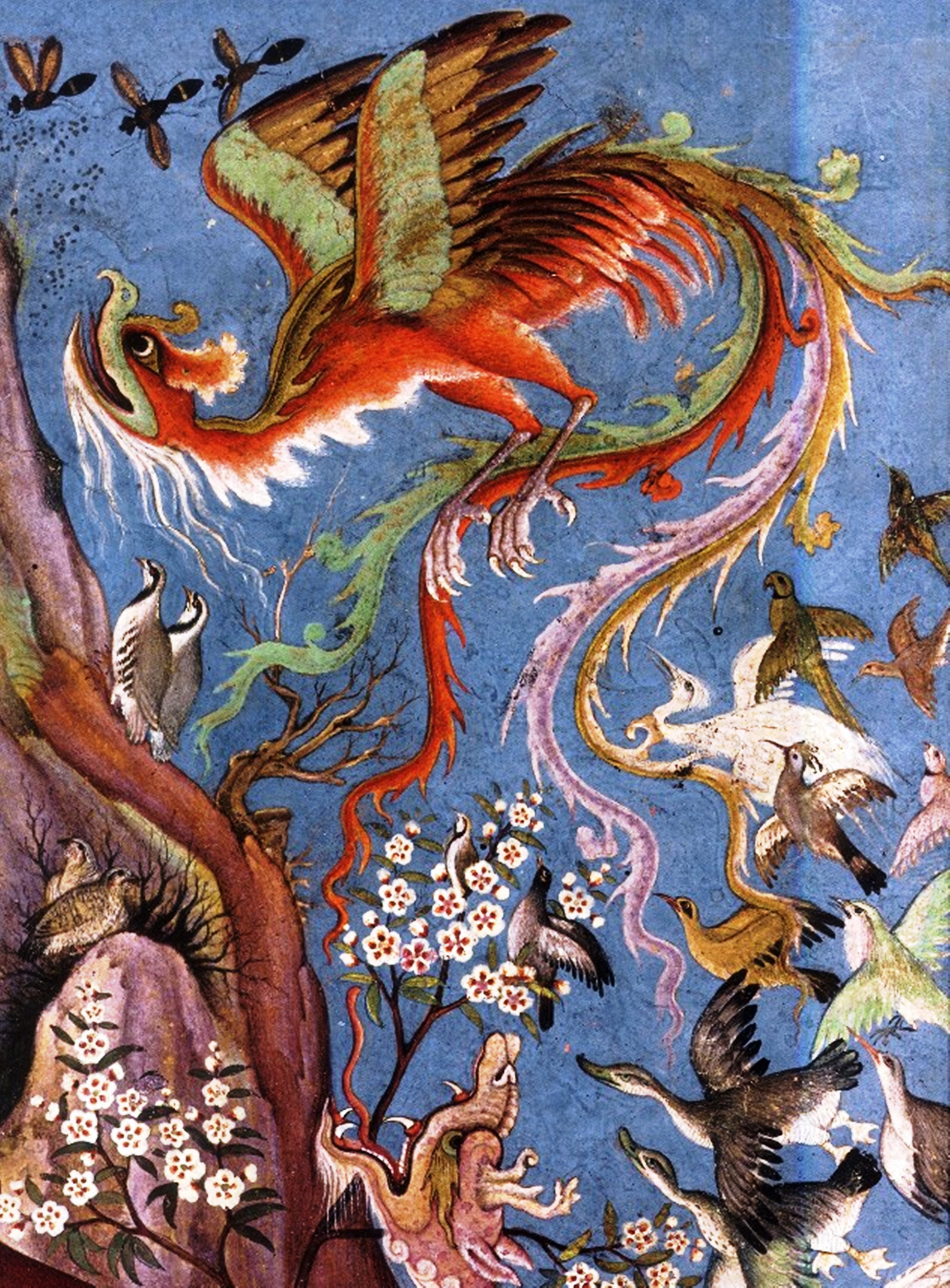
Sultan Valad recommended to his disciples to imagine “the Essence of God like spring”. Ansari (1006-1089) says of God’s vision that it is a spring regeneration of the soul: “The spring of my heart is in the meadow of Your encounter. It is at the spring equinox, writes Sohravardi, that King Key Khosrow held the Grail “facing the sun,” and in the light of the star “the lines and imprints of the worlds were manifested there.” .
 Nezâmî associates with the spring awakening of nature the idea of spiritual immortality (the Source of life) and of an unchanging esotericism (always green), represented by Khidr, mysterious character mentioned by the Qur’an and sometimes identified to Biblical Elijah: “Then, like Khidr Verdoyant, Immortal Prophet, The grass regained youth! Then the water recovered Source of life! “Daqiqi, a poet of the 10th century, exposed in a few verses the symbolic corollaries of spring, woman and paradise:” A paradise cloud, O my idol, has thrown an April parure on the earth. The rose garden in the Garden of Eden is the same, the tree is a hedge covered with ornaments. ”
Nezâmî associates with the spring awakening of nature the idea of spiritual immortality (the Source of life) and of an unchanging esotericism (always green), represented by Khidr, mysterious character mentioned by the Qur’an and sometimes identified to Biblical Elijah: “Then, like Khidr Verdoyant, Immortal Prophet, The grass regained youth! Then the water recovered Source of life! “Daqiqi, a poet of the 10th century, exposed in a few verses the symbolic corollaries of spring, woman and paradise:” A paradise cloud, O my idol, has thrown an April parure on the earth. The rose garden in the Garden of Eden is the same, the tree is a hedge covered with ornaments. ”
 The meaning of spring is deduced from its characteristics: after the “sour face” of winter, before the burning of summer and the opposite of autumnal nostalgia, it is a renovation and a transfiguration. More than the cyclical return of a bloom, it is the miracle of the existence arisen from the “winter nothingness”, just as the oasis is the drunkenness of a desert touched by a gift of God. His explosions of colors and scents embody the movement of joy, the expansiveness of Love, the expressive sap of God and the alchemy of a revelation. Spring is also the fulfillment of a promise: that of paradise after the “winter” ordeals of earthly life or after the autumnal sadness of the separation between the soul and God. Read more here
The meaning of spring is deduced from its characteristics: after the “sour face” of winter, before the burning of summer and the opposite of autumnal nostalgia, it is a renovation and a transfiguration. More than the cyclical return of a bloom, it is the miracle of the existence arisen from the “winter nothingness”, just as the oasis is the drunkenness of a desert touched by a gift of God. His explosions of colors and scents embody the movement of joy, the expansiveness of Love, the expressive sap of God and the alchemy of a revelation. Spring is also the fulfillment of a promise: that of paradise after the “winter” ordeals of earthly life or after the autumnal sadness of the separation between the soul and God. Read more here

- Easter Should Be A Time For Christians And Muslims To Bond
For the Sufi mystic and poet Jalaluddin Rumi, spring was more than spring: it was a reflection of all that was divine, in our lives and history.

In his poem, “Spring is Christ,” he writes of how a flower is more than a flower, a tree more than a tree and the wind more than just wind. He writes of a love so strong it permeates everything it comes into contact with. And he writes about Jesus and his mother, Mary: Jesus as the spring that brings plants into bloom after a lifeless winter, and Mary as the tree that gives life, refuge and shade:
Everyone has eaten and fallen asleep. The house is empty. We walk out to the garden to let the apple meet the peach, to carry messages between rose and jasmine.
Spring is Christ,
Raising martyred plants from their shrouds.
Their mouths open in gratitude, wanting to be kissed.
The glow of the rose and the tulip means a lamp is inside.
A leaf trembles. I tremble in the wind-beauty like silk from Turkestan.
The censer fans into flame.
This wind is the Holy Spirit.
The trees are Mary.
Watch how husband and wife play subtle games with their hands.
Cloudy pearls from Aden are thrown across the lovers,
as is the marriage custom.
The scent of Joseph’s shirt comes to Jacob.
A red carnelian of Yemeni laughter is heard
by Muhammad in Mecca.
We talk about this and that. There’s no rest except on these branching moments.
– Jalaluddin Rumi, from The Essential Rumi, by Coleman Barks
Ya Haqq!

Surprisingly for many in the West today, Islamic mystical poetry is full of allusions to Jesus and Mary. The only religion besides Christianity that accepts Jesus as a prophet, Islam confirms his unique birth and the Qur’an refers to him as the “Messiah,” the “Messenger,” the “Prophet” and the “Word and Spirit of God.”
It is a commonality that is often overlooked by fundamentalists on both sides who choose to focus on the points of divergence. And yet, at this moment, when so many seem to be rooting for a collision between the Christian West and Islamic East, there has never been a greater need for both sides to acknowledge their shared heritage.
Easter has always reflected a universal renewal of life, hope and faith. It’s a renewal of this very faith, one that Rumi wrote about in the 13 century, that so many of us could do with today.
For Muslims, there are two ways to look at Jesus: the literal and the metaphorical. Literally, the position of Jesus is very clear: he was a prophet of God. All Muslims are therefore commanded by their religion to respect and revere him and to learn from his life, his teachings and the sacrifice he made.
Metaphorically, one need only look at Sufi poetry to see how deeply engrained the story of Jesus is into the Islamic mystical tradition. As Dr. Javad Nurbakhsh writes in his book, Jesus In The Eyes of The Sufis, there is “scarcely a Sufi poet who has failed to cite Jesus in his verse.”
The elevated status of Jesus in Islamic spirituality represents the relevance of his sacrifice and willingness to suffer for a cause most did not recognize.
Rumi tells the story of Mary, the lovely virgin who on her labour pangs came to a dried up palm tree. When she clung to its trunk, it showered sweet dates over her. It was her pain that led her to the tree and caused the barren plant to give forth fruit.
Rumi writes:
The Body is Like Mary
The body is like Mary, and each of us has a Jesus inside.
Who is not in labour, holy labour? Every creature is.
See the value of true art, when the earth or a soul is in
the mood to create beauty;
for the witness might then for a moment know, beyond
any doubt, God is really there within,
so innocently drawing life from us with Her umbilical
universe – infinite existence …
though also needing to be born. Yes, God also needs
to be born!
Birth from a hand’s loving touch. Birth from a song,
from a dance, breathing life into this world.
The body is like Mary, and each of us, each of us has
a Christ within.
– Mevlana Jalaluddin Rumi
“The body is like Mary. Each of us has a Jesus, but as long as no pain appears, our Jesus is not born. If pain never comes, our Jesus goes back to his place of origin on the same secret he had come, and we remain behind, deprived without a share of him.”
Another Sufi poet, Fariduddin Attar, writes:
“If for only a moment you free yourself
From this prison around you,
You will be like Jesus,
Unique in detachment.”
The elevated status of Jesus in Islamic spirituality represents the relevance of his sacrifice and willingness to suffer for a cause most did not recognize. What we learn from his life is that faith conquers all; not just the anguish of the moment but, eventually, time and space.

The larger lesson, however, is more than faith being able to move mountains; it’s that Islam and Christianity are not mountains apart. They share a deep heritage based in love, one that is not to be confused with the actions of some misguided, fire-breathing followers — on both sides of the fence — who spread misinformation in their desire for division.

There is a famous account of the time when Prophet Muhammad entered Mecca in triumph. As is well known, he ordered the destruction of all idols and images. What is not well known is the tradition that when he came upon a picture of the Virgin and Child inside the Kaaba, he covered it with his cloak out of reverence, ordering it to be preserved outside the Kaaba as sacred.
The Secret of April’s Rain,
“We all know that the Lord of Heavens created four seasons on Earth, and of those seasons, spring is known for its rain; there is something very special and valuable about spring rain which falls in March, April and May. Yet the most precious month of spring is April, and there is wisdom and reasons for that month being so special. It has been selected to have such a quality because the Seal of the Prophets ﷺ, the Most Beloved One for whose honor all was created, was born in April!

Heavenly knowledge reaches some special, chosen and selected people, and it has also reached through Grandshaykh (qs). Knowledge that April rain is special is hidden knowledge and it carries hidden treasures that are hidden wisdoms. Of the twelve months April is so beloved and hence, the most valuable treasures are granted in that month. In April, the Lord of Heavens sends a special and blessed rain from the heavens; such rain that reaches Earth and gives it new life. If it did not rain in April, the Earth would dry out and nothing more would grow on it.
It is well known to heavenly, holy people that blessed April rain comes from under the Holy Throne. If one drop of that blessed rain falls onto the earthly rain clouds, all that rain takes baraka, blessings from it, then that rain gives new life to everything! It changes them and takes terrible burdens from everything, particularly from Man. And whoever knows that secret wisdom will stand under that rain, allowing it to completely touch their bodies. When those drops of April’s rain falls, even the fishes in the oceans come up, opening their mouths to reach just one drop of that blessed rain and waiting at the ocean’s surface. Allahu Akbar, all of creation is waiting to reach those Divine Waves of Mercy!” Mawlana Shaykh Nazim an Naqshbandi

Spring showers: A healing ritual in Anatolian culture
‘Rain nurtures with its fresh, reviving spray,’ wrote Rumi in his famous poem ‘Masnavi.’ Among Sufis, spring showers are believed to have healing power and foster abundance and different traditions have been kept alive for years. Some of the interesting traditions in Anatolian villages include collecting raindrops in bowls and making yogurt with the water
According to mythical beliefs, an oyster patiently waits for raindrops in the spring to create a pearl. Obviously, this is not the way that a pearl is created; however, it clearly represents the miracles that April and May spring showers bring. For hundreds of years, spring rainfall has been considered to have special healing powers. This is why it is also considered to be a sacred gift. You may come across similar metaphors in poetry, especially while reading Persian or Anatolian poetry. World-renowned poet Mevlana Jalaladdin Rumi, one of the most prominent poets of Islamic culture and history, wrote about the benefits of spring showers in his lengthy poem “Masnavi.” “Rain nurtures with its fresh, reviving spray. But also causes ruin and decay. The rain in spring is wonderful, it makes things grow. Fall rain is like a fever, though; The former nurtures tenderly like breath, while the latter makes things sick and pale as death,” Rumi wrote. He also refers to the phrase “Take advantage of the coolness of spring” from a hadith by Prophet Mohammad in “Mathnawi” with the following lines: “The prophet told his friends once ‘Please beware; don’t cover up yourself against spring air because your soul will gain from that pure breeze that does to it what spring does to the trees. But you must flee fall cold instead, for it will leave you like these gardens: Dead.'”
In fact, Sufis at one point collected April raindrops as they fell, using a special vessel called a “nisan tası” (April bowl). They then served this water to guests and sprinkled it on dry land with the purpose of healing and fostering abundance. To this day, Anatolian people still preserve water from spring showers for the same reason and have kept this tradition alive for many centuries.

Assistant Professor Nuri Şimşekler, the director of the Mevlana Research Institute at Selçuk University, said the tradition of “Ab-ı Nisan” (April Water) involves collecting the raindrops that fall between April 21 and May 21. Today, you can still see April bowls that have been preserved for centuries in the Mevlana Museum in Konya, especially the bowl that was made in Mosul on the order of Ebu Said Bahadır Khan, the last emperor of the Ilkhanids, in the 14th century for Rumi’s tomb.
Similar traditions were adhered to during the Ottoman Empire as well. The servants at the imperial palace used to collect the first drops of spring rain in bowls and present them to the sultan who awarded them with thousands of “akçe” (Ottoman coins). Today, you can see April bowls displayed at Topkapı Palace in Istanbul.

People would keep the leaves of the bay tree and the olive tree that are washed in April rain give the leaves to each other as a token of well wishes for a blessed year. Anatolian people would also make yogurt from the spring rain water. Spring showers are considered sacred and healing, both traditionally and metaphorically, but what does science have to say about the rain? Do these mystic traditions bear any weight in the scientific realm?
According to scientific studies, the awaking of nature in the spring allows pollen, colophons and the essential plant and tree oil to be released into the atmosphere through the wind. So, precipitation allows these particles to reach the soil. Spring rain is very beneficial when drank and is useful for myriad purposes as they include such particles.
Scientists also state that since the spring rains include iron, it is good for those with an iron deficiency. Scientists suggest people measure the level of iron in their blood before getting soaked by spring rain and measure it again afterward to see any difference in iron levels of their blood. Furthermore, it is not possible under normal circumstances to make yogurt with water but since the spring rain includes lactic acid and bacteria, fermentation is possible.
With a little sunlight, rain and warmer soil, it is rather amazing that spring has the ability to awaken plants and trees from months of hibernation, while colorful flowers bloom and pop up on every corner. Indeed, the old saying that “April showers bring May flowers” is a true one. Istanbul welcomes numerous spring flowers like erguvan (Judas tree), magnolias, acacias, hyacinths, narcissus, mimosas and wisterias as the harbingers of spring. For rain lovers, I highly recommend walking under the spring showers these days and getting wet to benefit from the blessing of God while listening to the sound of nature. If this does not appeal to you, at the very least, I recommend that you take a moment to sit under a metal roof and experience relaxing moments listening to the trickling of rain.
See also: Jesus and the Sufi Traditon
Jesus – The Paradigm of a Pilgrim in God according to Ibn al-ʿArabi
Jesus, Mary and the Book, according to Ibn al-ʿArabi
Jesus in the Quran: an Akbari Perspective
THE ELIATIC FUNCTION IN THE ISLAMIC TRADITION: KHIDR AND THE MAHDI



